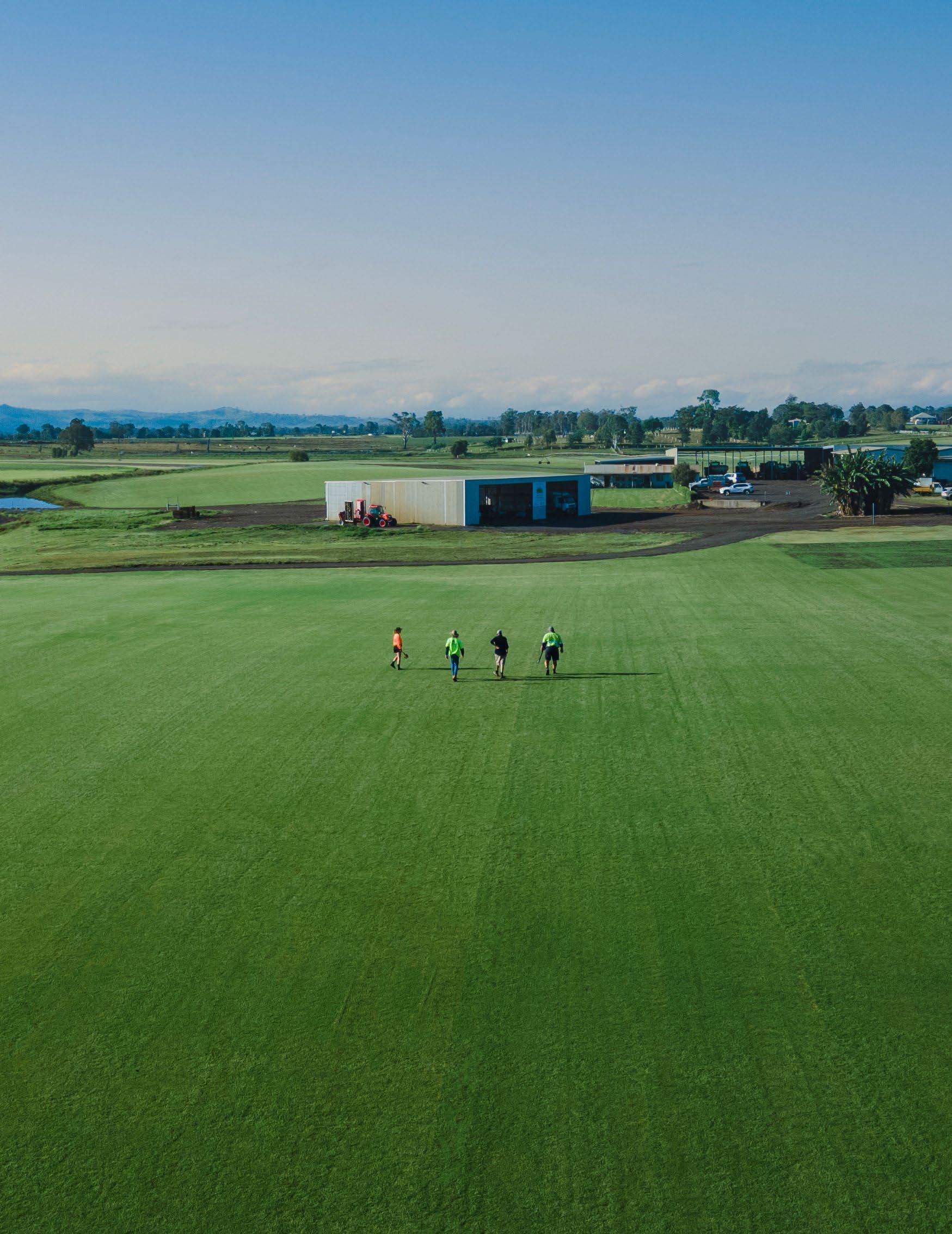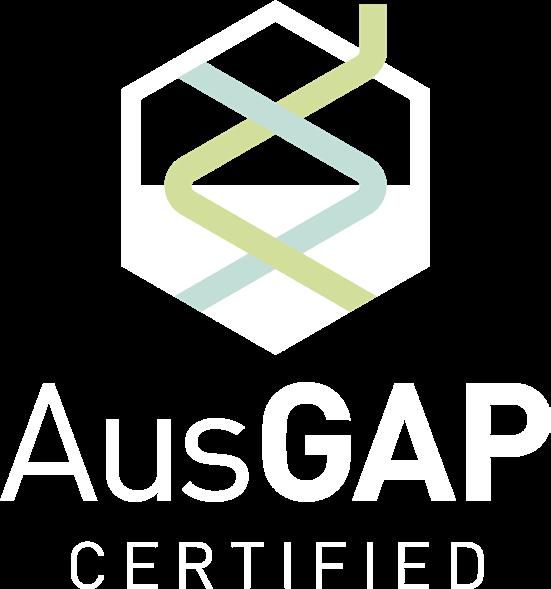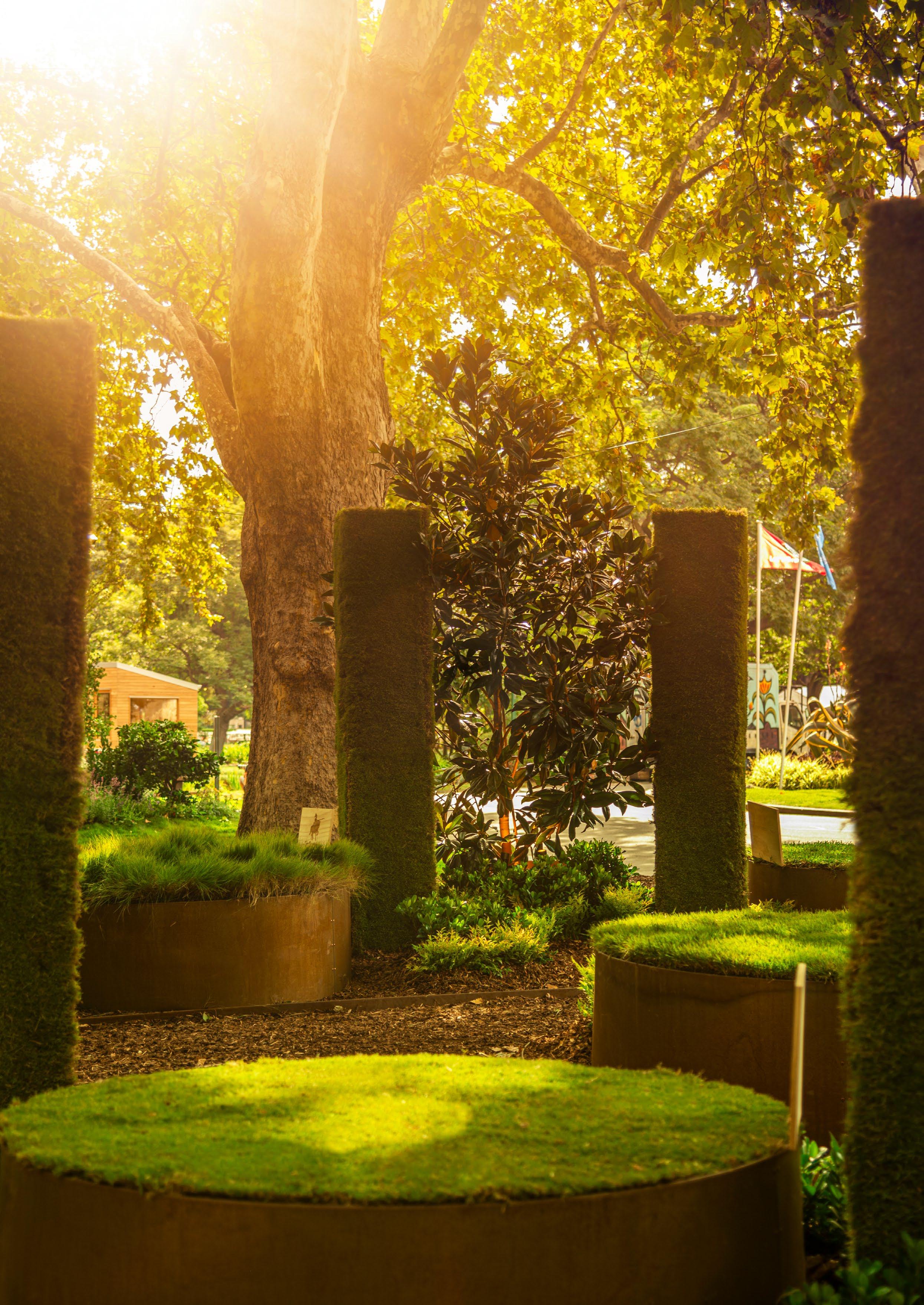 BY LAWN SOLUTIONS AUSTRALIA | JULY 2024
BY LAWN SOLUTIONS AUSTRALIA | JULY 2024














 BY LAWN SOLUTIONS AUSTRALIA | JULY 2024
BY LAWN SOLUTIONS AUSTRALIA | JULY 2024













Australia’s most comprehensive turf magazine. Turf Talk is suitable for all turf professionals, from turf growers to landscapers, golf courses and sports ground curators, to government and related industry organisations.
Turf Talk is here to share with you the latest information on the turf industry, the exciting developments in turf research and to keep you up to date with everything you need to know about turf.
Turf Talk is a free magazine, distributed to over 3,000 landscape and turf professionals.
Turf Talk is published by Lawn Solutions Australia. For any enquiries, submissions or to subscribe to our digital edition please contact us at news@turftalk.org.au

LAWN ROOFS, LETTERBOXES, PILLARS AND EVEN CHAIRS AT THE MELBOURNE INTERNATIONAL FLOWER & GARDEN SHOW 2024
Staged at the world heritage-listed Royal Exhibition Building and Carlton Gardens from the 20th to the 24th of March, this year’s Melbourne International Flower and Garden Show was an incredible experience. Over 107,000 people came through the gates across the five days, with a huge number of people converging on Melbourne for the Show and in some cases the Australian Formula 1 Grand Prix as well.
The Show features the best talent in landscaping, gardening, and floral design
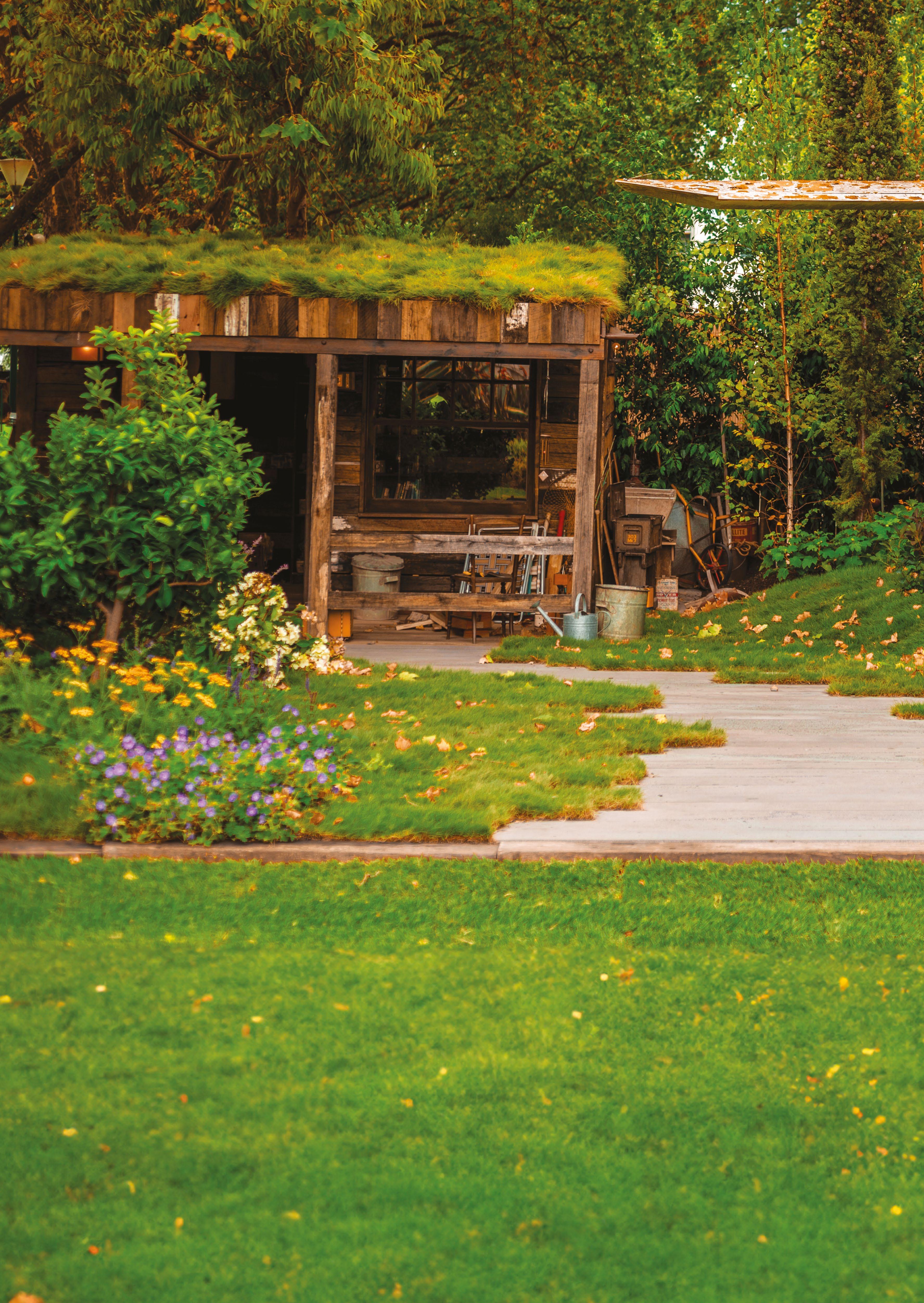
from right around Australia each year. With a large range of exhibitors showcasing their garden products and innovations.
Lawn Solutions Australia (LSA) featured prominently at the Show promoting the LSA network of turf suppliers and their range of premium lawn varieties. LSA turfgrasses were featured heavily across the world-class display gardens, showcasing their versatility to be used across a variety of spaces and designs. LSA members and staff, including ambassadors Charlie Albone and Jason
Hodges, experienced an incredible number of enquiries and interactions throughout the week, handing out thousands of turf information guides and answering a range of lawn-related questions.
Lawns are such an integral part of the environment and gardens, and it was great to see how interested the public is in using the different turfgrass options available in a range of locations and spaces. The impressive artistry on show throughout the display garden entries exemplified the versatility of
grass and how it can be used as a feature component within a variety of landscapes.
The Lawn Solutions Australia Lawn Display Lawn Solutions Australia has enjoyed being an exhibitor and presenting partner at the Melbourne International Flower & Garden Show for many years.
This year’s lawn display was simple yet striking with Charlie Albone and the team at Venus Landscaping designing and building the display over the week leading into the start of the event.

Lawn Solutions Australia ambassadors Jason Hodges and Charlie Albone, both very talented landscapers and previous winners at the show, were very excited to be involved and actively promoting the use of turf on the Lawn Solutions Australia stand throughout the week. Charlie and Jason both also conducted presentations to the crowds throughout the week, sharing their knowledge on all thing’s lawns and gardens. Charlie was filming with Better Homes and Gardens during the week with the Show being a regular feature episode for each series.
The Show is renowned for the intricate display garden builds installed by Australia’s leading landscape architects and designers. Lawn Solutions Australia’s lawn varieties were featured heavily throughout these installations and played an important role in bringing the designs together. Lawn Solutions Australia Member Lilydale Instant Lawn supplied top-quality turf for many of these gardens, working closely with the talented landscape teams throughout the process. There are many categories and awards given to each
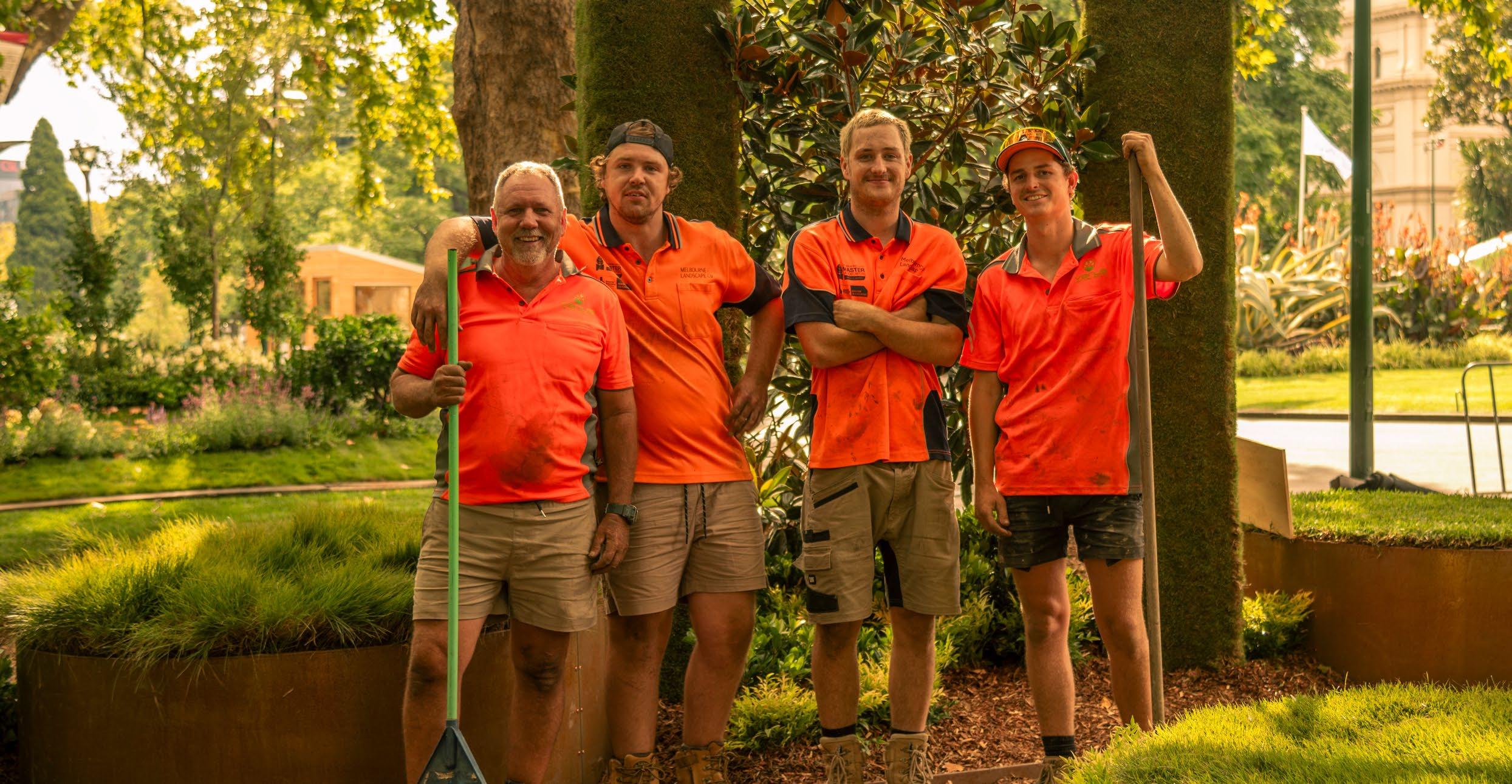
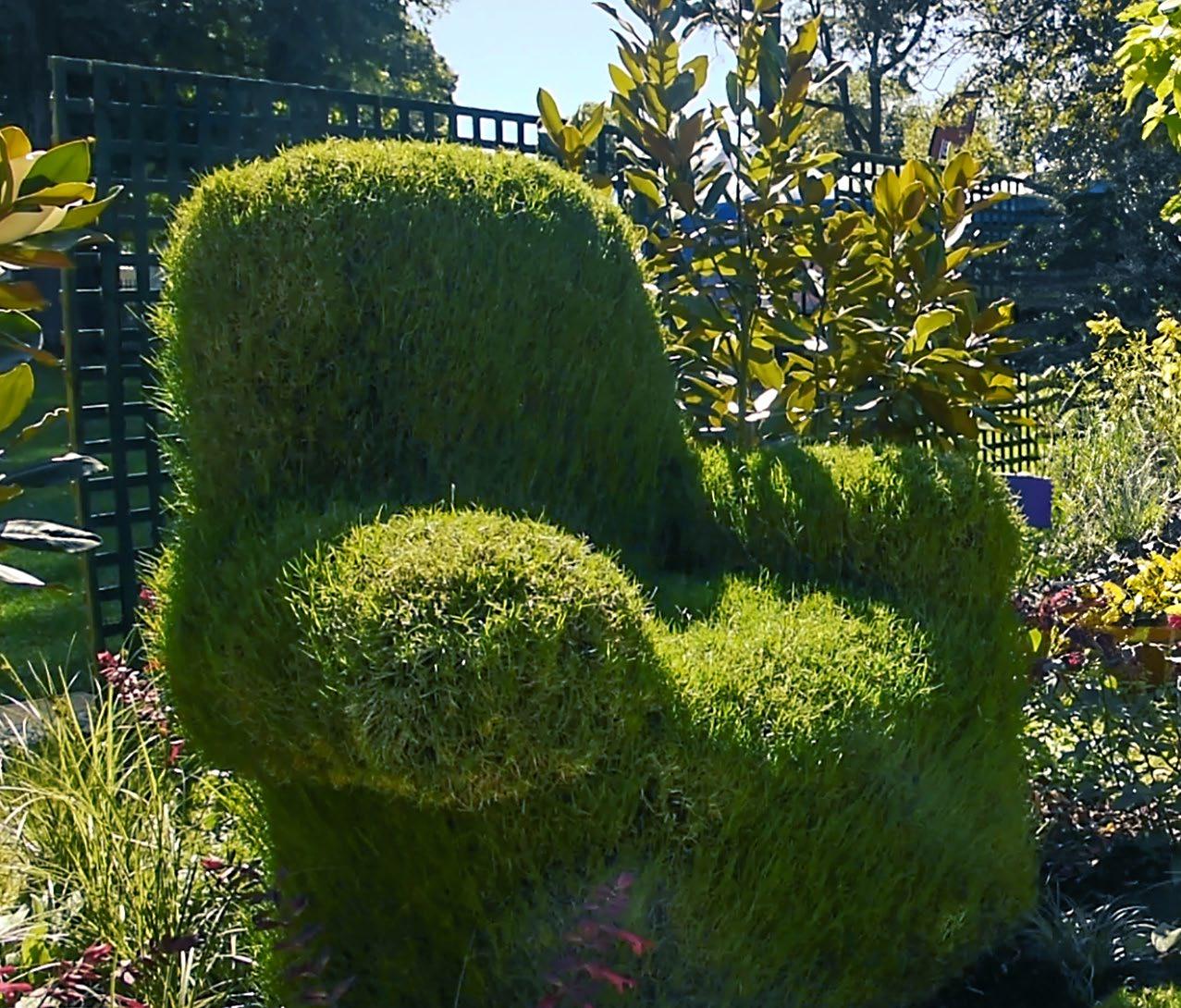
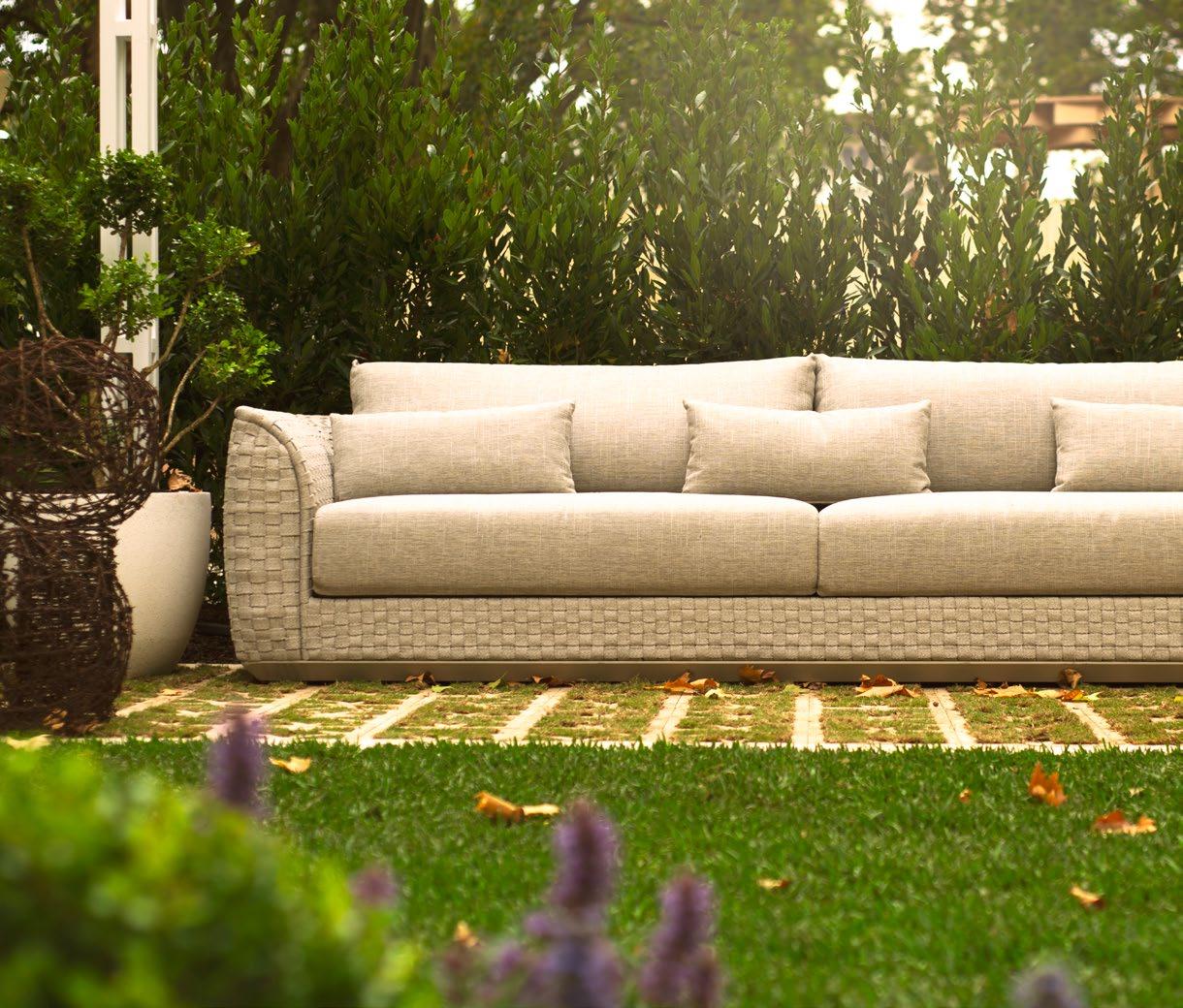
year’s builds, with one particular entry to be awarded ‘Best in Show.’ This year’s winner was impressive to say the least…
Winner of Excellence for Best in Show Award
“Through the Looking Glass” was designed & constructed by Emmaline Bowman, the owner of STEM Landscape Architecture & Design and Liam Riley, of ID Landscaping Design & Construction.
The display garden was inspired by rural Australia through a sustainable lens, with
the duo’s design prioritising minimal impact and celebrating the beauty of nature’s hidden world.
Winner of the People’s Choice Award
The people have chosen! This year’s People’s Choice Award was given to Peter Donegan and Semken Landscaping for their garden ‘A Moment In Time.’
‘A Moment in Time’ features a retired Piper PA-28 Cherokee plane, a grass roofed wood cabin and a winding path surrounded by
lush Sir Grange Zoysia supplied by Lilydale Instant Lawn. The design set in the 1980’s intends to highlight the difficulties veterans face when returning to their former lives.
The Stimming Garden by Valley Care featuring a ‘TifTuf’ Garden Chair 2024 saw the return of the Border Garden Competition, this exciting competition is a platform to help emerging garden designers and experts show what is possible to achieve in a tiny space with a sole focus on plants.
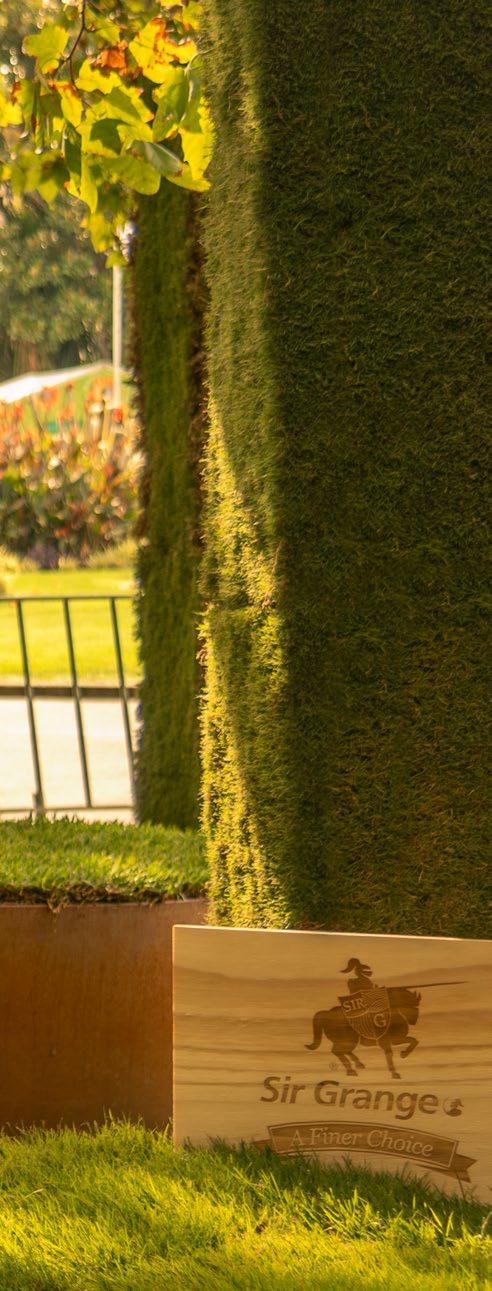

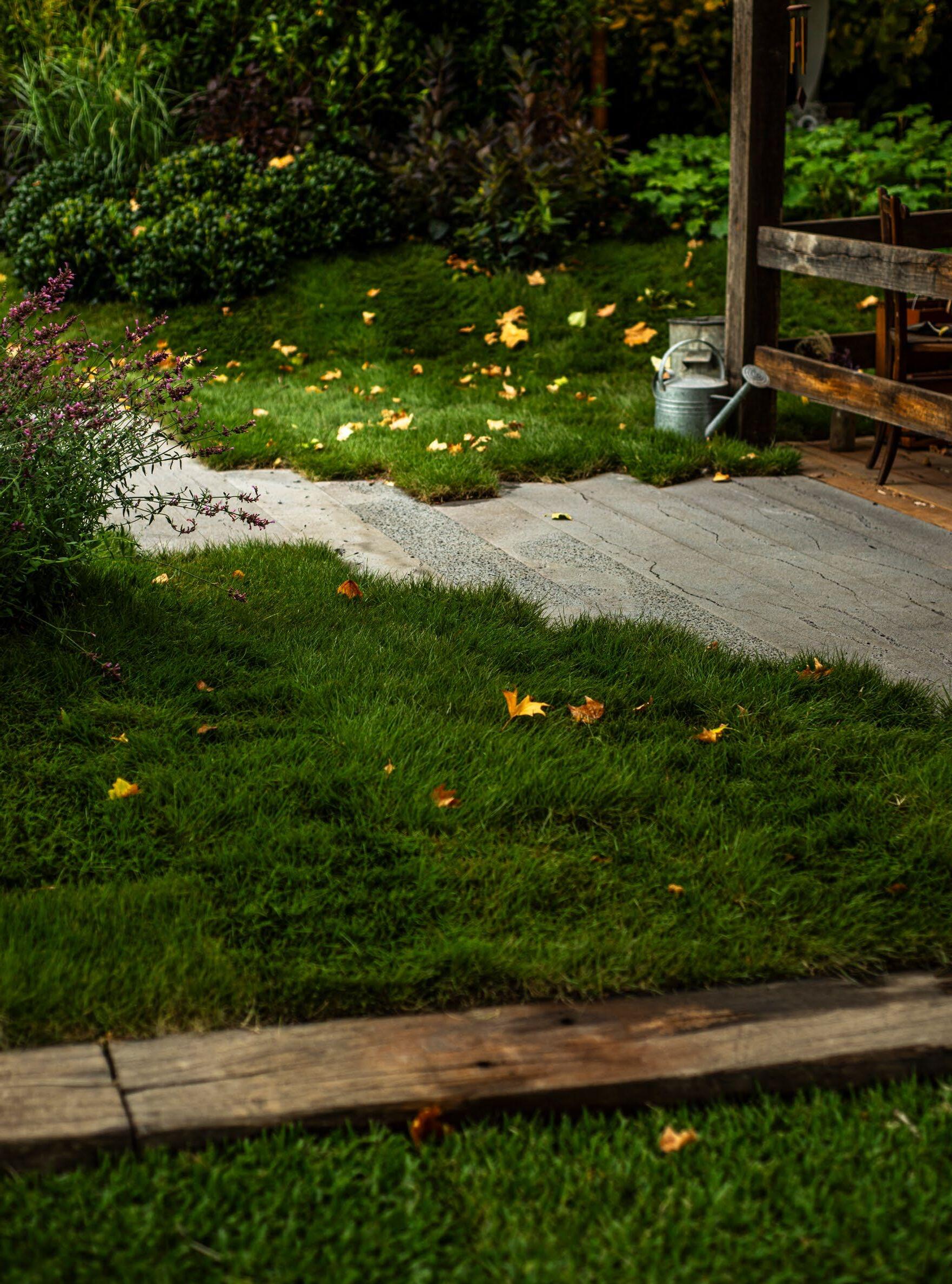
This year, Valley Care created the “Stimming Garden” to share what it’s like for people with Autism Spectrum Disorder and explore the ASD Brain.
The staff came up with a design that incorporates a TifTuf Hybrid Bermuda grasscovered chair in the middle of the garden with plants representing the staff’s feelings around work and their disability.
The Welcome Garden by Jason Hodges
The Welcome Garden is a place for visitors
to relax at the show and participate in the various talks from top designers and growers. This year’s Welcome Garden is Jason Hodges’s take on the modern Australian backyard with a focus on simplicity, a sanctuary that every visitor to this year’s show could imagine elements in their gardens.
Relaxed and low maintenance with a lush green Sir Walter DNA Certified lawn underfoot that connects us straight away
with nature and some TifTuf Hybrid Bermuda between Breeze Blocks used as pavers.
If you have never had a chance to visit the Show, we implore you to do so next year, which is sure to showcase turf in a variety of spaces once again.
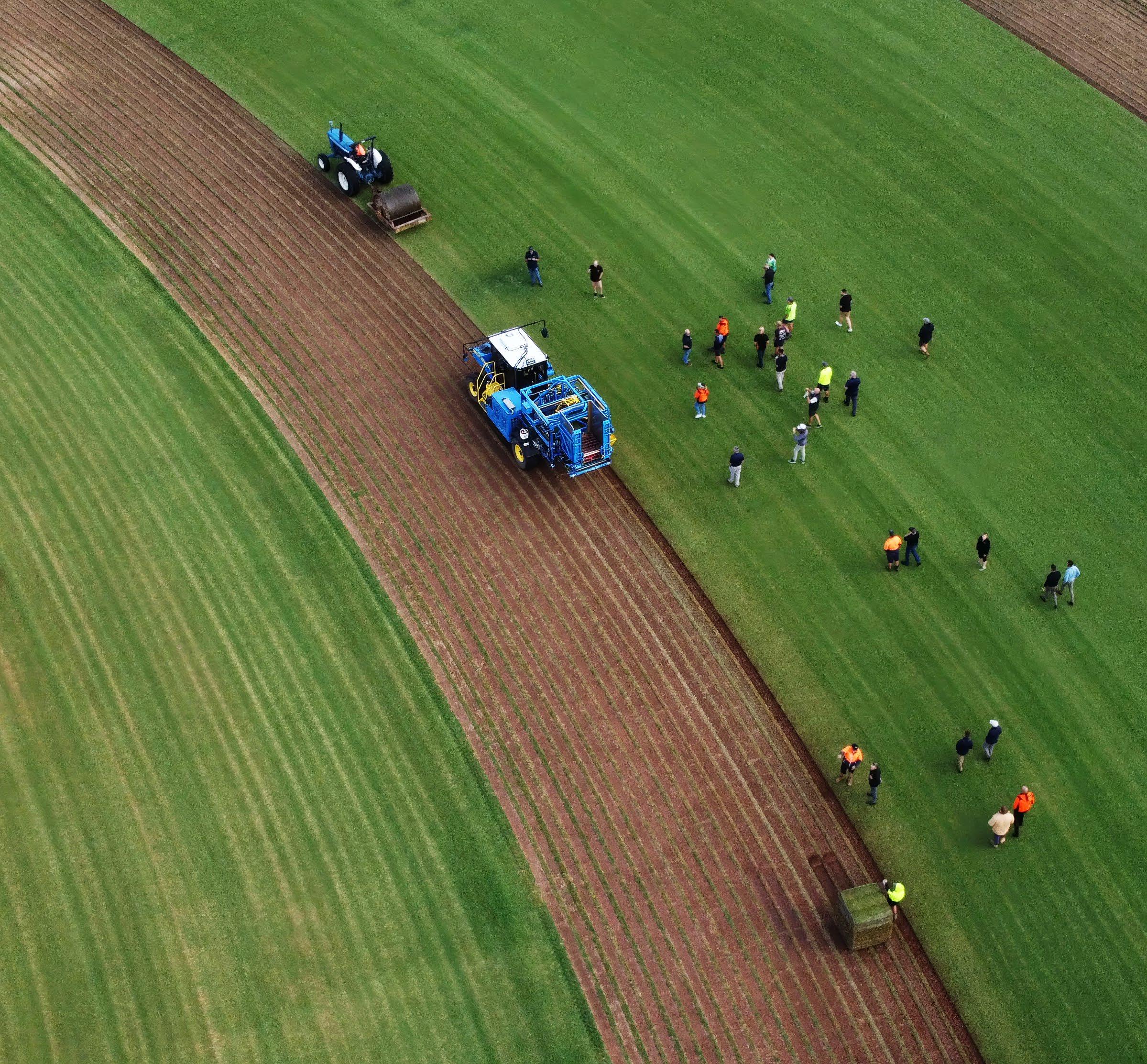
On the 18th & 19th of March, turf industry professionals from Turf Management South Australia (TMSA) travelled to Bordertown for a two-day forum including 18 holes of golf, a presentation dinner, and a tour of Sunnyside Instant Lawn.
Located in the heart of the Tatiara, known as “the good country” – a 3-hour drive east from Adelaide, the attendees were treated to some true country hospitality. The tour focused on the community’s passion for the local golf course and expanded their knowledge of sustainable and innovative turf practices.
The Bordertown Golf Course is 5,162 metres in length with 18 holes and fully watered greens and fairways, which provide a lush green course throughout the year. The course is maintained by many of the members, who volunteer their time, and is surrounded by numerous gum trees and native scrub, bird life and kangaroos. There are five par 3’s, four par 5’s and the remainder par 4’s.
With the round of golf completed in sensational weather, over 50 people gathered at the Bordertown Golf Course Clubhouse for the TMSA presentation
dinner with guest speakers. Nathan Bennett (TMSA President and North Adelaide Golf Club Superintendent) introduced three industry-leading guest speakers – Simon Adermann (Lawn Solutions Australia), Daryl Sellar (Agronomist, Living Turf) and Michael Sutton (AusGAP).
Simon Adermann spoke about the increase in demand for sports turf playing surfaces and the results of the latest STRI research data. Daryl Sellar spoke on best practice turf management and shared information from the Kangaroo Island turf trials and the
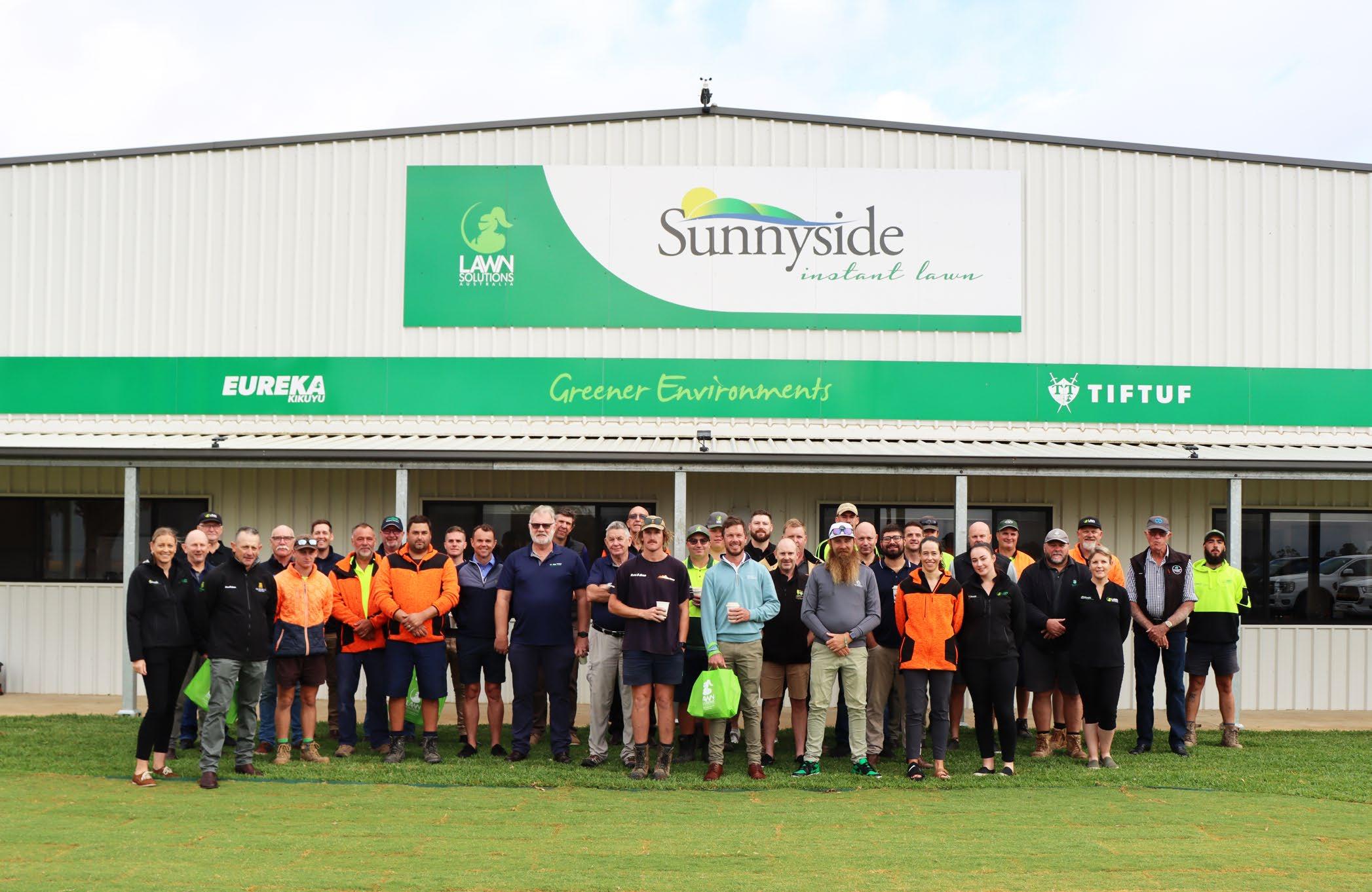

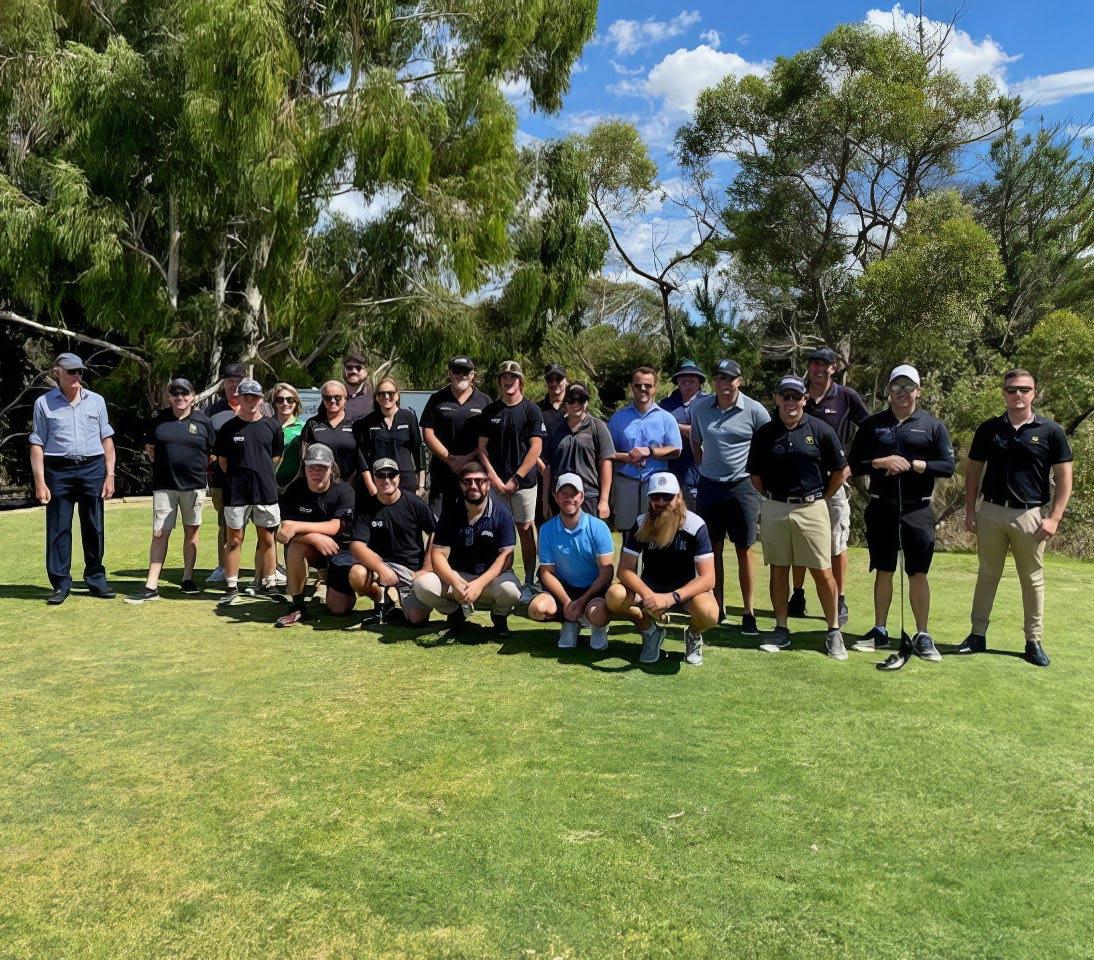
Burnside Primary School TifTuf playing field. Michael Sutton spoke about the importance of AusGAP assurance when purchasing turf.
The following morning started with a BBQ breakfast at Sunnyside Instant Lawn and then buses transported the group around the turf farm where “the sheer size and technical advancements were impressive to see”. Sunnyside offered an insight into their business practices, the production process, and shared extensive comparisons of the five turf varieties grown on farm. The opportunity was then taken to walk on the acres of
freshly mowed TifTuf Hybrid Bermuda and experience the product firsthand, gaining a better understanding of the growth characteristics, the on-farm production process and the machinery used on farm.
All attendees agreed that the experience of getting a behind-the-scenes look at turf farming was extremely beneficial. As Simon Adermann explained, “…the production process is a rarity in the day-to-day process of industry professionals”. Andrew Rowett, owner and manager of Sunnyside Instant Lawn was extremely proud to host the
tour and believes, “This was a fantastic opportunity for Sunnyside to demonstrate the process of producing AusGAP Certified turf & to discuss the benefits of using TifTuf for sports fields and other applications.”
Sunnyside would like to extend its appreciation to TMSA, its members and industry colleagues for the opportunity.

Why Sir Grange Zoysia is the Perfect ‘Contaminant Free’ Ground Covering
In light of increasing reports of Asbestos being found in contaminated woodchips and bark material across various public space areas, we must identify superior contaminant-free, safe solutions and alternatives for these areas.
Woodchips, mulch and other mediums like sand are often used in playgrounds and
swing areas as a low-maintenance ground covering, but they rarely stay clean and userfriendly for very long and have been found to suffer from asbestos contamination. This is highly concerning when there is a much better ground covering that could be used, a green and low-maintenance solution that is free of contaminants and safe for our families and environments.
This turf variety is Sir Grange Zoysia. Sir Grange is a Zoysia Matrella grass that offers
a level of versatility in turfgrass that has been unseen until recent years. It has a stunning fine blade and a beautiful dark green colour. But most importantly, it can be left completely unmown and still look fantastic.
This makes Sir Grange Zoysia the perfect solution to the current asbestos issue.
Woodchips can be removed and replaced with an incredible grass that requires next to no mowing at all, is soft and safe for playgrounds, is much more aesthetically



pleasing and provides the assurance that the new ground covering will be asbestos free.
Often when we think about grass, it’s in the context of a lawn, sporting field or expansive park areas, and Sir Grange Zoysia can certainly be used in these applications. But its areas that we wouldn’t traditionally adopt grass where Sir Grange is truly providing an alternative floor covering and solution for troublesome landscaping areas. Garden beds, playgrounds, median strips, alongside
bike paths and pedestrian footpaths – all of these areas are high maintenance areas for councils to maintain and are commonly filled with woodchips and other materials that requires regular replacement and upkeep. Sir Grange Zoysia can be used in all of these areas providing a much better outcome for councils and for the public.
Sir Grange is great in areas that are difficult to get to for maintenance purposes and can tolerate high wear once established. The
reason this turf requires less mowing is due to it having a very slow growth pattern and limited height of growth. Sir Grange will grow until it reaches a certain height (about 15 to 20cm). After that, it virtually stops growing vertically and looks fantastic.
This makes Sir Grange the ideal solution for public parks and playgrounds, council verges, roadsides, sloping areas, sporting applications like golf courses and in the home lawn and play areas just like this one.
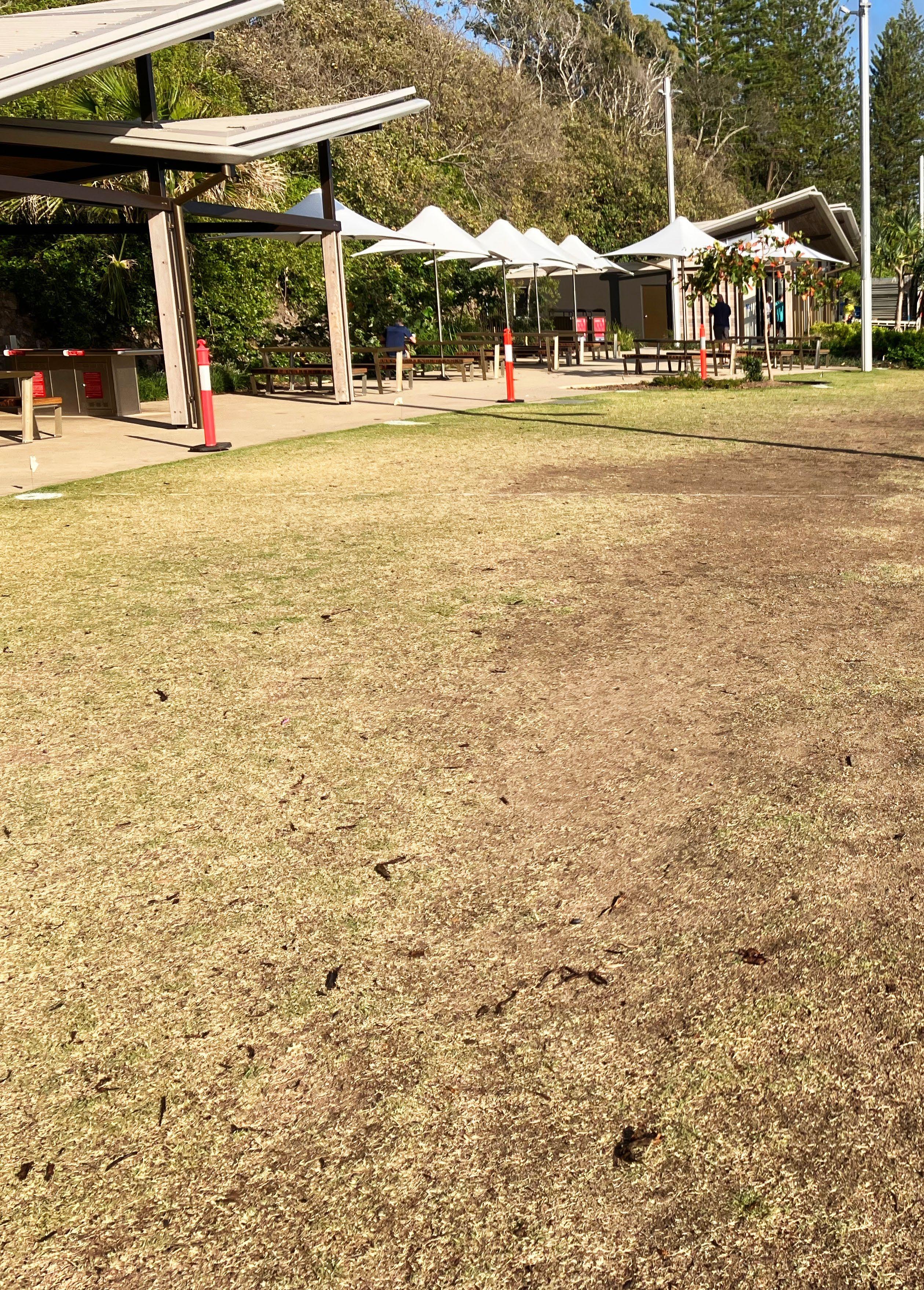
In 2020, the Sunshine Coast Council (SCC) commenced major re-development of the Mooloolaba foreshore.
The Mooloolaba Esplanade Holiday Park was permanently closed to allow for Stage 1, Northern Parkland to take place. This incorporated a raised boardwalk to link Alexandra Headland to Mooloolaba with new community facilities including picnic areas, undercover barbeque areas, a
state-of-the-art playground with sails and hard-covered areas and landscaping.
This stage was completed in June 2022 and was opened to the public. By September 2023, the SCC could see that the turf areas were in major disrepair, and they contacted Daleys Turf located in Bells Creek seeking a solution.
After several onsite meetings, it was decided to replace the old turf with an
improved variety that would suit all the needs the council required for such an area. TifTuf Hybrid Bermuda was the chosen turf variety based on its wear tolerance and that it would handle the punishment of sporting events such as the Mooloolaba Triathlon, the Sunshine Coast Marathon and other fun runs whereby the grassed area can be covered for up to 10 days at a time with temporary infrastructure that is used for these events.
The first challenge was working out how to conduct the work safely and efficiently without completely closing the area off to the public. Access for pedestrians on the Mooloolaba foreshore is via a footpath shared by over 1,000 people daily.
With the assistance of SCC management and their employees, Daleys Turf devised a plan.
The project was to begin once the Queensland school holidays were over,
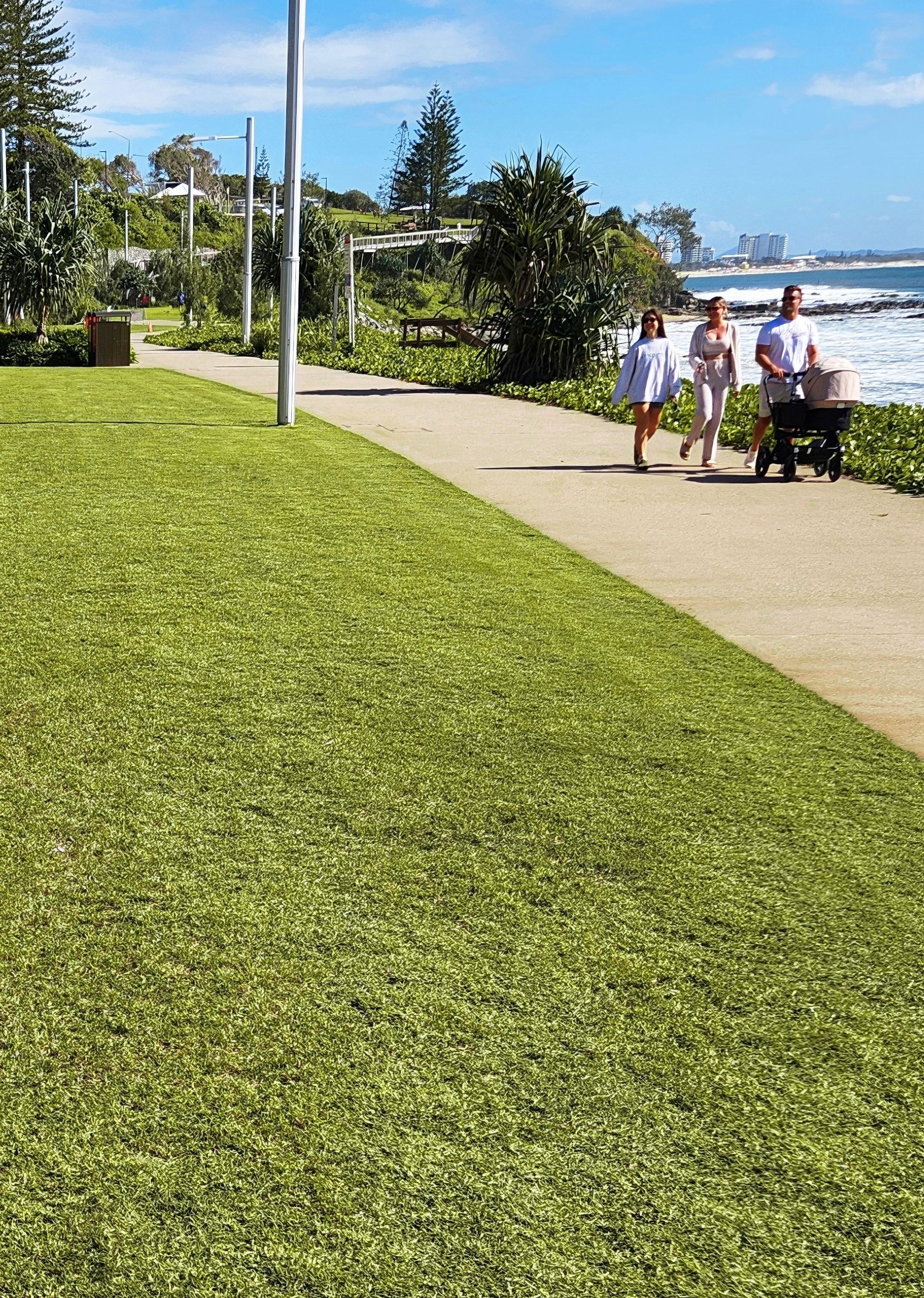
but it needed to be completed 6 weeks before a large event that was booked in November to give the turf time for establishment. It would then be ready to re-open to the public. This only gave the team a 4-day window to complete the job.
Metal safety fencing was erected, then the existing turf and soil were removed, the drainage system was installed, irrigation was upgraded with more stations and
sprinklers added to increase coverage, and then the new sand-based soil was added.
All materials had to be delivered to an off-site location and then re-loaded onto smaller vehicles that could access the shared walkway. Each vehicle was escorted into and out of the site with spotters in front and at the back.
Fifty-five cubic metres had to be removed and the total area of turf to be replaced was 890m2. There were 65 cubic metres of
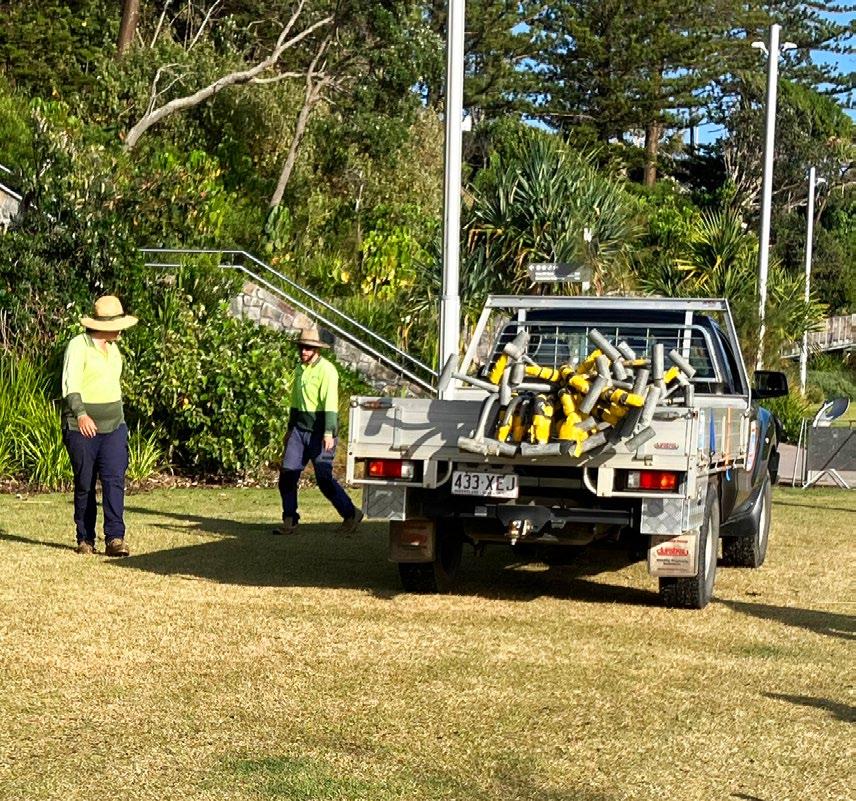
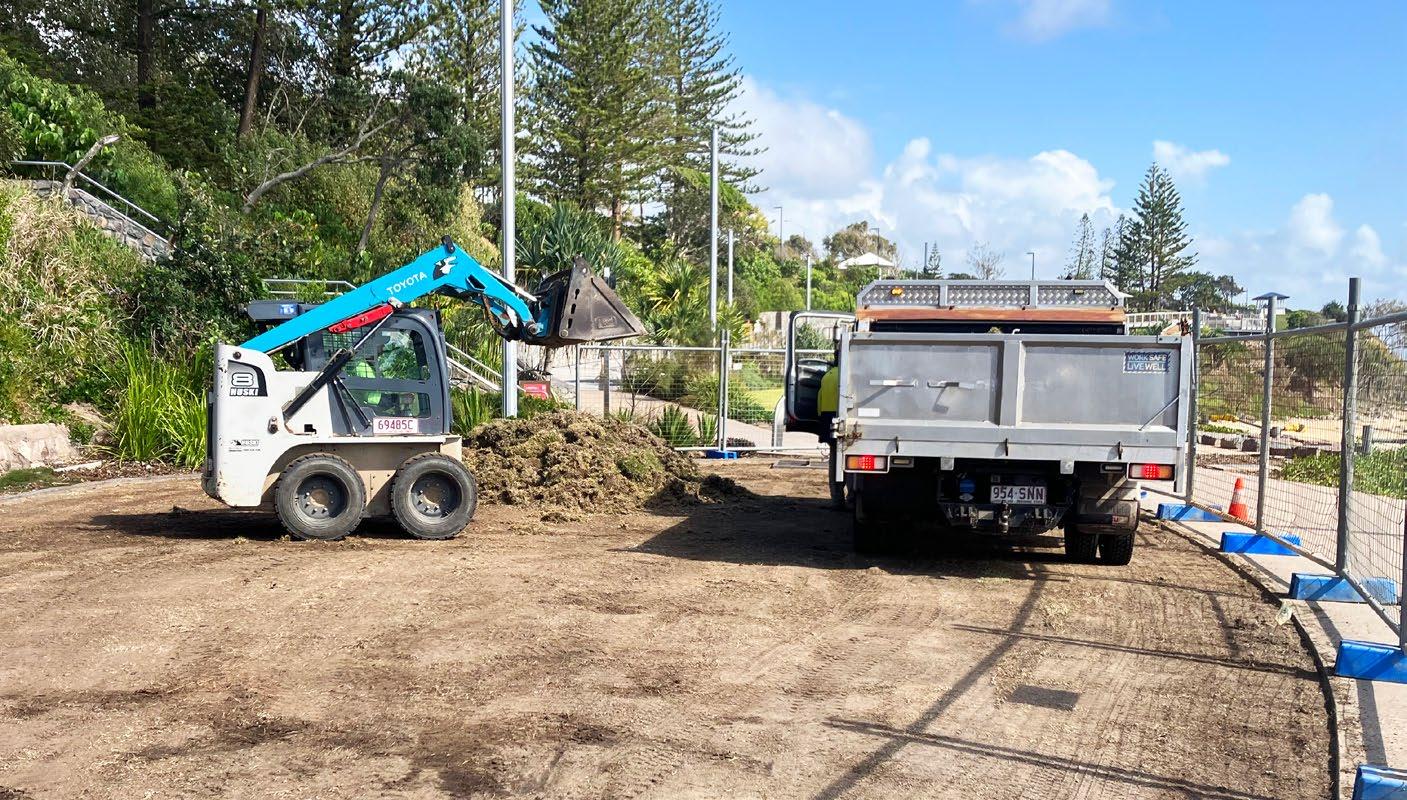
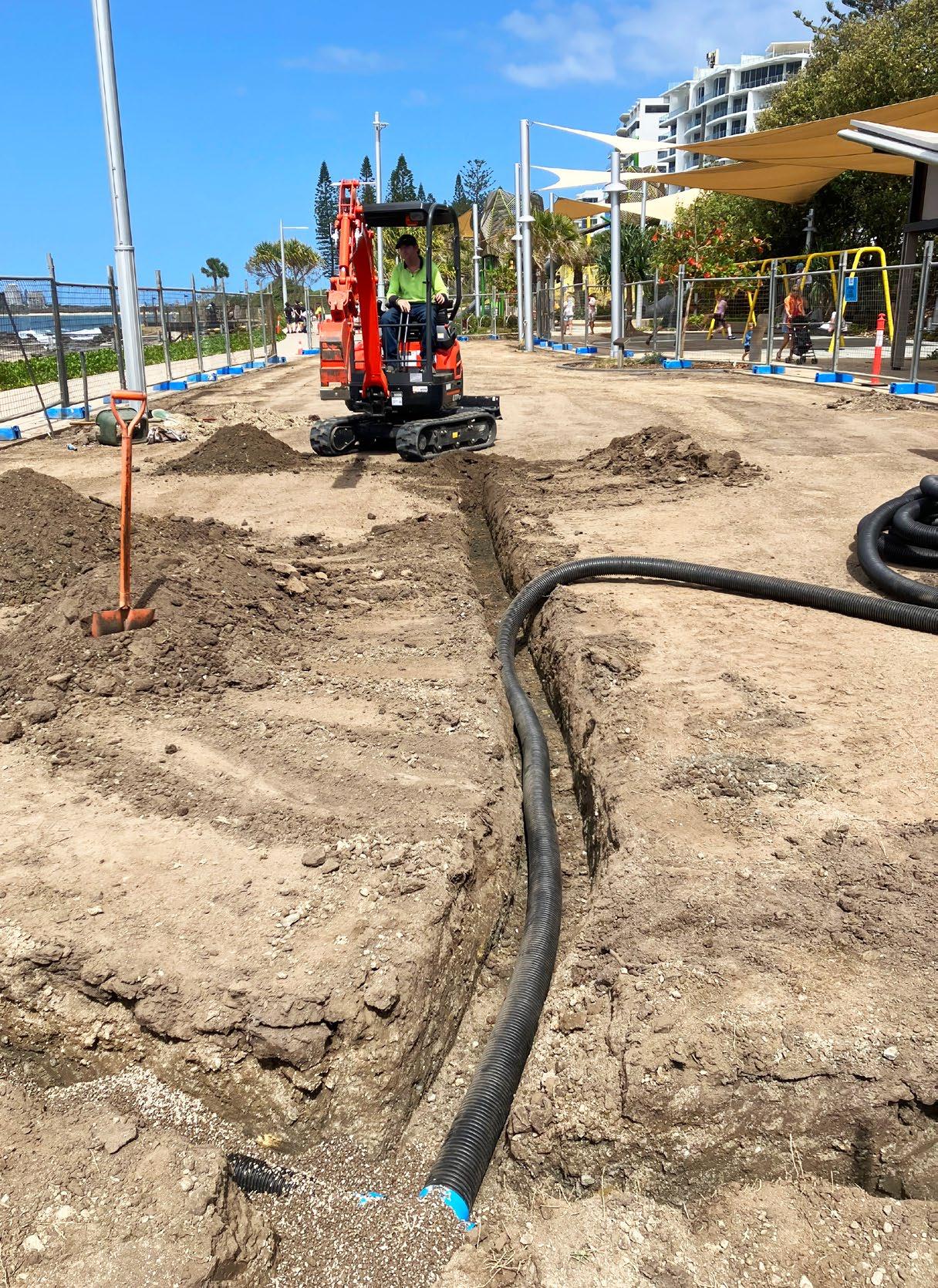
SFB8000 (a special sports blend to handle foot traffic) to be added. This was blended in with the existing profile using a Harley Rake, and then the prep area for the turf was laser-levelled to maximise the drainage.
SCC supplied Daleys Turf with staff to help control the pedestrian traffic, which allowed the team to work freely inside the safety fence with a steady flow of materials coming in and out.

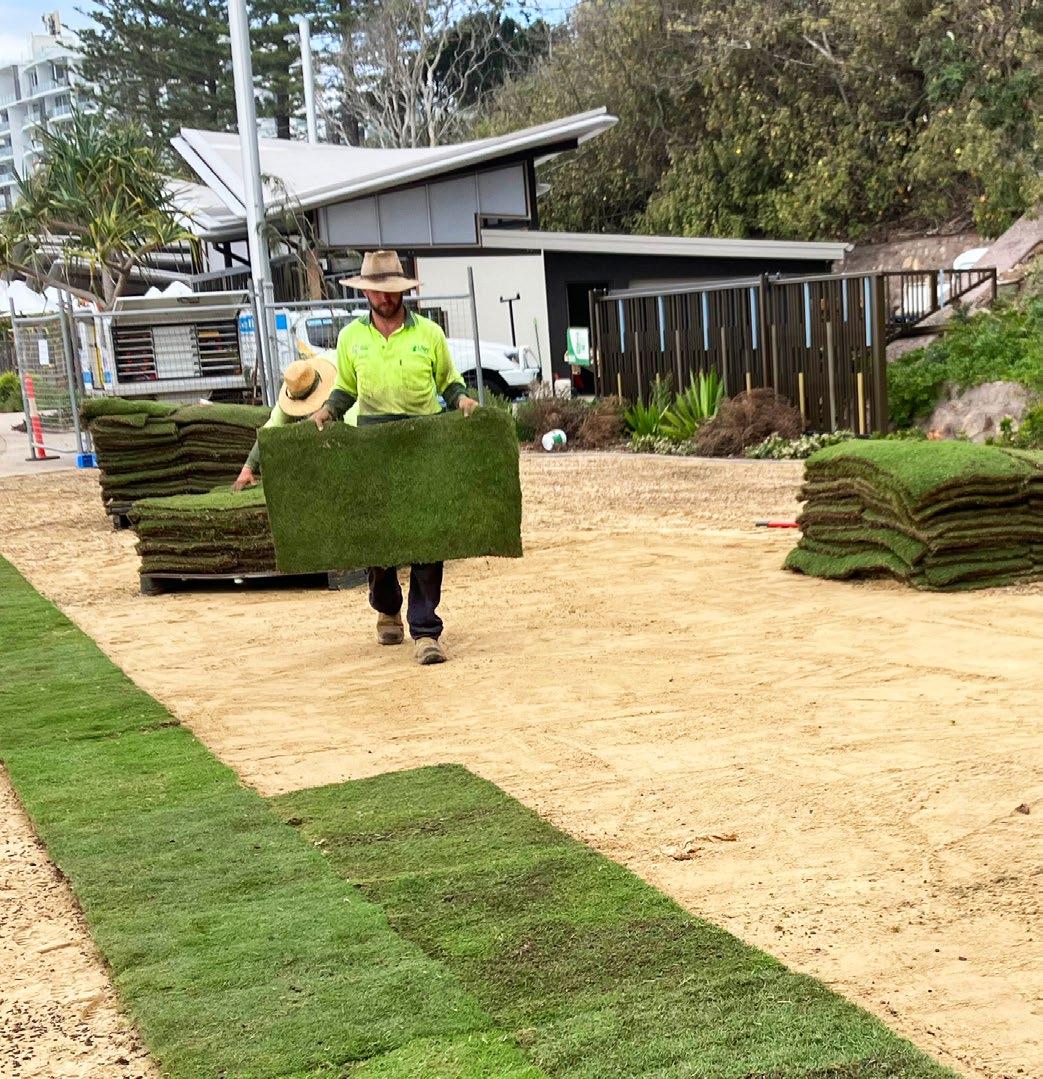
The project was completed within the 4 days allocated, followed by a 6 week maintenance period. The TifTuf performed exceptionally well establishing in its new environment so well that the turfed areas were opened to the public a week ahead of schedule.
This was one of the largest and most complex public projects Daleys Turf had ever taken on. It was a massive collaboration
with SCC and their contractors, as well as Daleys Turf contractors. Daleys Turf Owner Terry Daley was extremely proud of his team and of course, the outcome of the project.
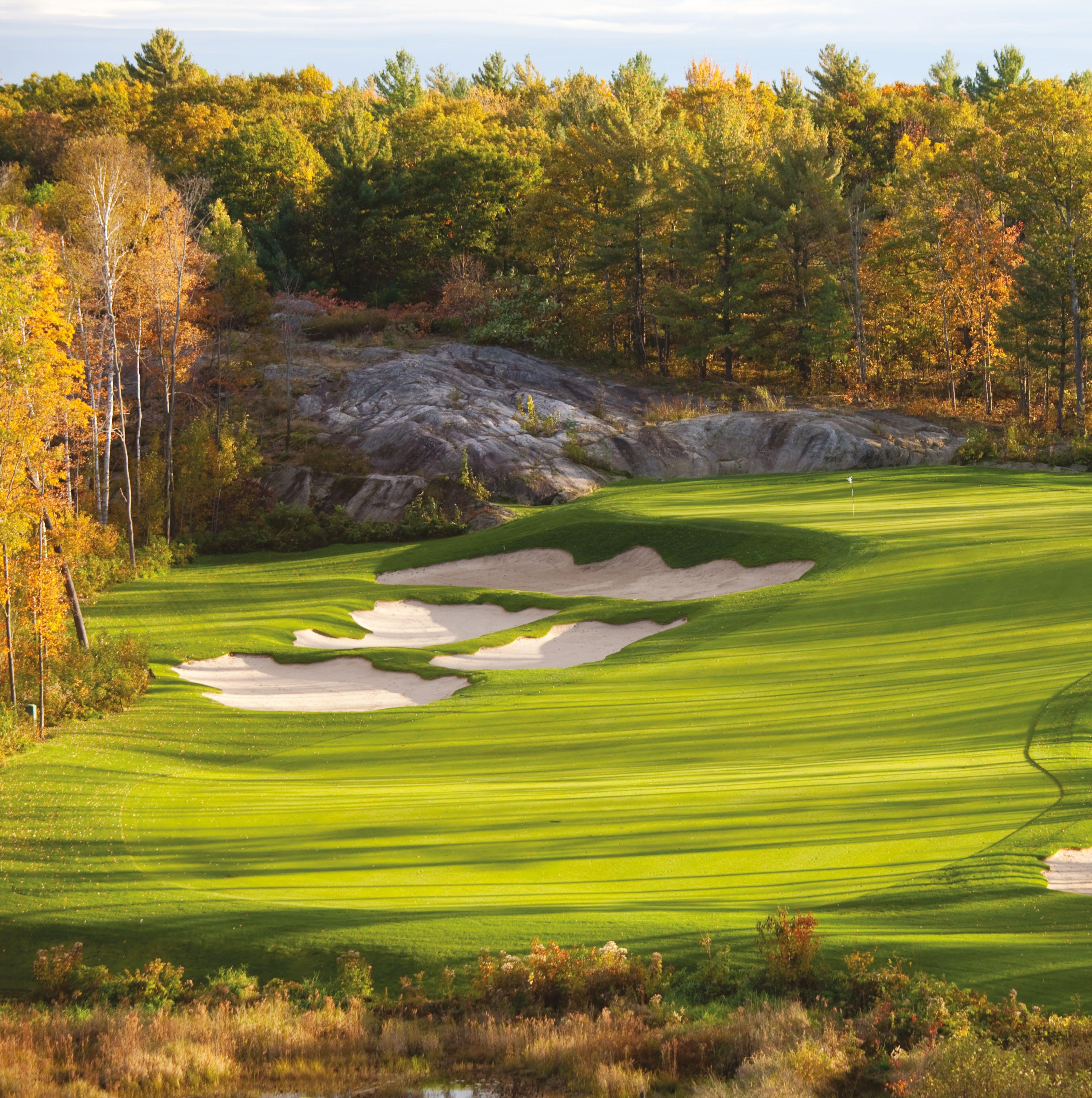

I’ve always dreamed of having my own golf hole, and now it’s happening right here in my backyard in Orange, NSW. It’s been an exciting and challenging journey but seeing it all come together has been incredibly rewarding. I’ve already built a beautiful golf green, laid down a TifTuf fairway, and set up an irrigation system to keep everything lush and green. Let me take you through the whole process, sharing everything I’ve learned along the way.
The latest completed project has been my TifTuf Hybrid Bermuda fairway. There were several steps involved in getting the TifTuf to where it is now.
Before anything, I needed to decide on the size of the fairway and the best grass type for the entire area. I planned to have
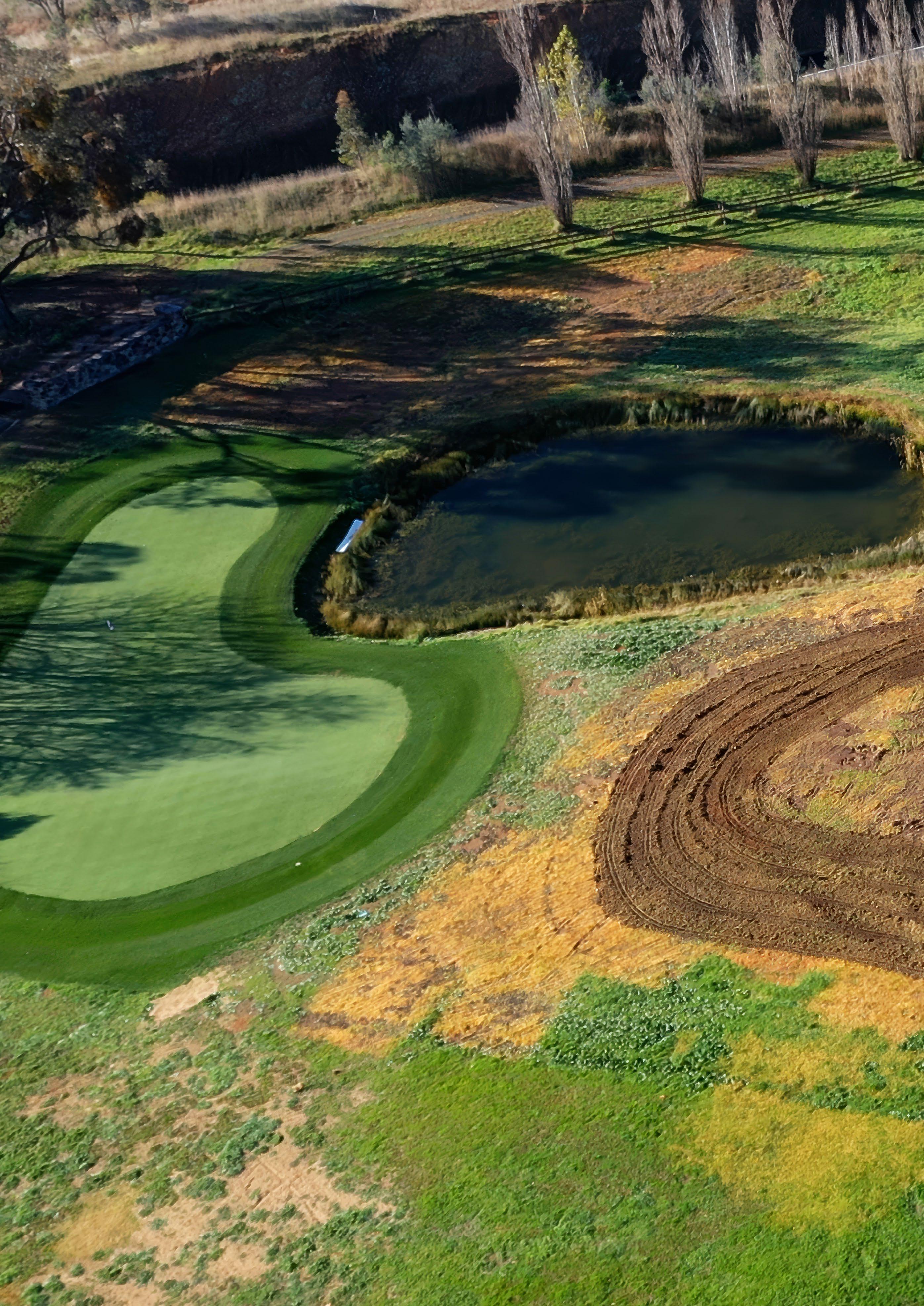
a decent-sized area since I’m eventually putting in three to four tee boxes on the golf hole. After talking with some designers and my subscribers on my YouTube channel, we settled on about half an acre of grass.
I also decided to create a second fairway on the top side of the green so the bottom tee box would have another area to hit from. This second fairway would feature a
different grass type, allowing me to show how to care for both types. In total, this meant about 2,500m² of fairway space.
Prepping this area involved several steps. Firstly, I had to clear out all the rocks in the area. There were some decent-sized boulders and a few rock shelves, so it was a bigger task than I had originally expected. I used my John Deere E36ZS Excavator to help dig the rocks out and tidy up the area.
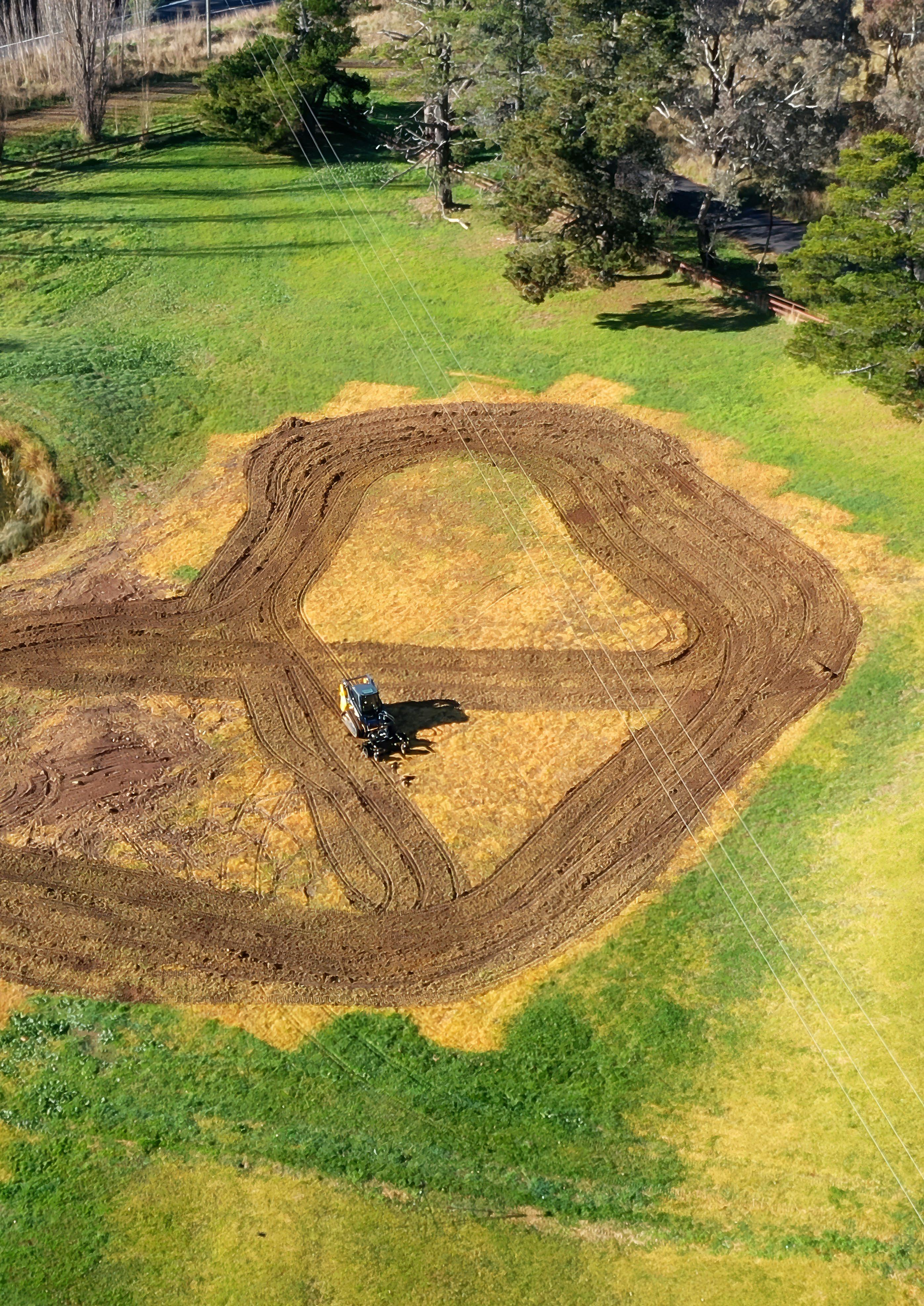
Overall, I spent close to a week digging these rocks out.
The next step was spraying out all the existing weeds and grasses so that I had a clean area to shape and turn over. I used a non-selective herbicide (glyphosate) to kill everything in the area. I did this over a six-month period. Every month, I would spray every weed that popped up to destroy as much of the seed bank as possible. This also helped remove a
lot of the existing Kikuyu and Couch, which took a few sprays to see an impact.
Once the area was clean of weeds, it was time to start shaping the fairway and turning it over so that it would be ready for turf to be laid. I used a Harley Rake (power rake) on the front of my John Deere 317G, which made things super easy. Turning over 2,000m² only took about an hour of work. I did this about three times over two months
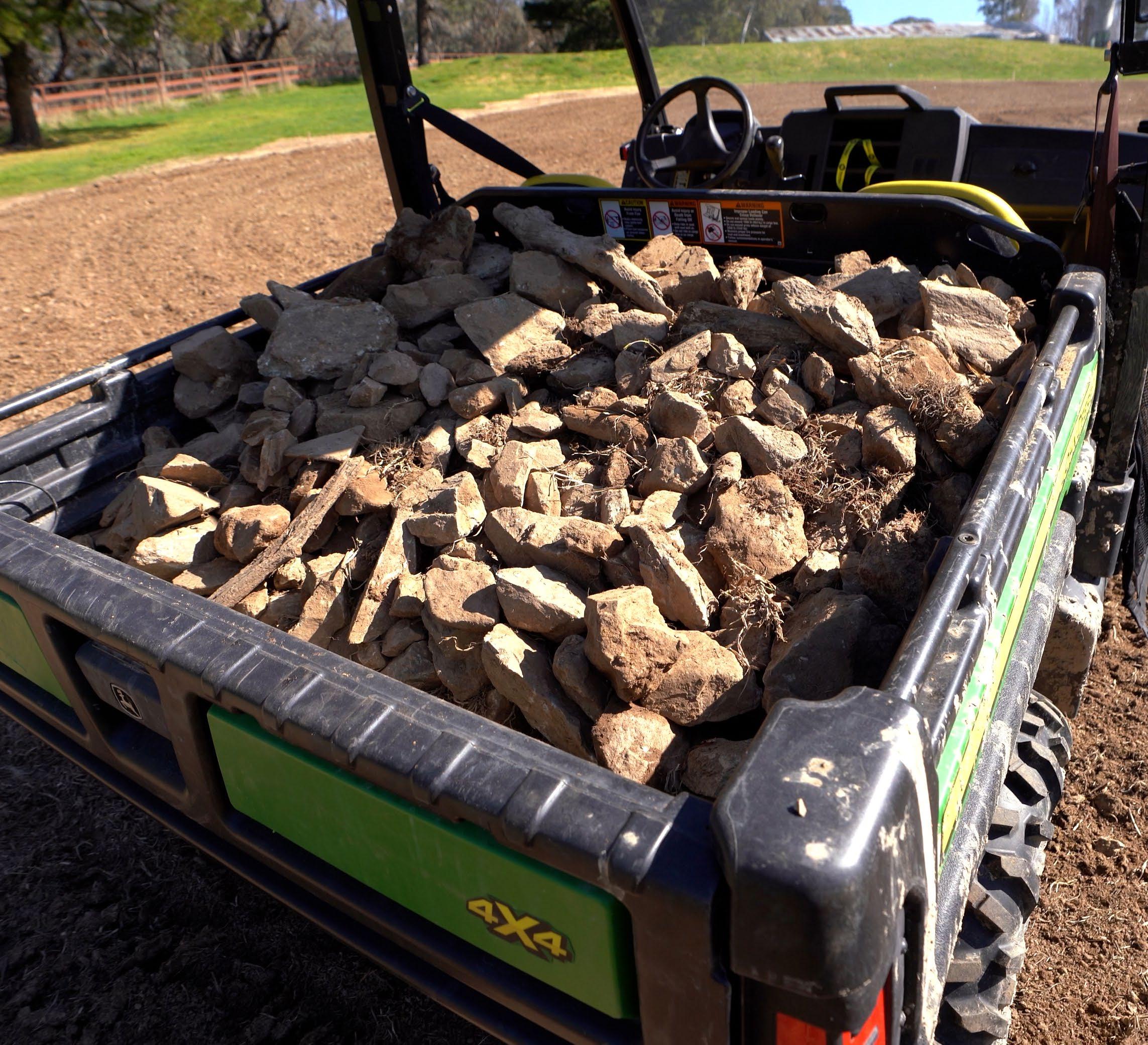
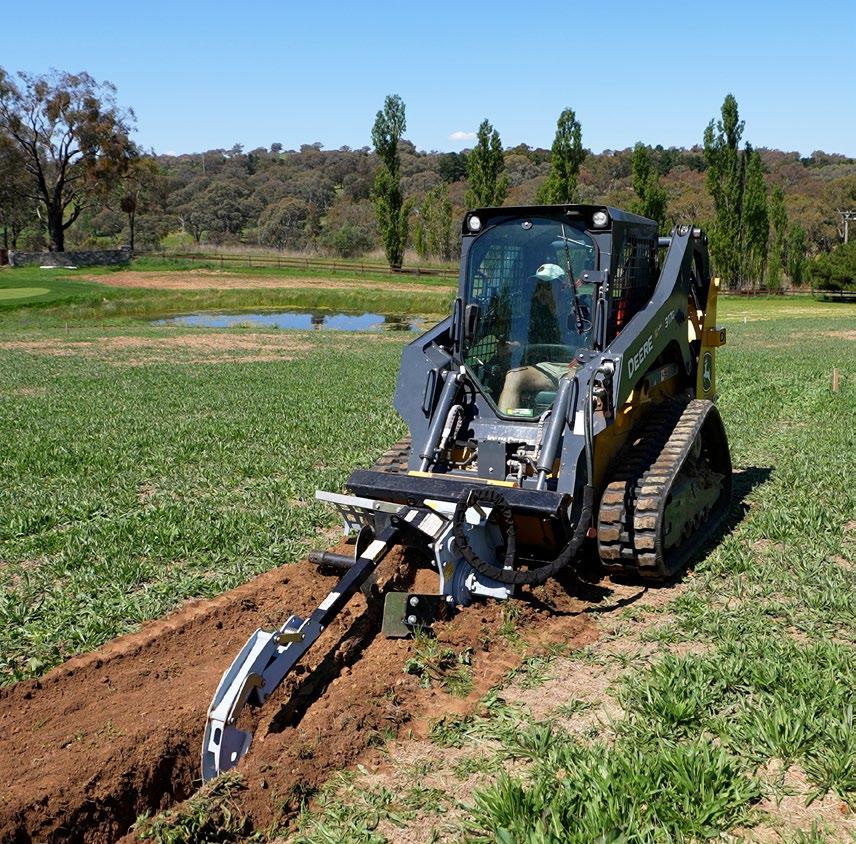
to keep the soil loose and the weeds at bay while I waited for the right time to lay the turf.
The last step before laying the turf was installing the irrigation. I installed a Rainbird system, just like on the golf green, to cover the large area. I had a trench digger that goes on the skid steer, which made it a quick and painless job.
The turf I decided to go with was TifTuf Hybrid Bermuda. The main reason for this
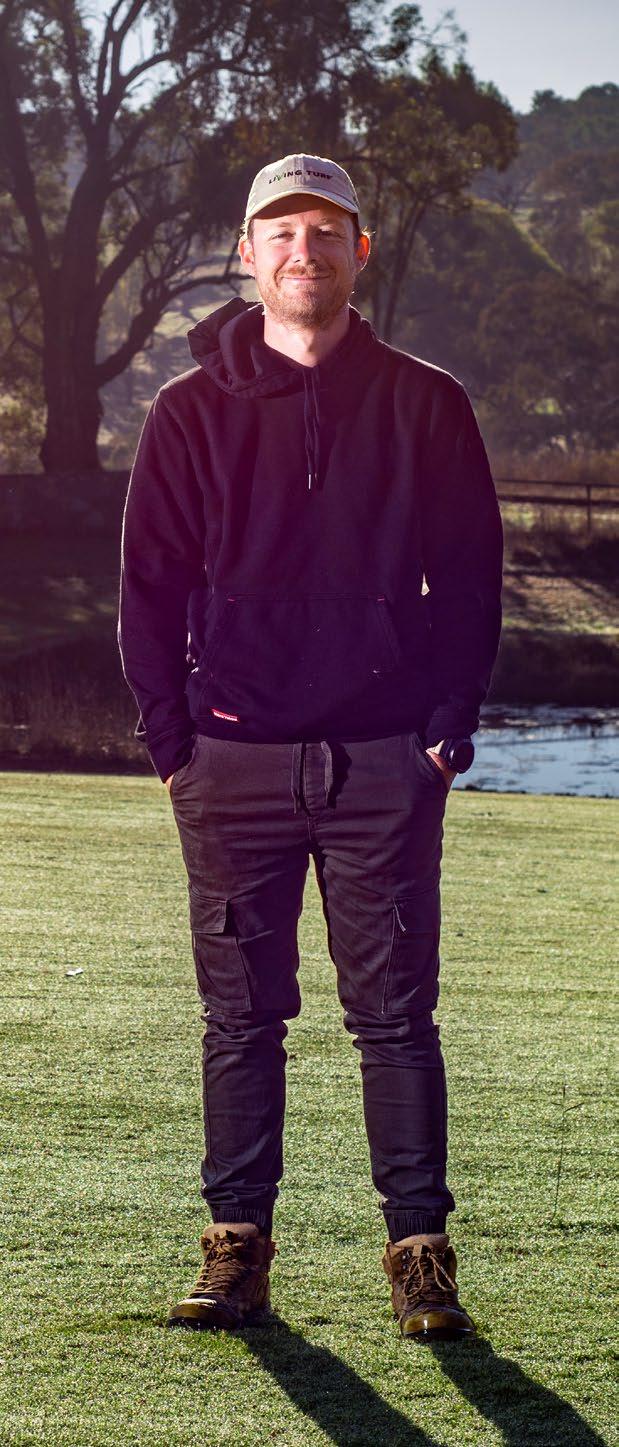
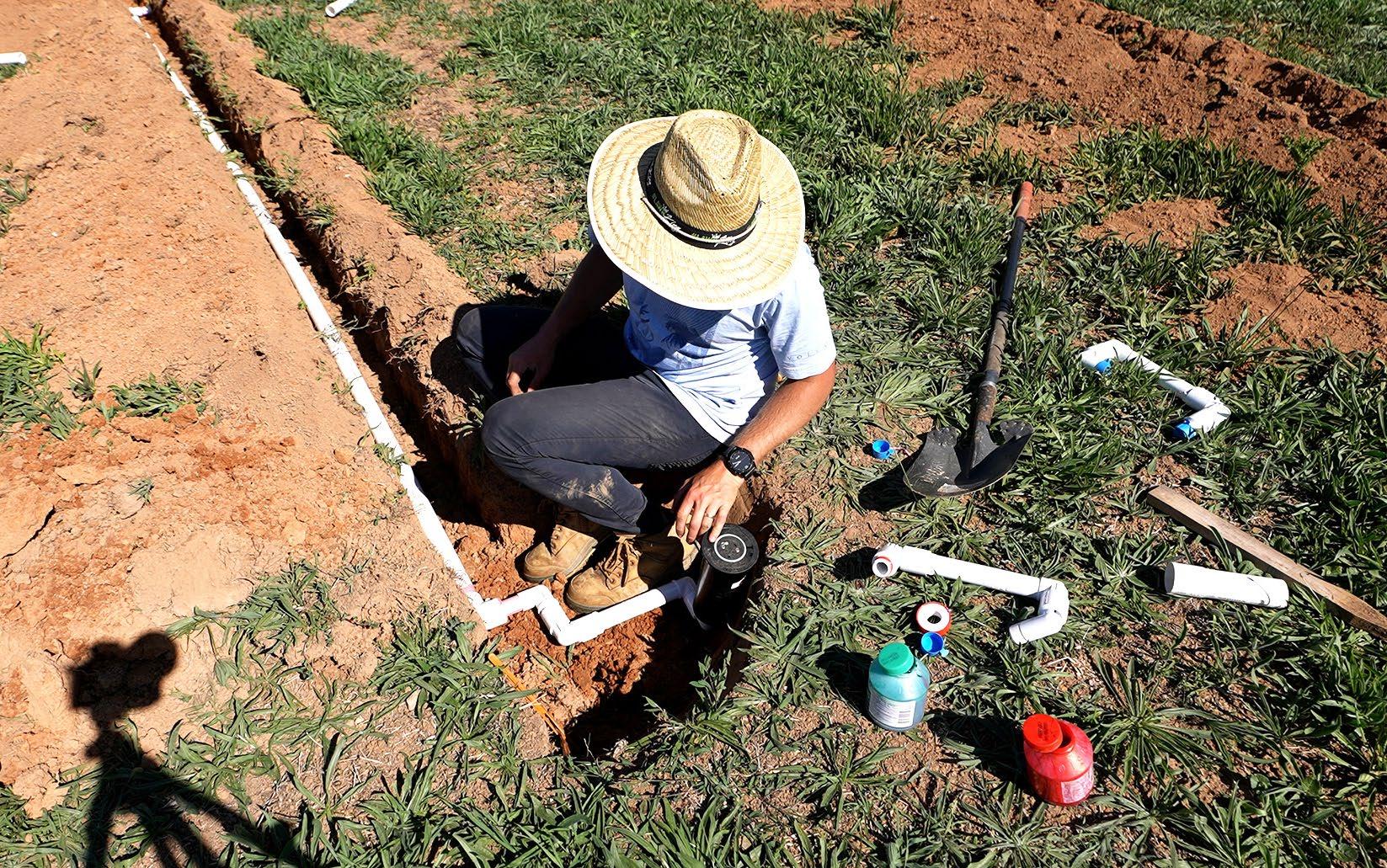
choice was that it wouldn’t require a ton of water to keep it alive, considering the size of the area and the superior drought tolerance that TifTuf has. Hybrid couches are also very commonly used on fairways across the world since you can mow it nice and low, and it repairs very quickly from divots taken by golfers.
The TifTuf was laid in December 2023 with help from the boys at Western Plains Turf. Huge shoutout to Tim and the boys there—without their help, my mates and
I would have struggled to get it down in the sweltering heat by ourselves. We had 1,700m² to lay in the end, and it took us four hours. Not a bad effort!
After the turf was laid, the next step was to ensure it was established properly. For the first few weeks, I watered the new turf daily to help it take root. After that, I gradually reduced the watering frequency to encourage deeper root growth. Mowing was also a critical part of the maintenance routine. I started mowing the fairway after


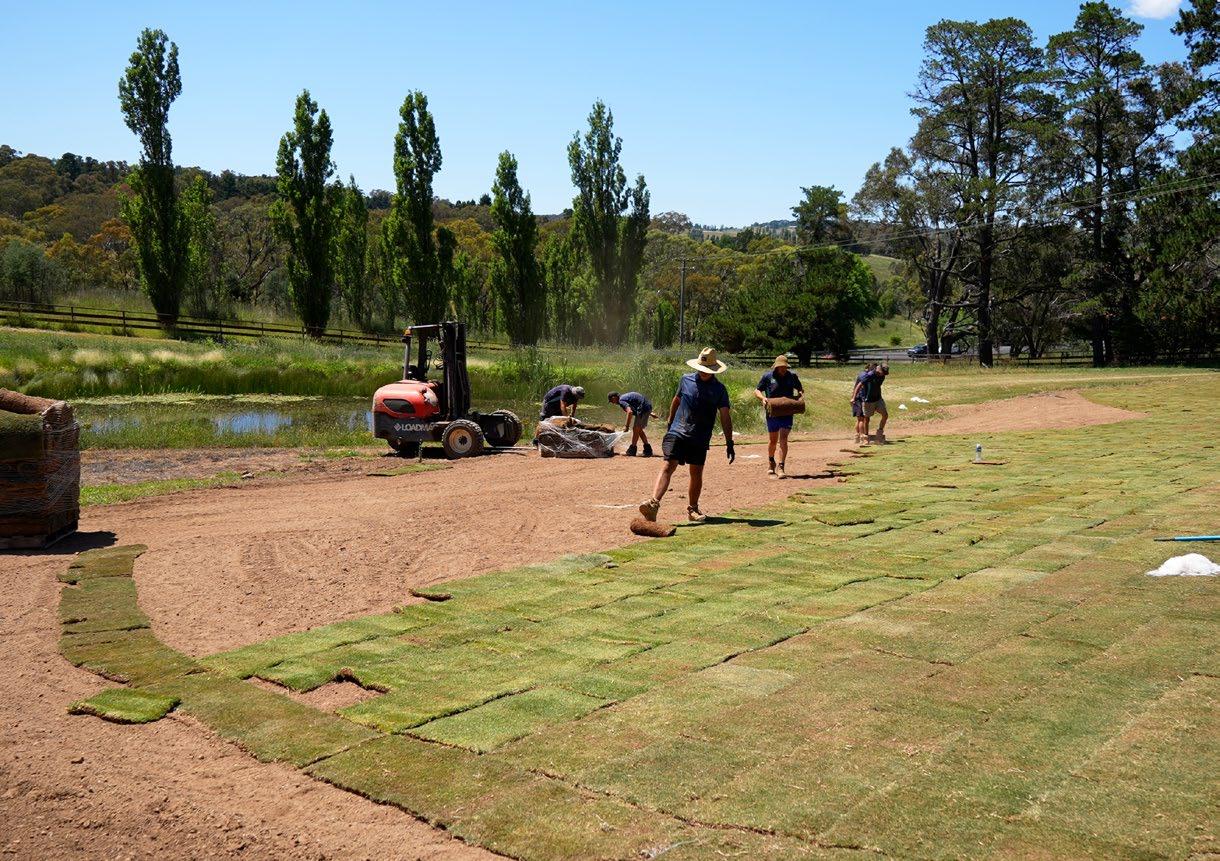

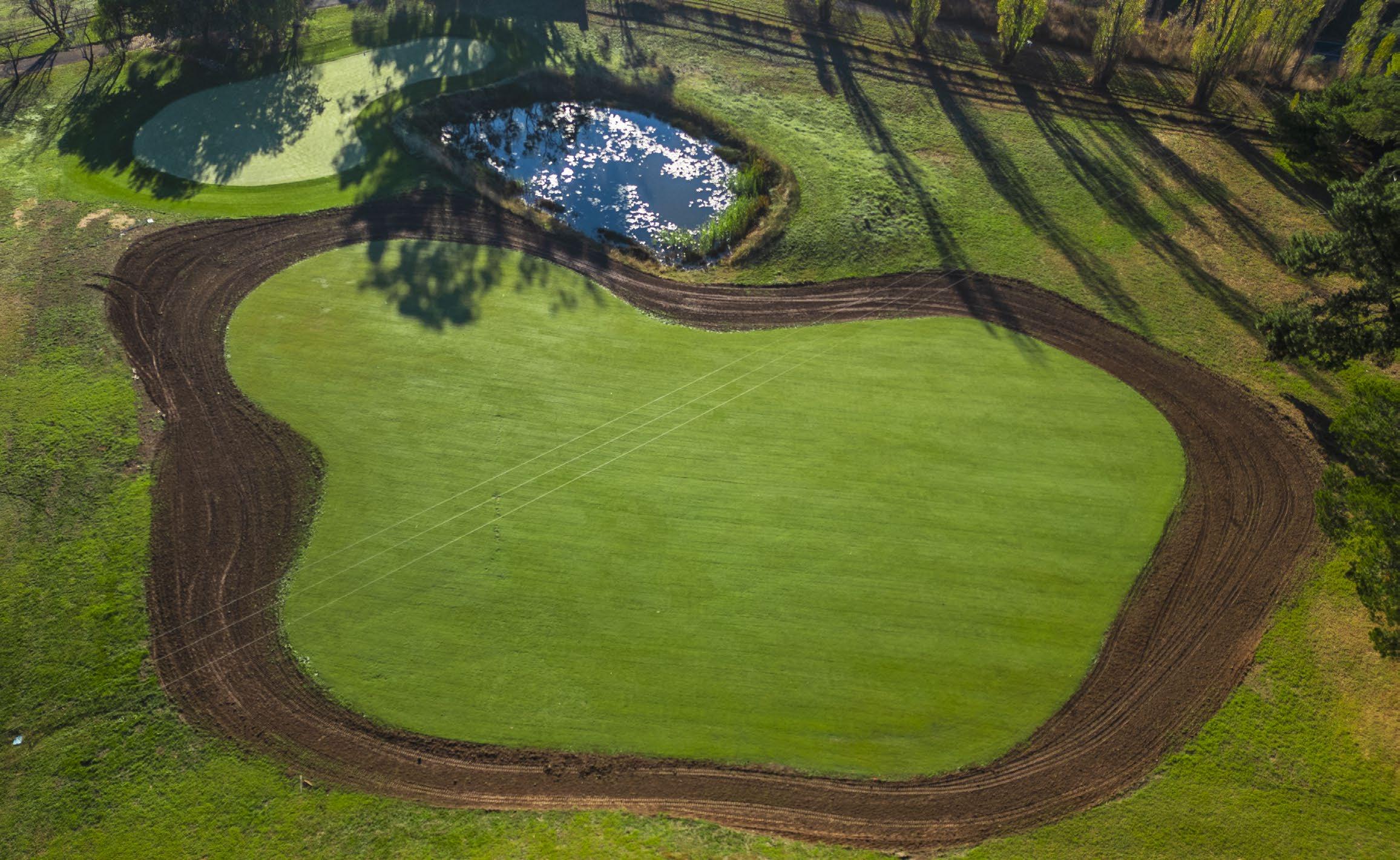
about two weeks and continued to mow it regularly to promote healthy and dense turf.
I’ve still got a few projects to work on over the next 12 months, and the plan is to have it all finished by the end of next year’s season. Here are some of the main tasks I plan to tackle:
Build Three Tee Boxes: I need to design and construct three tee boxes, each with its own irrigation system and grass. This will allow
for a variety of tee-off points, enhancing the playability of the hole.
Install a Sir Grange Zoysia Fairway: Next to the green, I plan to install a Sir Grange Zoysia Fairway. This will not only add variety to the course but also provide an opportunity to showcase how to care for this type of grass.
Create a Pitch and Putt Area: I want to sprig 2000m² with TifTuf to create a pitch and putt area. This will be a great addition for practising short-game skills.
Install Grass in the Rough Areas: To complete the look and feel of the course, I need to install grass in the rough areas. This will involve selecting the right grass type and ensuring it blends well with the existing fairways and greens.
I’m sure more ideas and projects will come up, but these are the main ones I hope to complete by the season’s end. Building my dream Par 3 golf hole has been an awesome journey so far, and I’m excited to see it all come together.
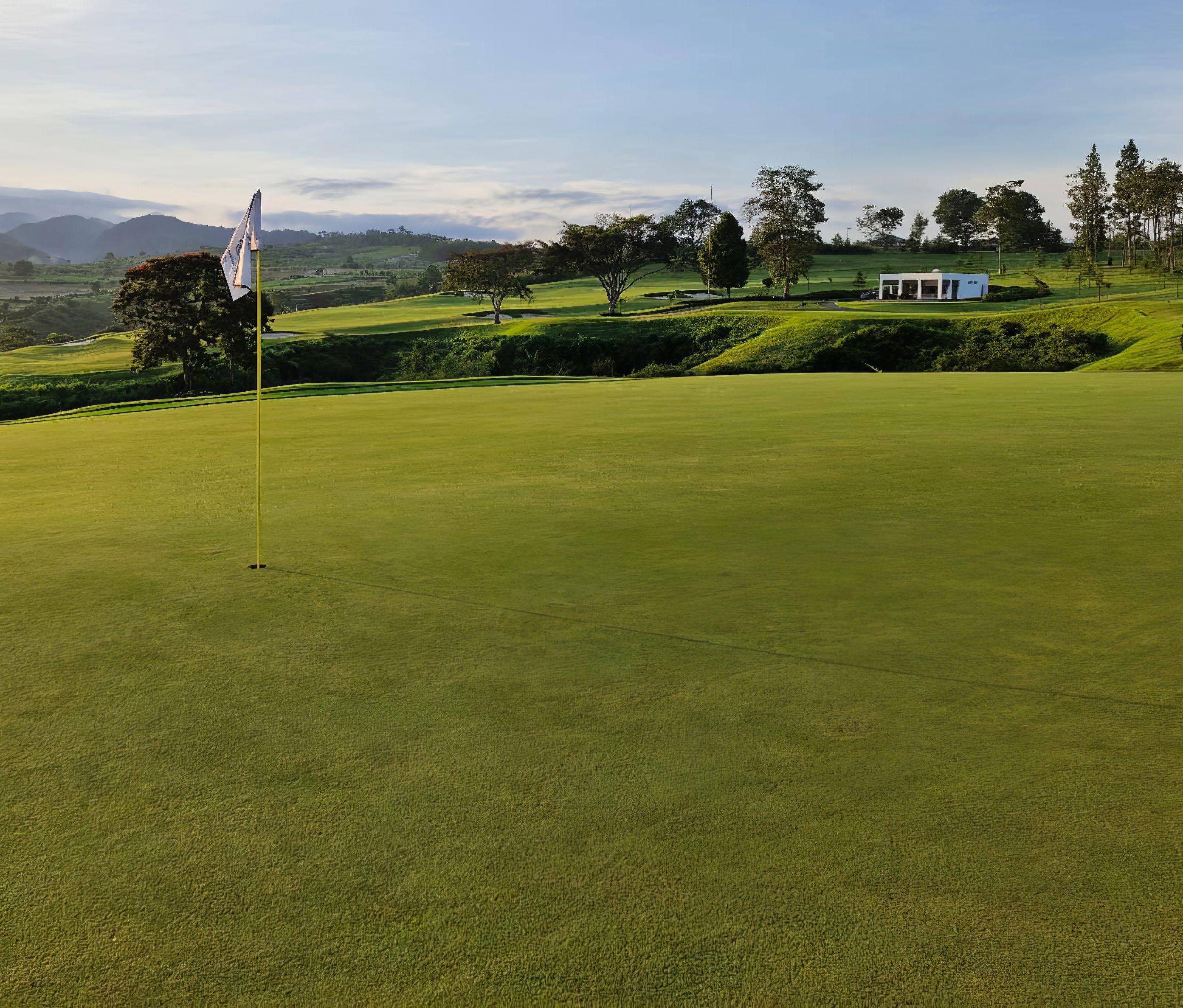
In as little as two years, I had made many close friends in my newly adopted town of Noosa and at Noosa Golf Club, after spending 22 years abroad. But a new opportunity meant that it was time to leave Australia behind once again.
The move was purely a career-driven path; the opportunity to be the first Superintendent of an Ernie Els Design in Indonesia, as well as the first Superintendent of a Trump Golf Course in Asia. Off to the next adventure –a new country, culture, and language.
I landed in Jakarta, Indonesia on AFL Grand Final day in September. This was my first
time in Indonesia and the start of a new chapter in my career. My first impression of the golf course was that it was both mindblowing and breathtaking. I had seen the course in photos, but it was completely different to experience it in person. The property, the spectacular view, the early morning mist, and the fog wafting through the valleys, being perched between two majestic volcanoes, is something you would see in a travel or national geographic program. These were my first impressions of Trump International Golf Club Lido.
Located on a plateau 700 metres above sea level, Trump Lido is an 18-hole upscale property development in a newly
created special economic zone 60km south of Jakarta near the city of Bogor, with spectacular views of surrounding mountains including Mt Salak, an eroded stratovolcano. The course is complemented by a grand thirty-three thousand square metre Club House, which showcases the Trump brand, offering a captivating golfing experience that features state-of-the-art facilities, including a Lifestyle Country Club with 24/7 concierge and uncompromising personal service and attention to detail.
The construction was led by Golfcon Asia under the expertise of Project Manager

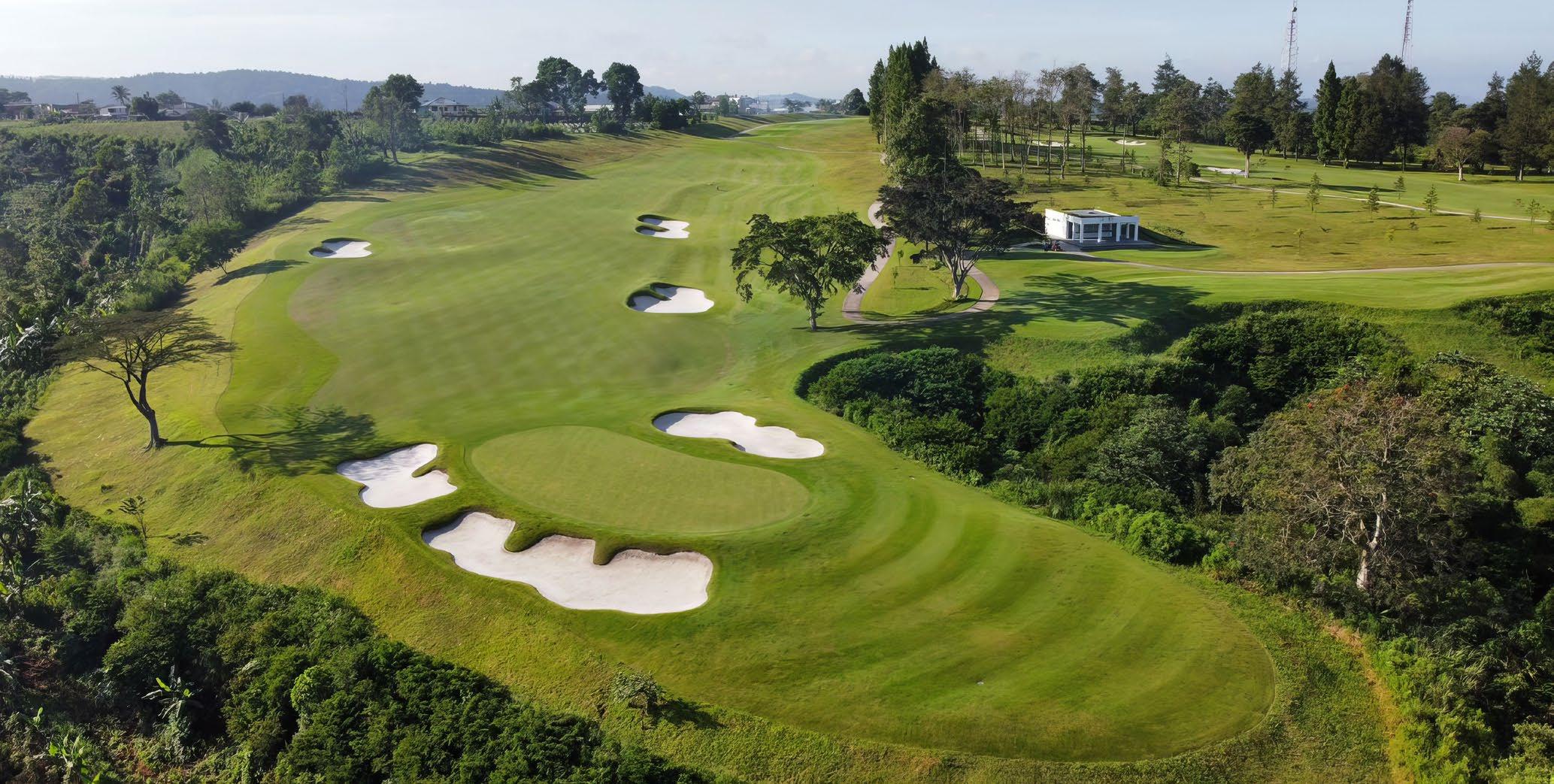
Dustin Jennings and shaping and finishing was completed by the experienced Peter Waddell who worked closely with the Ernie Els Design (EED) and MNC Land teams. Along with significant contributions from the Assistant Project Manager I. M. Ariana Kadek and the team from the local community.
Zorro Zoysia was used from tee to green and TifEagle Couch was chosen for the greens. Broadleaf carpet grass was also chosen as the external rough grass to boundary perimeters. Being located 65km south of Jakarta close to the city of Bogor and at 6 degrees below the equator, there are only two seasons here, dry and very wet with an average of almost four metres of rainfall per year.
The course has been built to USGA specs on all tees and greens. The rest of the course is constructed with local soil that is quite rich in nutrients and is surprisingly free draining. Drainage as you can imagine would be vital in such areas with extreme rainfall which at times can dump at least 120mm in as little as 45 minutes. Six of the front nine holes have been designed and shaped to carry drainage water back to the irrigation holding pond which holds 28,000m3. You would think bunkers would be a big problem washing out all the time, which was my first thought when I saw my first rainfall, but I was wrong. Enter Peter Waddell with his expert shaping and understanding of local conditions to mound the water away
from entering the bunkers. The issue of bunkers is now only a quick 20-minute fix for staff instead of an all-day or week-long affair compared to other golf courses.
Toro irrigation was chosen with Lynx control which can be controlled from a phone or tablet. With 22 satellites on course, a full weather station and 1,250 sprinklers - we have every blade of grass covered.
Like many countries where I have worked, chemicals and fertilisers come with their own set of challenges. One of the first tasks was sourcing products locally and ascertaining what products were licensed to be imported
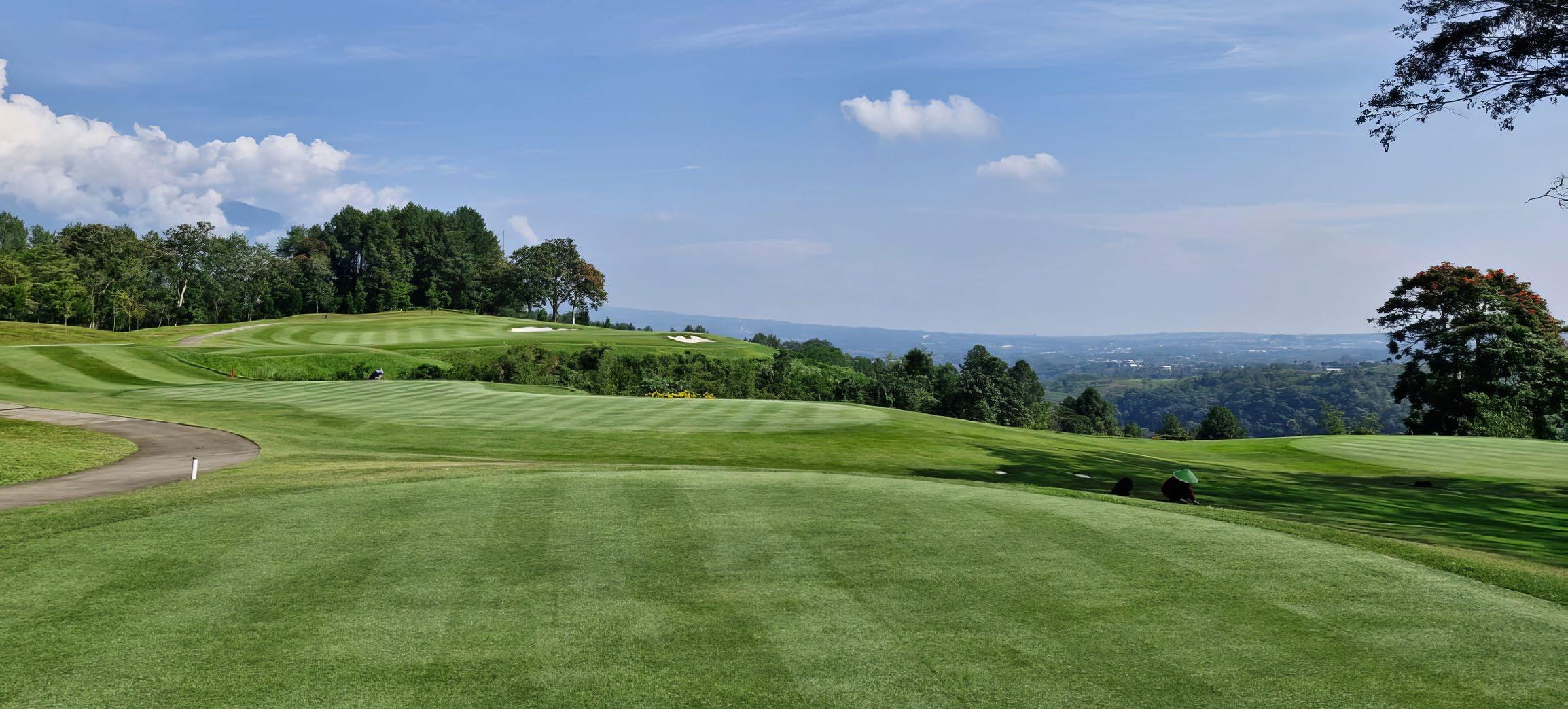
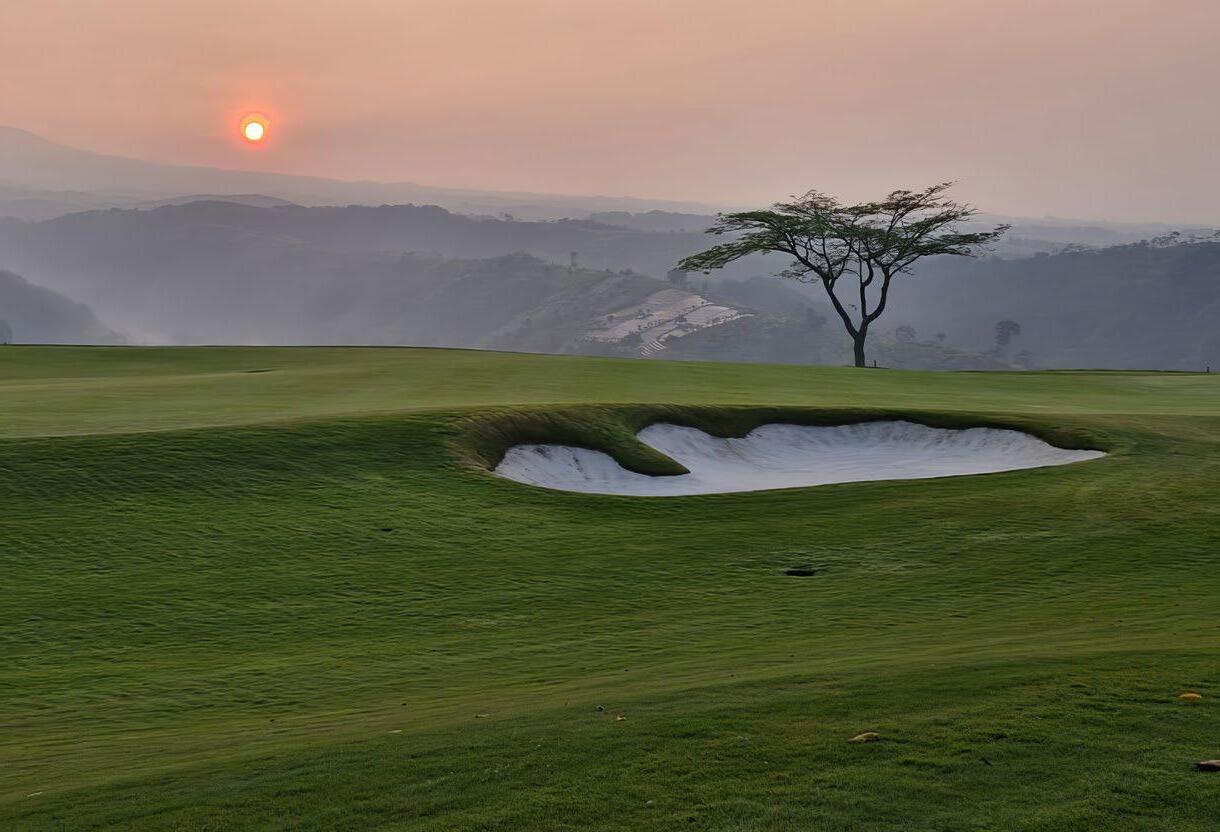
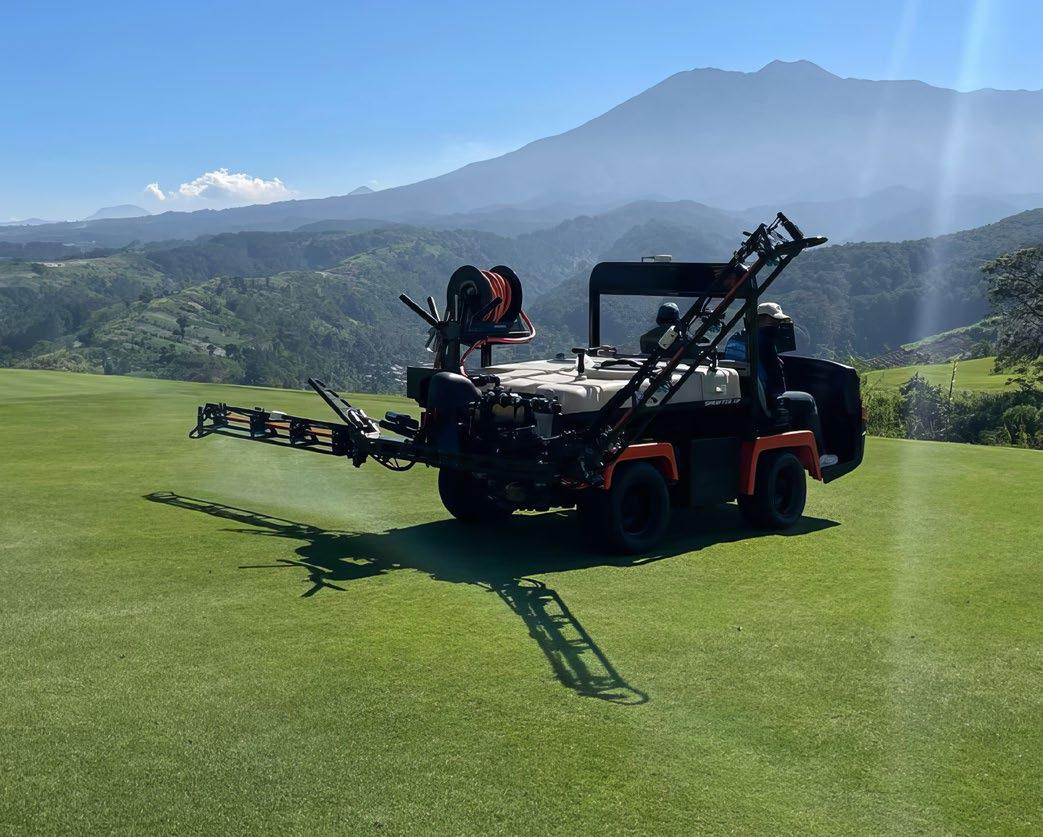
into the country. My fertiliser program on the greens and tees is a mixture of Floratine foliars along with Calcium nitrate and Magnesium sulphate, with more intense programs used on the greens as sunlight and temperatures are significant factors in plant health.
A combination of both granular and foliar fertilisers was applied to both grow-in and established turf. Andersons and Yara fertilisers were the imported granular products, plus a mixture of local granular fertilisers being used. Translating Bahasa into English from a very long Excel spreadsheet of approved chemicals was another challenge, thank goodness for Google Translate and my office for helping with this. The active ingredient is the key and the first place to start, then the concentration of active, followed by where it was manufactured and whether it was still under license.
We employ the local community, and we are very fortunate to have 40-50 employees who work as a team to pull weeds in areas that we cannot get sprayed and control with chemicals. This team is a key force in the operation as well as our operators ranging from brush cutters, and flymower operators, up to our experienced mowing team taking care of the course each day. We are also lucky to have a full complement of Bernhard grinders for our reel mowers with our bed knife grinder and reel grinder, as well as a dedicated rotary blade sharpener. Our mechanics are leading the way in Indonesian golf in maintaining a sharp-cutting unit daily, something that is not too common here.
I started at Trump Lido with nine holes already grown in and the back nine was in various stages of growing in and construction. This experience has been one
of passing on my knowledge to the team but also gaining immense knowledge and experience in so many different facets of our industry. The opportunity to grow in the back nine holes and driving range and to work alongside the project management team and shaper, as well as working with Greg Letsch, Senior Lead Design Ernie Els Design (who made over 15 site visits) is something I will never forget.
Trump Golf has exciting projects globally and although being a big corporation, the support at every level is truly amazing. As the time gets closer and the grow-in and final touches come to fruition, the beauty of Trump International Golf Club Lido will truly shine for all to see. It will be a must-visit for any golf enthusiast. Trump International Golf Club Lido is set to open before the end of the year.
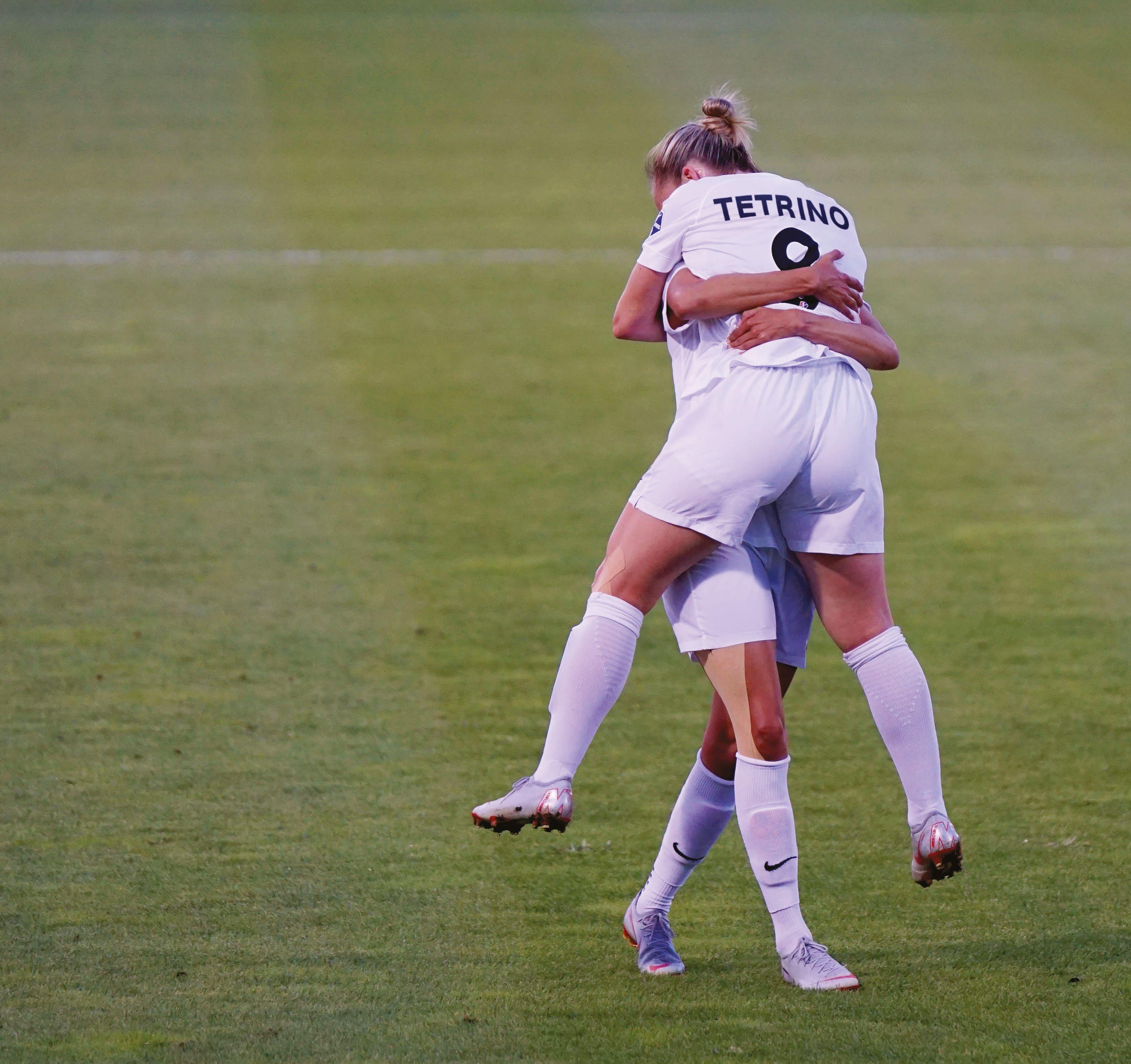
Tetrino, a new insect control solution from Envu, offering an unmatched combination of performance, ease of use and efficiency. Delivering fast control and lasting protection against a broad-spectrum of turf insect pests with a low rate of active ingredient, Tetrino is the smart play for flexible and sustainable insect control.

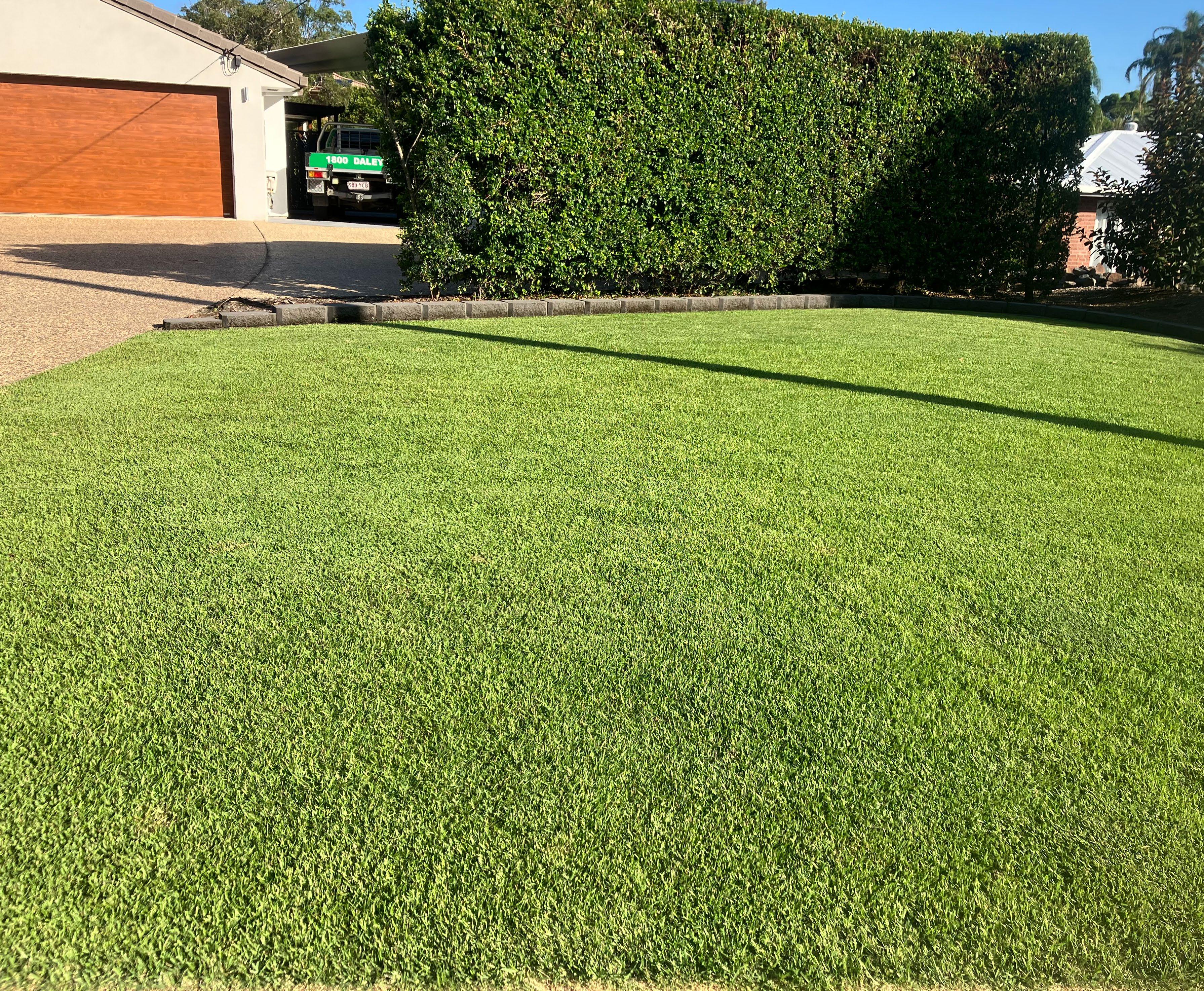
Over the 31 years we have been producing turf for South East Queensland, I have learnt a lot about introducing new varieties to the market.
Knowing the product and having confidence in what you are selling to your customers is a must. As a result, my wife and I decided to remove an area of our front lawn and replace it with Zoysia Australis, or ZA as we “Turfies” call it.
I sprayed out the existing lawn which required three applications one week apart. I then waited for 6 weeks to be sure the old lawn had completely died.
As our neighbours and regular passers-by were used to seeing the lush green grass we pride ourselves on, this attracted some
attention to the ‘dying lawn’ and what was going on at the turf farmer’s place, with many stopping out the front to ask about the project. We had one very enthusiastic visitor to the neighbourhood knock on our door on a Sunday morning asking why we had killed our lawn and what was our plan for it.
After chatting to him about the new Zoysia Australis, as a lawn-lover himself, he was eager to see the results and asked when ZA would be available to the public as he would like to try it out at his place. We welcomed him to come back and check out the new lawn as it was establishing.
I removed the old lawn using a turf cutter, then added organics, lime, gypsum, and trace elements to the soil blending it into
30mm of the top layer. Five millimetres of top-bedding sand was added to create a cap on top. This allows for levels to be precise, with the added benefit of better drainage for the profile as Zoysia doesn’t like ‘wet feet’ - growing in soil that is too wet.
The next day we harvested the ZA. We applied a slow-release fertiliser to the area to provide food for the new turf for 12 weeks, then we installed the ZA. It was rolled twice and watered in well to bed into the soil profile.
Often customers believe the organics that were added to the top layer of soil in preparation for new turf is enough, and that fertilising before installation is not needed. However, a starter fertiliser application should always be carried out,

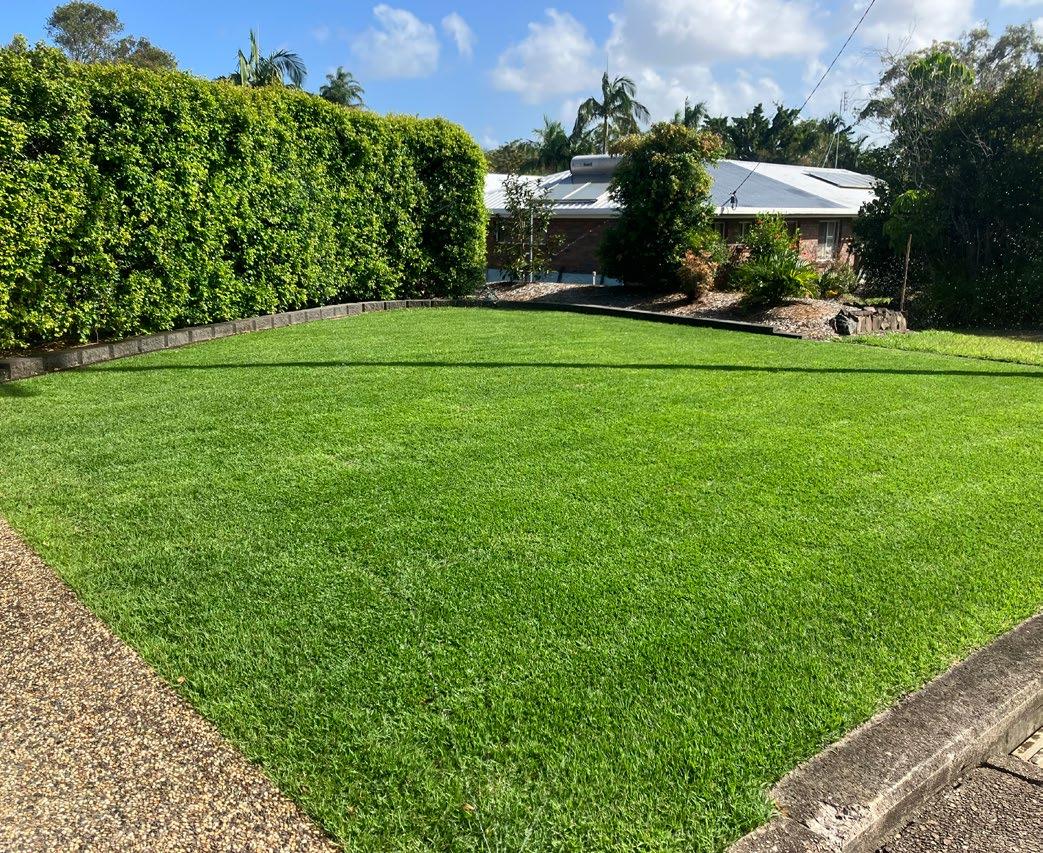
3 WEEKS AFTER INSTALLATION

8 WEEKS
preferably with a slow-release product to ensure the necessary nutrients for optimal establishment are provided.
The new lawn was lightly irrigated morning and night for the first 7 days, once daily for the following 7 days, then every other day for a further 2 weeks.
The new lawn had its first mow after 18 days. I always water new turf immediately after the first mow, which seems to help reduce the stress of the new plant having its leaves cut off.
Since installation, I have only used liquid feed, Lawn Solutions Australia Exceed and Lawn Kelper on the lawn every 4-6 weeks as the colour reduces. This is to control the thatch and the clipping count. Applying
small amounts often has had the best results. To date, I have not applied a granular fertiliser, and it doesn’t look like it will be needed. Nor have I applied any herbicides, fungicides, or pesticides despite having had the worst lawn grub season in years.
I have seen the presence of mealy bug in one small area where it’s damp from the shade of a hedge, however, I have not treated the pest and it has not been a problem for the lawn.
The lawn-lover who was interested in what we were doing with the lawn and eager to see how the ZA performed, called by again within days of installation and was excited to see how it looked and loved the blue-green colour like QLD Blue Couch. He placed the
first order of ZA for his own lawn right there on the spot, and his second order about 6 weeks later.
We had more interested neighbours stop by over the following weeks, and after answering their questions, they too wanted to have their lawn replaced with ZA. The orders then rolled in.
Zoysia Australis has proven itself, not only to my wife and I, but also to the local community as a great variety of turf for a beautiful lawn. It has shown how little input is needed to achieve excellent results. The lawn has grown successfully in the entire area of installation, and even in the shade of the hedge despite having one of the wettest and most humid summers in years.
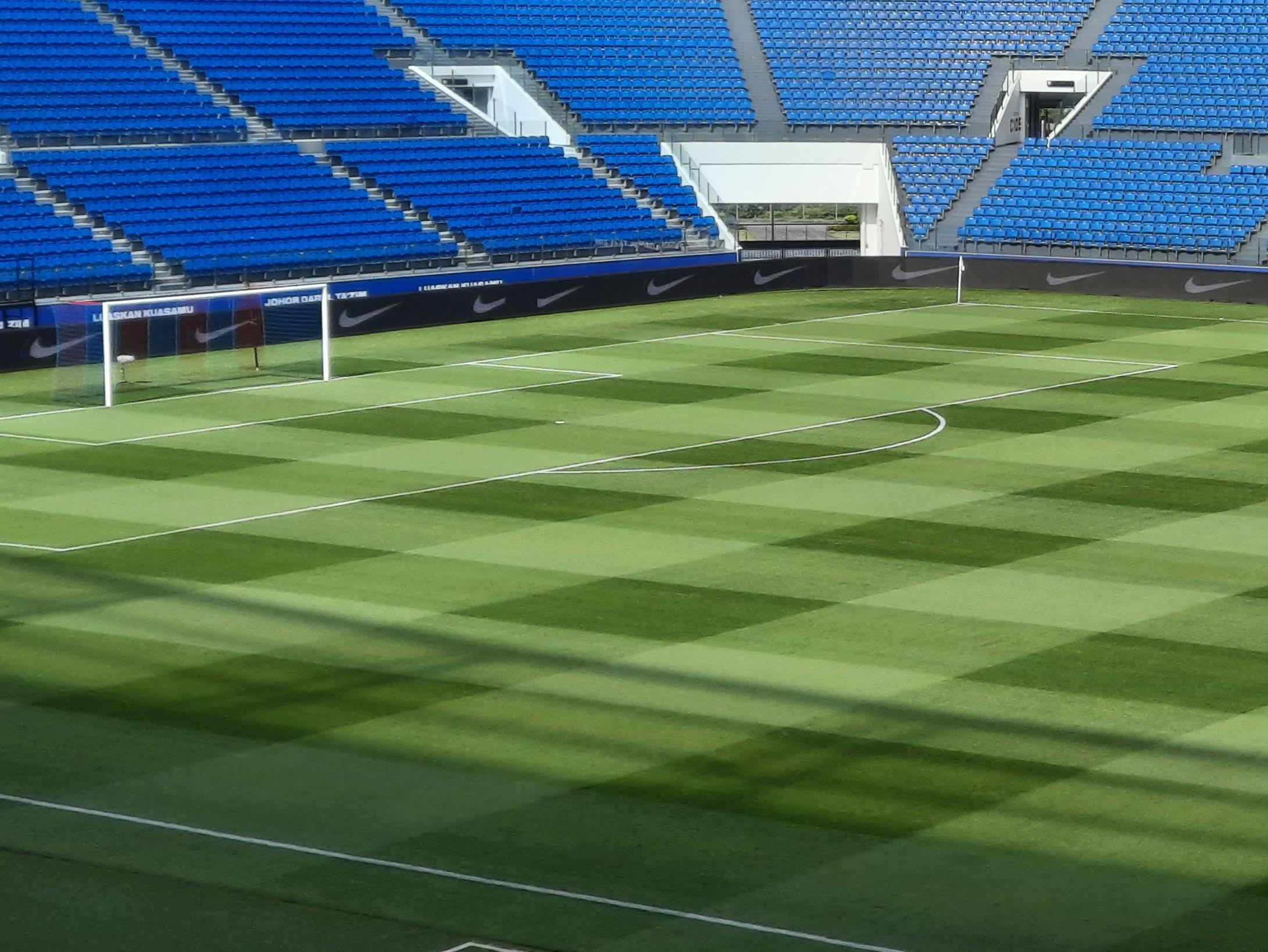
In the electrifying world of sports, where every second can lead to either glory or heartache, an unlikely champion is making waves beneath the surface – Zeon Zoysia (known as Sir Grange Zoysia in Australia) and BRF Stadium Zoysia grass. Developed over the past 10 years by David Doguet, the innovative Zoysia Breeder and Owner of Bladerunner Inc, Texas, USA, this groundbreaking turf is capturing attention for its incredible ability to withstand the rigours of the game - from the relentless stomp of cleats to the test of weather extremes. Its robust resilience and eco-friendly nature are revolutionising the playing fields of Asia’s elite stadiums. Spearheading this green transformation, the visionaries at Sports Turf Solutions (STS) who, with their 30 years of experience dealing with Zoysia Grasses knew these new Zoysia varieties would ultimately dominate the Sports Turf World in Asia.
A shining example of this transformation is the Sultan Ibrahim Stadium, the proud arena of the Southern Johor Tigers Football Team. Since its inauguration in 2020, it has offered nothing short of immaculate conditions for every match played on its grounds. The discerning eye of the Crown Prince, who demands unparalleled standards, found Zeon Zoysia (known as Sir Grange Zoysia in Australia) to be the unmatched choice to withstand Malaysia’s demanding climate. His endorsement extended to sponsoring the Zeon Zoysia installation at the Bukit Jalil National Stadium in Kuala Lumpur, further cementing the grass’s reputation.
Jakarta’s Gelora Bung Karno Stadium, with its impressive capacity of over 77,000, emerged as a pioneer in Asia by embracing
a permanent Zeon Zoysia (known as Sir Grange Zoysia in Australia) field in 2018. This venue has since played host to a plethora of significant events, including major sports competitions and government ceremonies, even managing to draw a record crowd of 150,000 attendees, showcasing its robustness and appeal.
The journey of the Singapore National Stadium is a testament to adaptability and innovation. Since opening its doors in 2014, the stadium has undergone several turf transformations to combat the harsh local weather and its unique architectural challenges. The introduction of Zeon Zoysia (Sir Grange) marked a turning point, leading to the eventual upgrade to BRF Stadium Zoysia. This choice has proven to be a gamechanger, especially noted during the HSBC World Rugby Sevens in April 2023, where its superior wear tolerance was on full display.

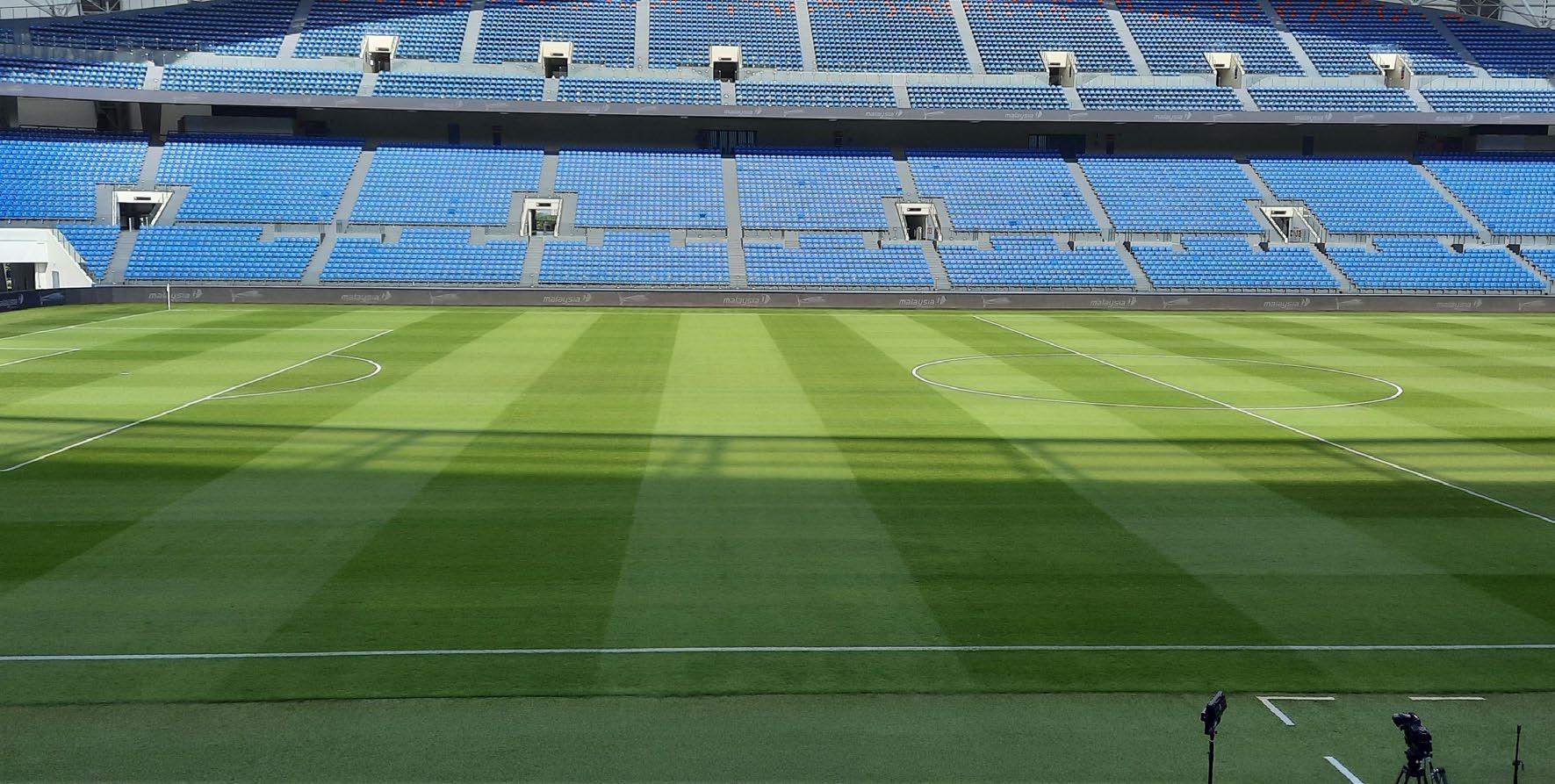
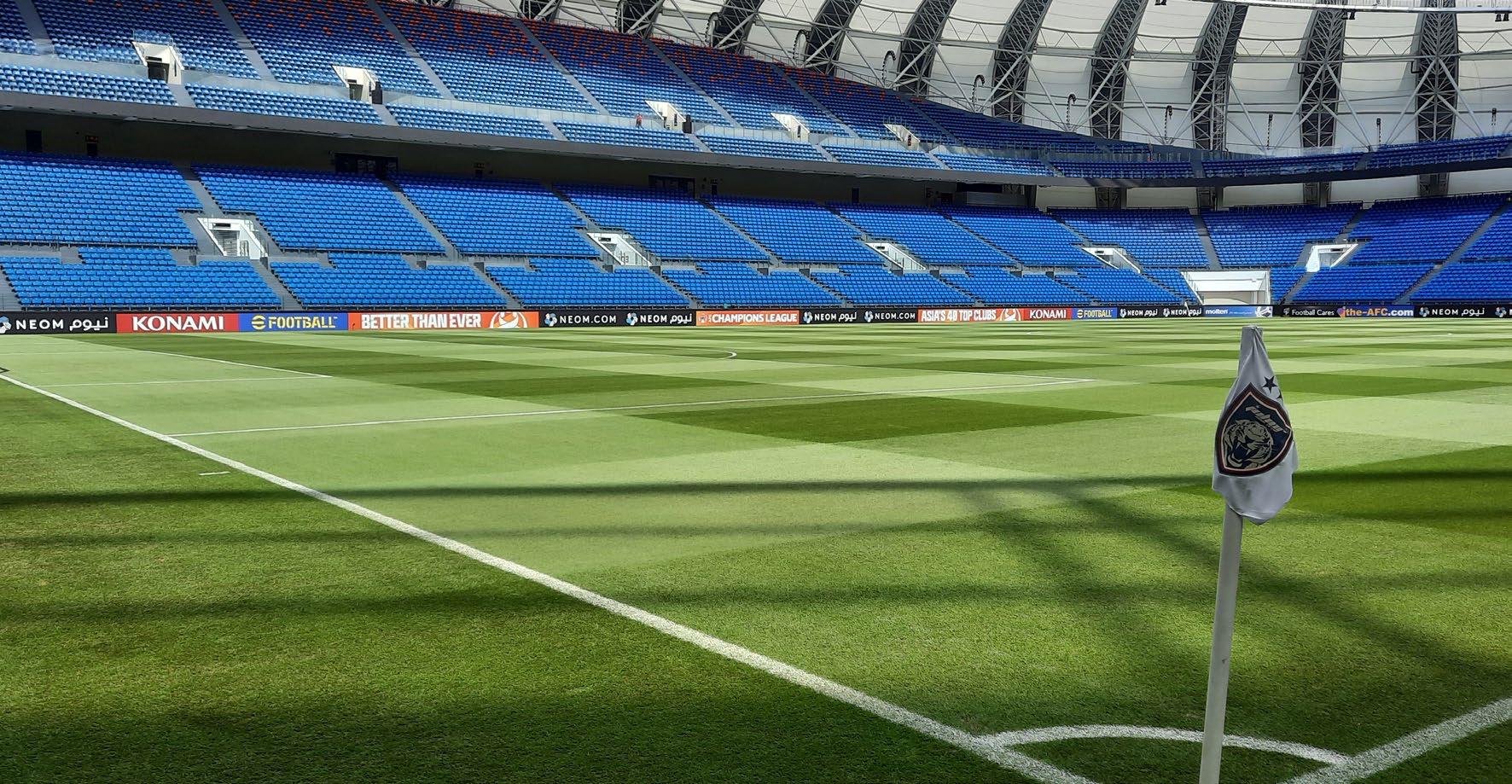
John Sorochan, Ph.D. Distinguished Professor - Turfgrass Science of the University of Tennessee said: “Stadium Zoysia grass and Tifway bermudagrass had similar green turfgrass coverage on every evaluation date except after 24 games, where Stadium Zoysia had greater cover, when receiving 4 games of traffic/week.”
The narrative of success stretches beyond these landmarks to Juventus Football Academies in Vietnam and an upcoming private venue, Tou Kae Noi in Bangkok, Thailand, scheduled to feature BRF Stadium Zoysia by mid-2024. Notably, both Zeon Zoysia (known as Sir Grange Zoysia in Australia) and BRF Stadium Zoysia varieties achieve FIFA playing standards effortlessly, without the need for artificial
backing, stitching, over-seeding or intensive maintenance, thanks to their intricate rhizome structure. This natural resilience enables the grass to recover robustly from extensive play, distinguishing it from other turf varieties that rely on lateral stoloniferous growth.
Sports Turf Solutions’ commitment to enhancing the sports landscape through sustainable turf solutions is evident in these stories of transformation across Asia. For those intrigued by the potential of Zoysia grass and the expertise that STS brings to the table, opportunities to explore these facilities or the operations behind the scenes are openly available. This is replicated in Australia by Lawn Solutions Australia (LSA) R&D with Zoysia varieties including BRF Stadium Zoysia. Both STS and LSA have a strong relationship with Bladerunner Farms which has the world’s
largest zoysia grass breeding collection. The LSA group of turf members produces over 50% of the domestic and commercial turf sold in Australia. This allows LSA to form partnerships with international organisations like Bladerunner Farms to access and research superior turf varieties for the Australian market.
In the evolving world of sports infrastructure, the collaboration between Bladerunner’s innovative turf solutions and Sports Turf Solutions’ visionary application, new turf standards are being set. This partnership not only elevates the playing experience but also redefines the environmental footprint of sports stadiums, proving that with the right foundation, greatness can truly flourish.
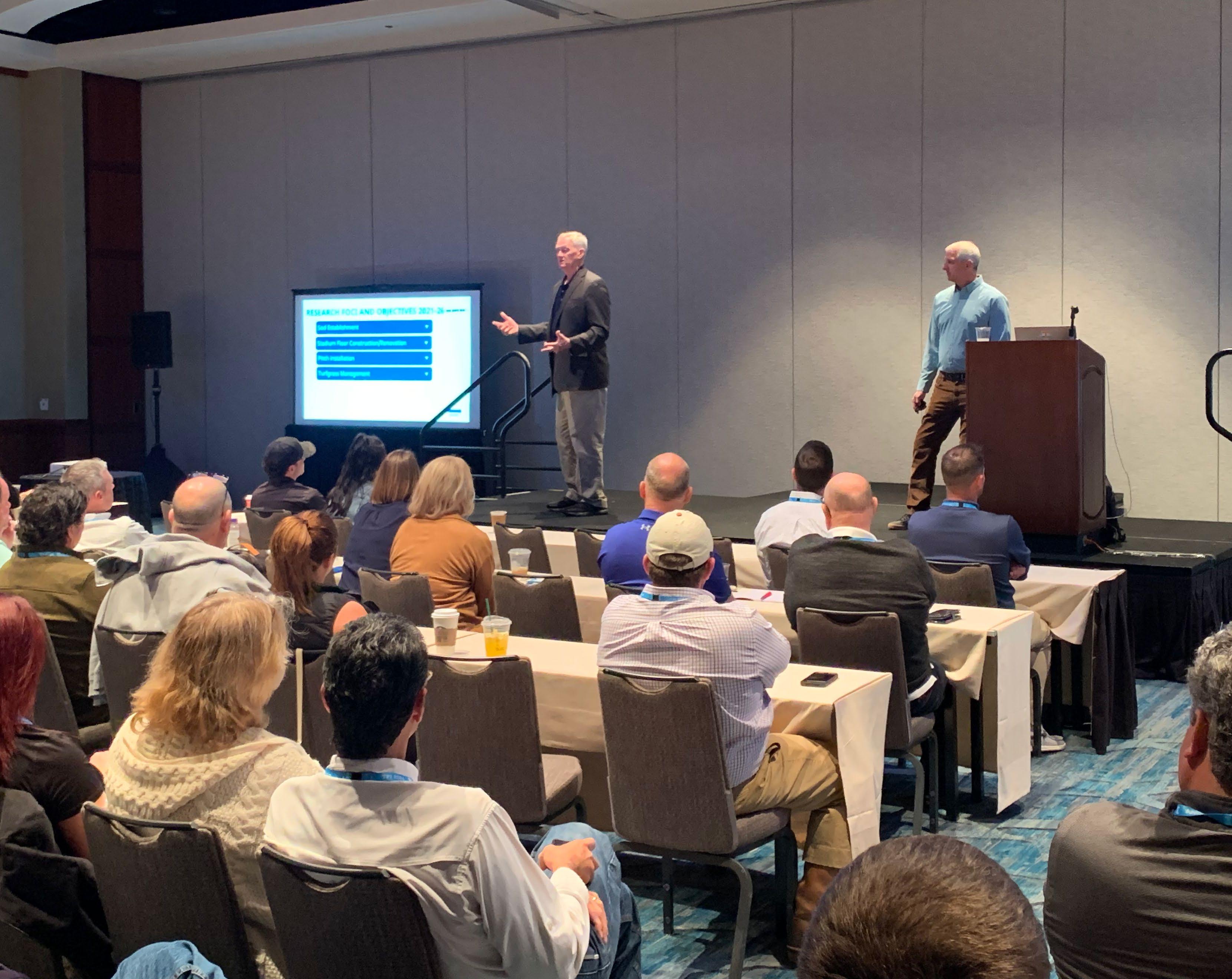
Turf Producers and associated industries from around the globe made their way to Orlando in February to attend the largest turf production gathering in the world. The numbers didn’t disappoint, with over 600 attendees enjoying the Orlando weather, listening to many keynote speakers, and attending the industry field day.
The conference kicked off on Monday morning, the 5th of February, with industry activities involving group visits to a Citrus Farm, biking tours, and agricultural farm tours, with the day finishing with a highpowered presentation about family business and 10 mistakes not to make.
We also managed to fit in a visit to Woerner Turf Farm hosted by Graham Simmons. This
business has several production facilities in Florida, with TifTuf Hybrid Bermuda being a dominant part of their business, with the expansion of this turf variety occurring across all locations.
One of the highlights of the conference was the industry partner tradeshow with over 30 exhibitors relevant to turf production. This event included a social evening with interaction and engagement with people from all parts of the globe, together in a great family spirit.
“TPI was a real eye opener – like-minded people from around the globe focusing on innovation for turf production and how to create a better awareness through marketing – social and online. Some great presentations and conversation.”
The next morning started with education, we headed to the Grand Ballroom to listen to Nathan Whitaker – “Where Great Leaders Are Born” followed by Lesley Kelly – “When Stress is More Than a Season”. This certainly set the scene for the next two days. The rest of the day was filled with presentations on marketing, online media presence, and policy. We joined other turf industry friends from Australia and the US for dinner with a catch-up after many years apart.
It was an early start on Wednesday, the field days are always the best way to see innovation and what’s new. Autonomy is the next biggest innovation to hit the turf industry and we were lucky to see everything that is available and in the pipeline. Floriturf hosted the TPI Field Day and after a 45-minute drive

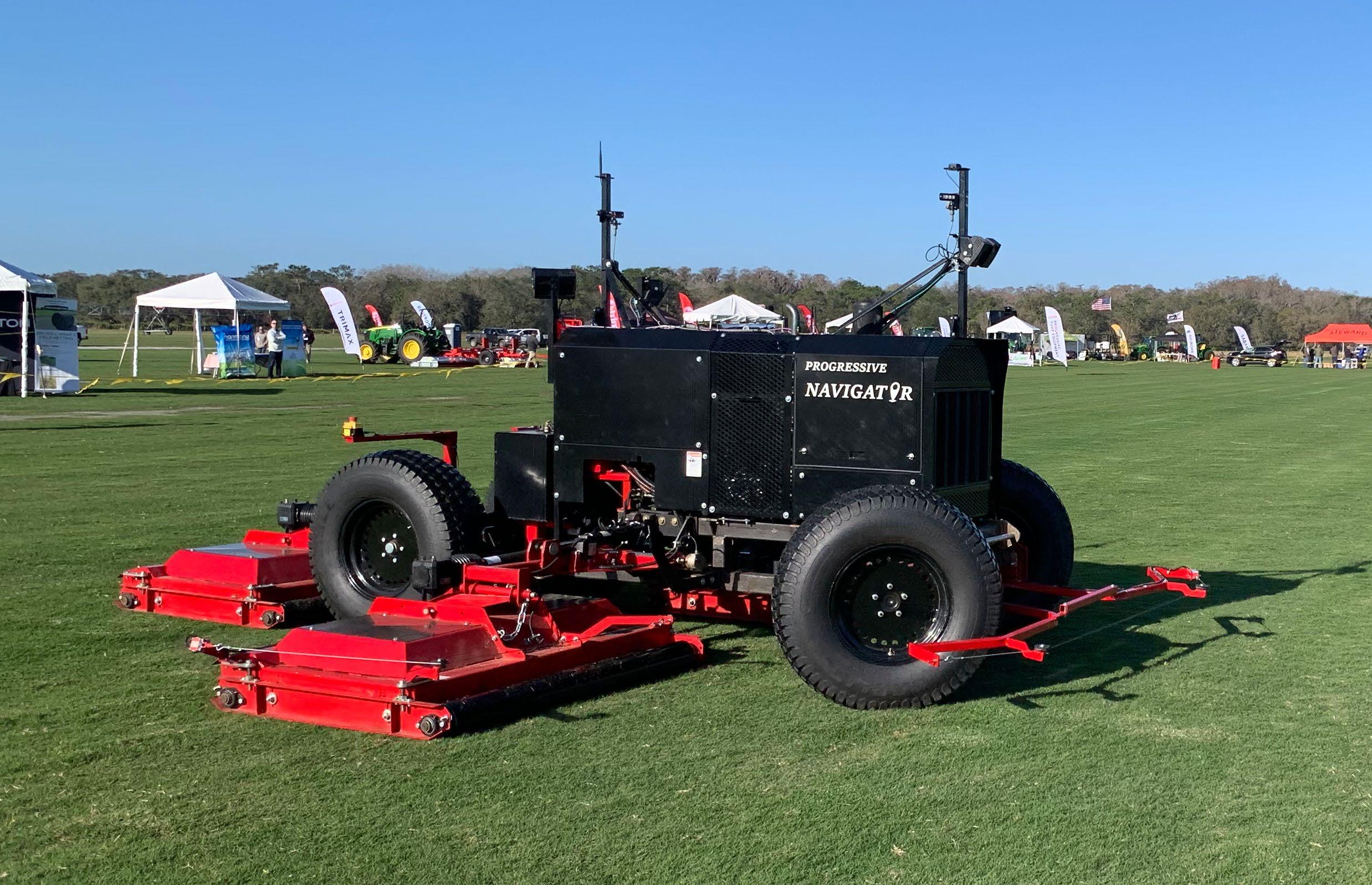
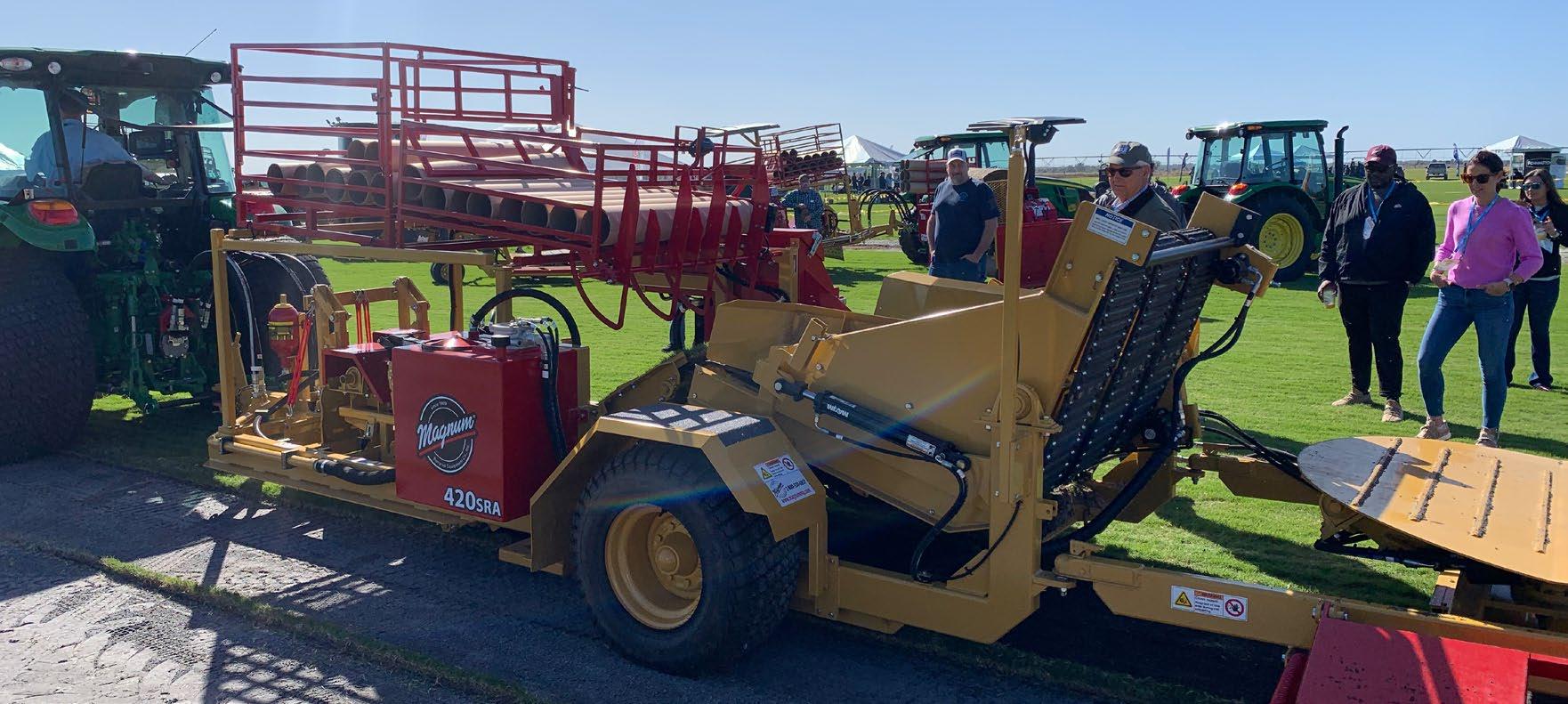
from the hotel, you never get sick of looking at turf farms. The highlight for me was how far in 12 months robotics and autonomous machines have come. With 5 companies previewing their machinery including Progressive Navigator mowers, Monarch battery-powered tractors, Sabanto retrofit fully autonomous technology for tractors, and the FireFly AMP, a battery-autonomous mower, there was so much to see and learn about for future turf production. Finishing up with Trimax Mowers who supports the industry with their leading mower technology and great equipment. Many manufacturers display turf harvesters, mowers, and implements with static displays and demos running for most of the day.
“I have attended many TPI conferences over the years and the key part for me is
the international friendships you build and stay in touch with. This year I was excited to attend the field day to see the technological innovation on display.” - Max Stephenson, Twin View Turf
During the conference, the timing was perfect to arrange meetings with our partners in the US – these included The Turfgrass Group, Bladerunner Farms, SuperSod, and NG Turf, whom we work closely with here in Australia.
The final day of the conference was actionpacked, with Michelle Miller talking about “Social media influencing experience and how do you sell more”. What a story and one I have followed since returning to Australia. Today’s focus was more
on the industry, how is the landscape changing, why is turf valuable, the benefits of sustainability, and managing water use. The impacts of the changing climate and weather on turf production, and does the consumer understand the value and environmental benefit that turf provides? A final topic discussed was leasing land to grow turf and making sure you have everything correct in the leasing agreement to avoid costly ongoing problems for your business, which is an important topic both here in Australia and the US.
For all in attendance, the last presentation was about the FIFA World Cup in the USA. Over the last 3 years, work has been conducted on soil profiles, turf varieties, usage, maintenance, training facilities,
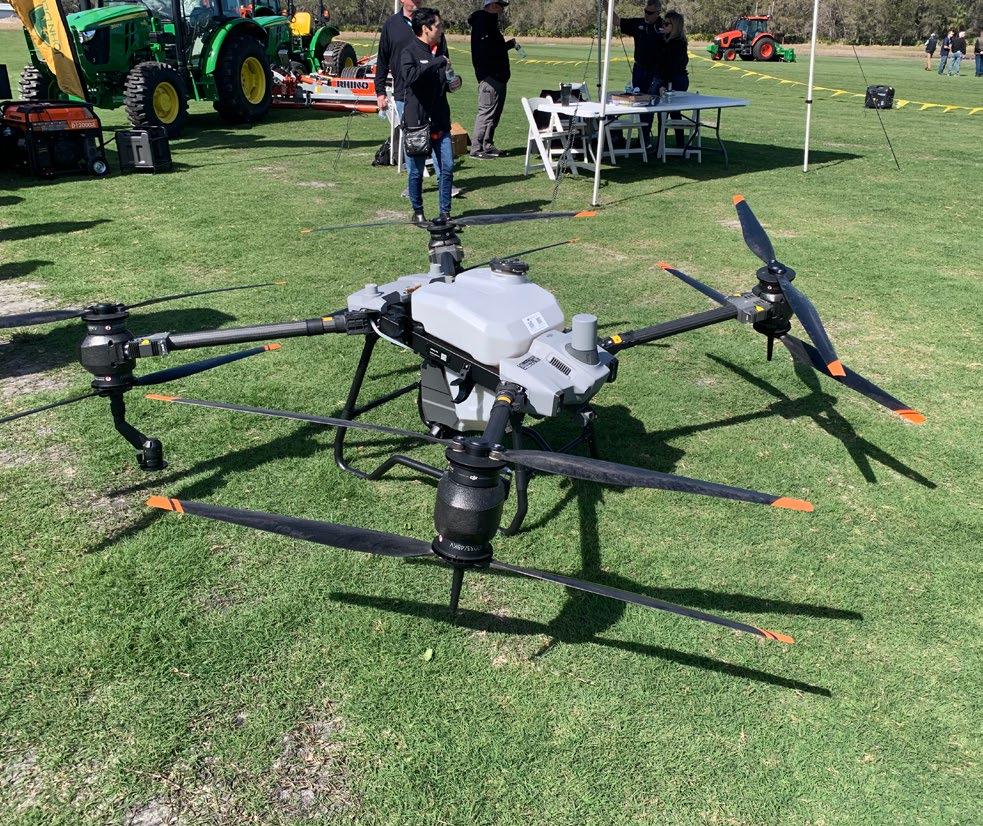
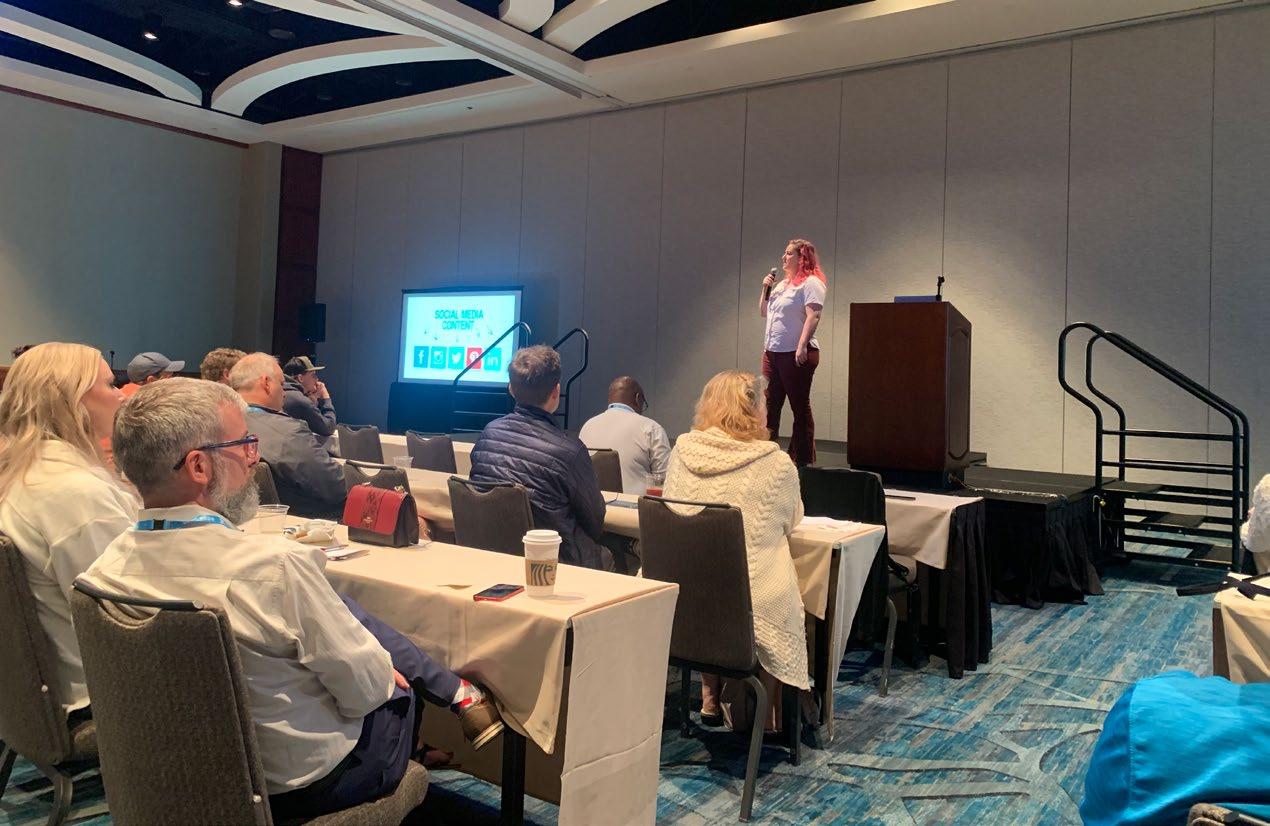
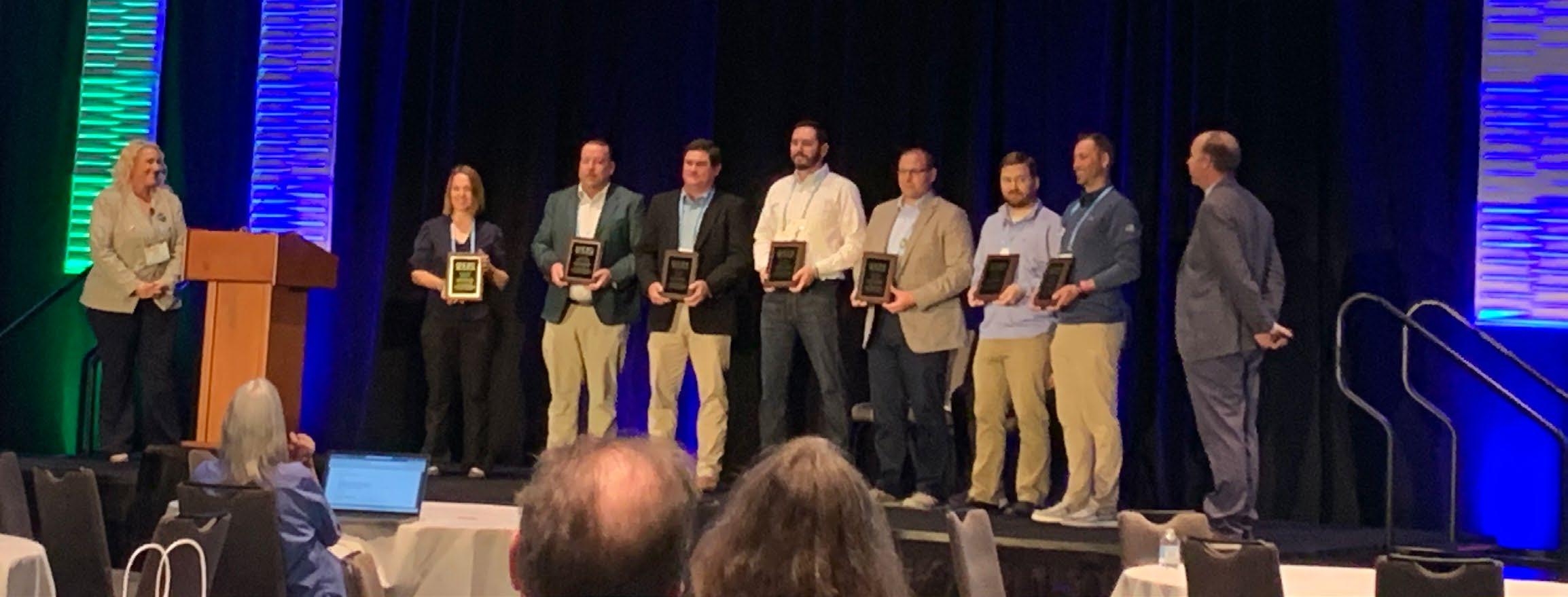
game day facilities, the housing of players, and transportation – it’s huge. The main takeaway for the turf production industry is that FIFA needs around 200 facilities for the World Cup. Natural turfgrass is going to play a massive role in this event. The main talk was how you can plan on the farm for this, can our business grow enough turf, and whether we can meet the timeframe for production. There was no definitive answer as to how things unfold, but what we do know, is that natural turf is a crucial part of this event and there are going to be many people within the industry busy for several years helping to achieve the outcomes required. The industry must work together to deliver the best sports turf surfaces, which is the key objective.
As the conference approached its conclusion, the final afternoon sessions were very interesting, starting with the Annual Business Meeting and lunch, then onto turf innovation. This included ‘10
ideas in 50 minutes’ which was a great presentation providing a look through the eyes of the younger generation and how we can continue to innovate.
Thursday concluded with the ‘Board Show & Tell’ which made this Australian really sit back and think about expansion and the pure size of turf production in the US. Georgia has some massive turf production operations spread across several locations. Turf isn’t just about growing and watering, you must have experience in marketing, sales, customer service, logistics, human resources, and legal matters, and manage a team of staff to achieve the business’s strategic direction and growth. All this, while ensuring you have the best turfgrasses that can meet consumers’ needs and are environmentally sustainable.
“I appreciate the long association with key friendships, exchanging of ideas and being able to get in touch at any time if needed.
TPI has been an integral part of the Lilydale Instant Lawn success – learning, knowledge and working with machinery manufacturers to purchase the latest technology.” - Garry Lusk, Lilydale Instant Lawn
I would like to thank the Turf Producers International team led by Casey Reynolds CEO; it was a fantastic conference built around friendship, learning, ideas, and how this industry globally can connect as one to build long-lasting relationships. I would like to thank our Australian counterparts who attended the conference, it was great to join together after the event for dinner before heading back home.
I look forward to the TPI Conference & Field Day 2025 in San Antonio, Texas on the 9-13th of February, in particular the field day which will be held at Bladerunner Farms hosted by David Doguet.
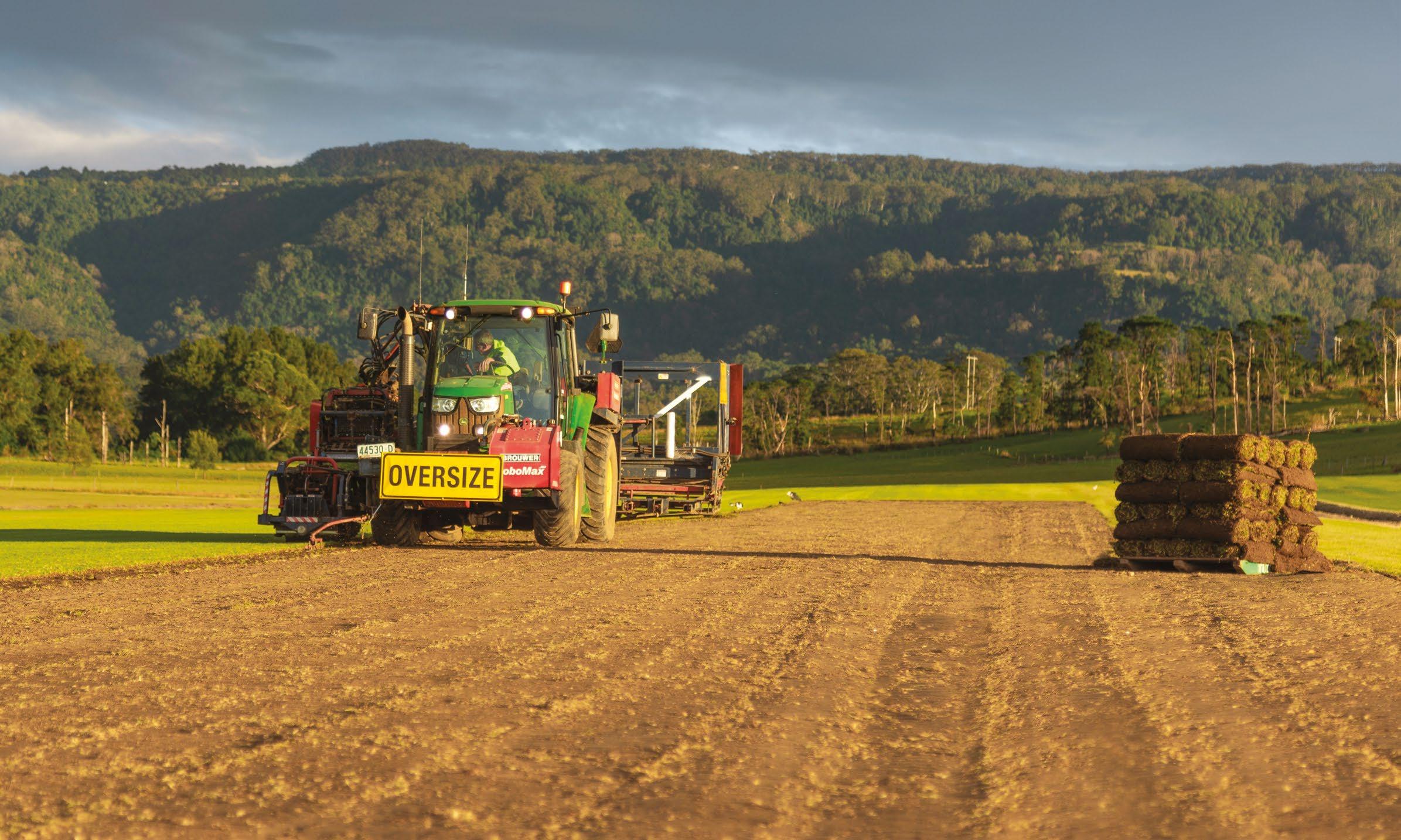

The Smart Approved WaterMark (SAWM) by the Water Conservancy is the first water efficiency accreditation scheme in the world to recognise drought-tolerant turf.
The Smart Approved Watermark was established by the Water Services Association of Australia (WSAA), Irrigation Australia, The Nursery and Garden Industry Association and the Australian Water
Association, to provide an identifiable label for consumers so that they can make informed choices when choosing products, services and organisations that use water efficiently, reducing per capita water consumption and helping in the end goal of preserving such a precious resource.
In 2017, Lawn Solutions Australia applied for the Smart WaterMark Approval for
TifTuf Hybrid Bermuda, with the Water Conservancy. TifTuf has led the way with independent testing through the Sports Turf Research Institute (STRI) with significant trial data provided in its application demonstrating its superior drought tolerance characteristics. As a result, TifTuf was awarded the Smart Approved WaterMark, but with an
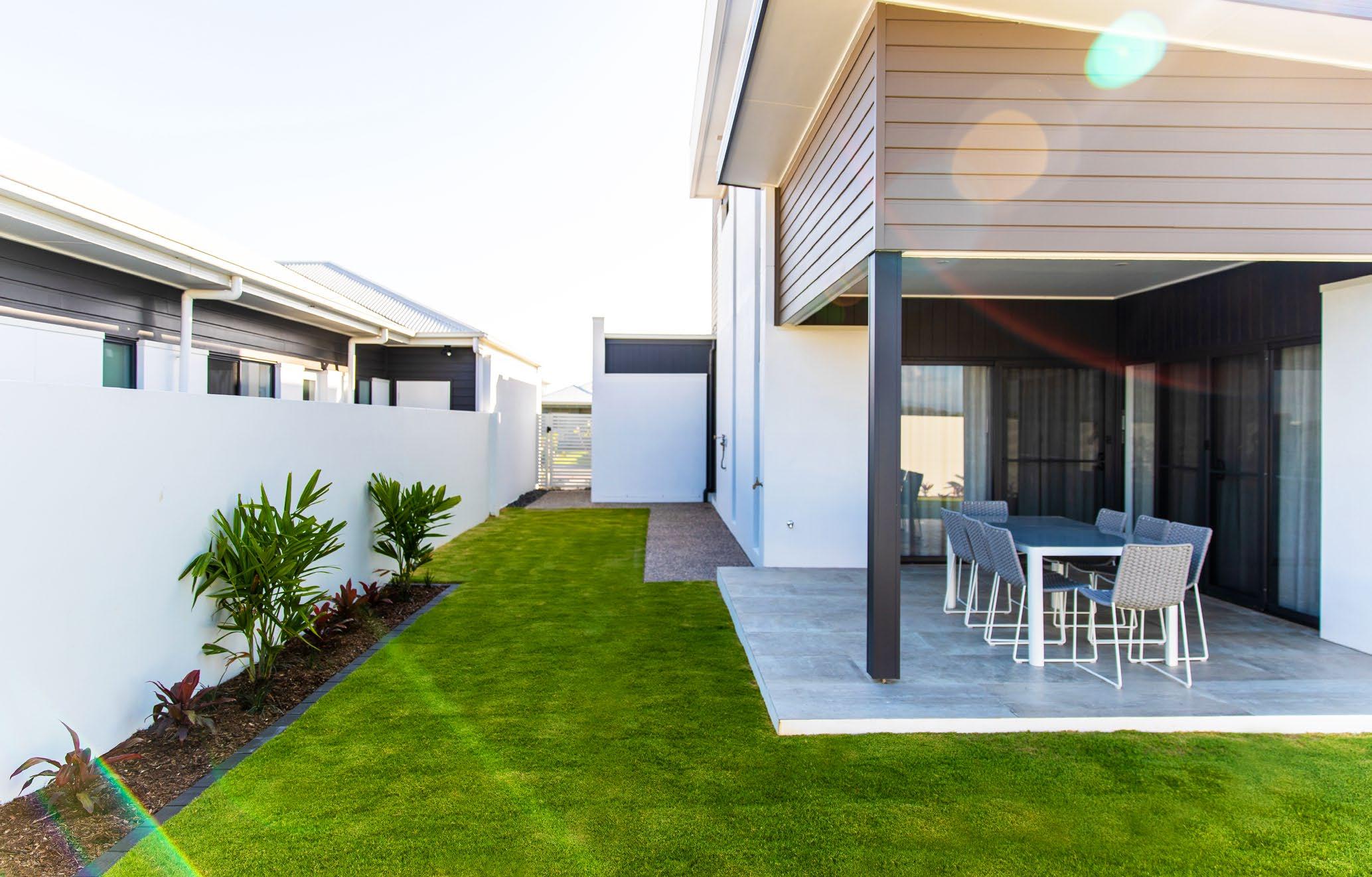

exemption for Western Australia and the Northern Territory with data yet to be finalised for performance in these states and territories at the time.
Additional testing data was submitted to SAWM on the 23rd of February 2024 and was presented to the SAWM Expert Panel for deliberation.
TifTuf Hybrid Bermuda Grass has now been approved by Smart Watermark’s Independent Expert Panel Nationally within Australia. The restriction has been lifted in Western Australia as well as in the Northern Territory from further testing results received.
TifTuf Hybrid Bermuda is the first and only turfgrass to receive this for drought tolerance in Australia or anywhere in the world.
TifTuf Hybrid Bermuda is part of a greater stable of turf varieties supplied nationally through the Lawn Solutions Australia (LSA) network. Members of LSA are the only turf suppliers who can supply the Smart WaterMark Approved TifTuf Hybrid Bermuda to the Australian market.
1974
Back in 1974, Robert ‘Bob’ Agland made the unexpected decision to leave his career as a welder and become a turf farmer. He loved the outdoors and longed for a career that involved less travelling and shorter hours.
At the time, he lived in Berkeley Vale on the Central Coast with his wife Annette and their 2 daughters, Margaret and Vicki. He travelled daily into inner Sydney for work, relying solely on train transport to get to and from work as well as moving from job to job during the day. He got tired of all the travelling and long hours and was busting
to spend more time outdoors. He wanted to work closer to home, with less travelling and therefore shorter days. When the opportunity arose for him to purchase a turf farm, he just couldn’t say no.
In June 1974, Bob Agland purchased a turf farm in Wyong and started ‘Agland Turf’ as a business. The property was an established turf farm with common Kikuyu and a small amount of Couch already growing and Bob kept on all the previous owners’ staff when he took over to assist him with the running of his new
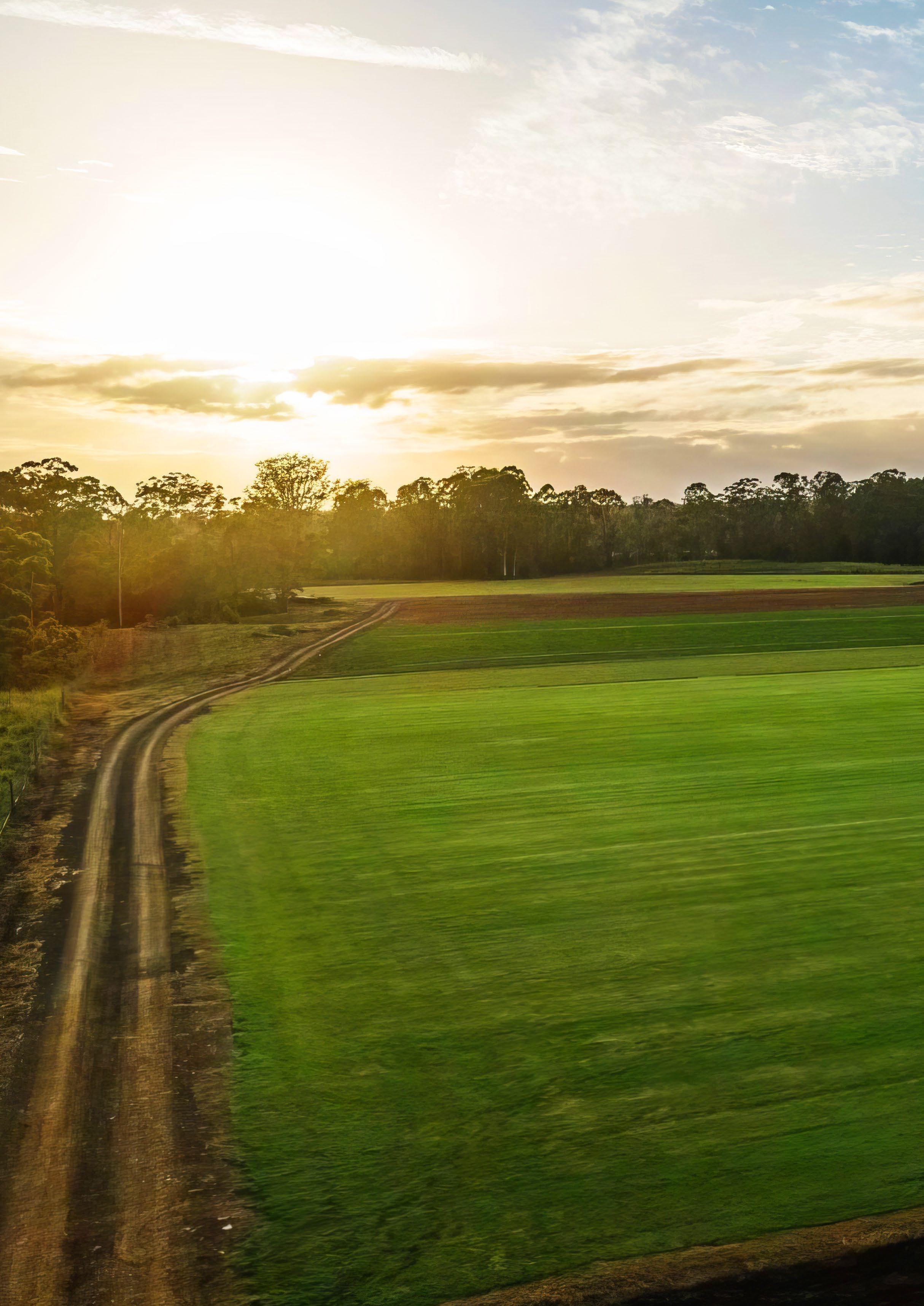
business. The property purchase included a turf cutter; however, all turf deliveries were made using a trailer. Bob eventually acquired a delivery truck to make the whole delivery process more efficient.
In February 1981, Bob moved his family to Dumeresq Island near Taree on the mid North Coast. He purchased a former dairy farm and had to start from scratch to establish his turf business again. Due to the constant flooding of the Manning River across his property, Bob moved his family again in February 1984. This time they
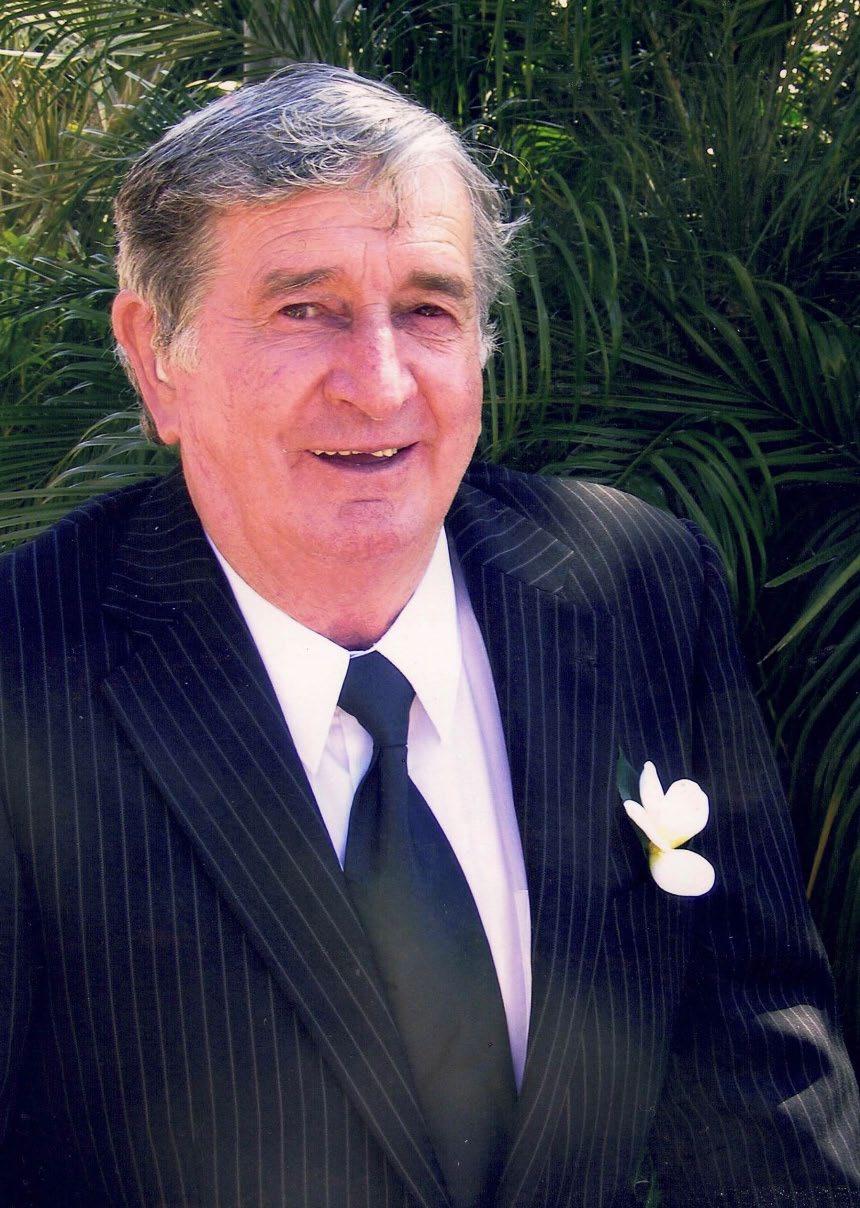

purchased a house in Nabiac on the Mid North Coast and leased local paddocks for the turf business. Bob and Annette lived in Nabiac for the next 18 years, expanding their business and watching their family grow.
In 1997, Bob’s son-in-law, Wayne Griffis, began working alongside Bob to gain valuable insight into the turf industry and to learn the process of producing and harvesting turf. Wayne grew up on his family’s dairy farm in Dyers Crossing just outside of Nabiac. After leaving school, he acquired his trade certificate in dairy
management and went on to work on various local dairy farms over the years. He had experience in pasture production for cattle as well as fertiliser and chemical experience but knew very little in the way of turf production and management.
In 2000, Bob’s health deteriorated, and Margaret and Wayne purchased the ‘Agland Turf’ business where Wayne put his newfound skills and knowledge into action. Bob and Annette moved away from the area and headed out west to Gunnedah to relieve Bob’s health symptoms. They
moved back to the area in 2009 to be closer to their family before Bob sadly passed away on the 25th of May 2012.
In 2002, Margaret and Wayne purchased their current property at 520 Dargavilles Road, just outside of Nabiac and began preparing the paddocks for planting. Later that year they planted their first buffalo turf variety, Palmetto Buffalo.
Agland Turf registered as a member of the Lawn Solutions Australia network in 2022 for their amazing grower support,
50
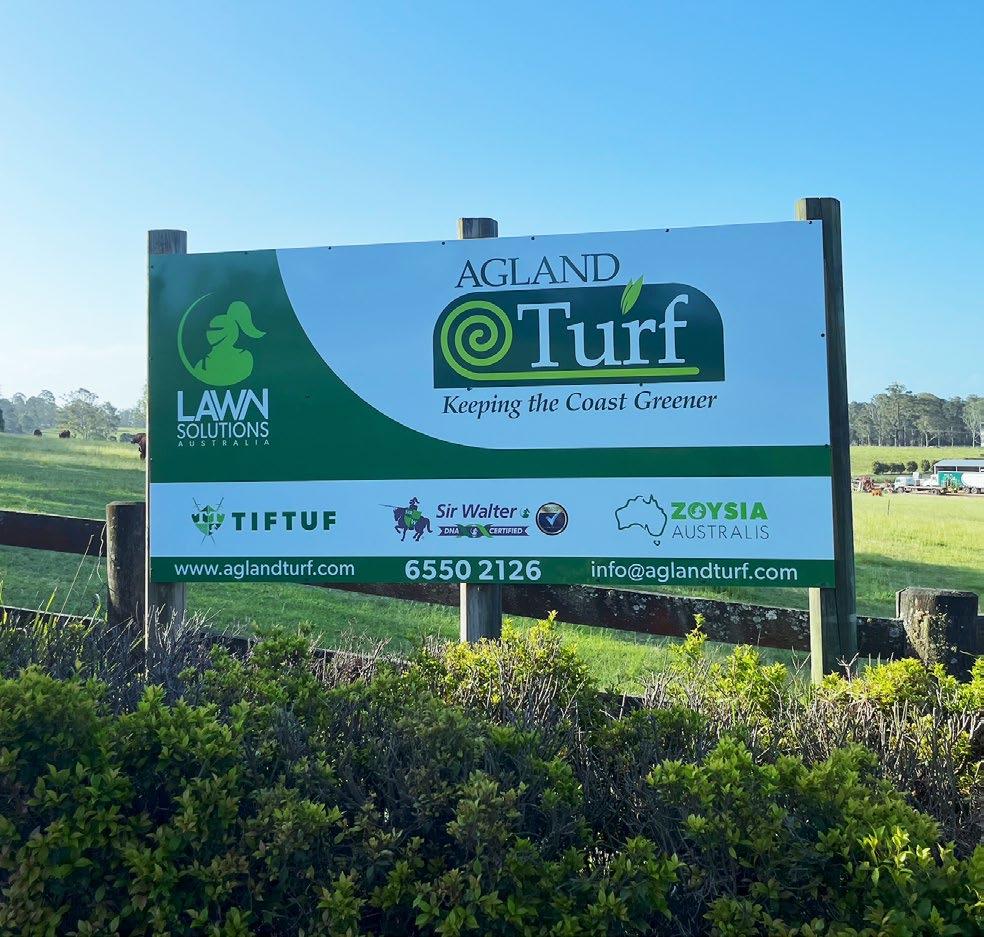
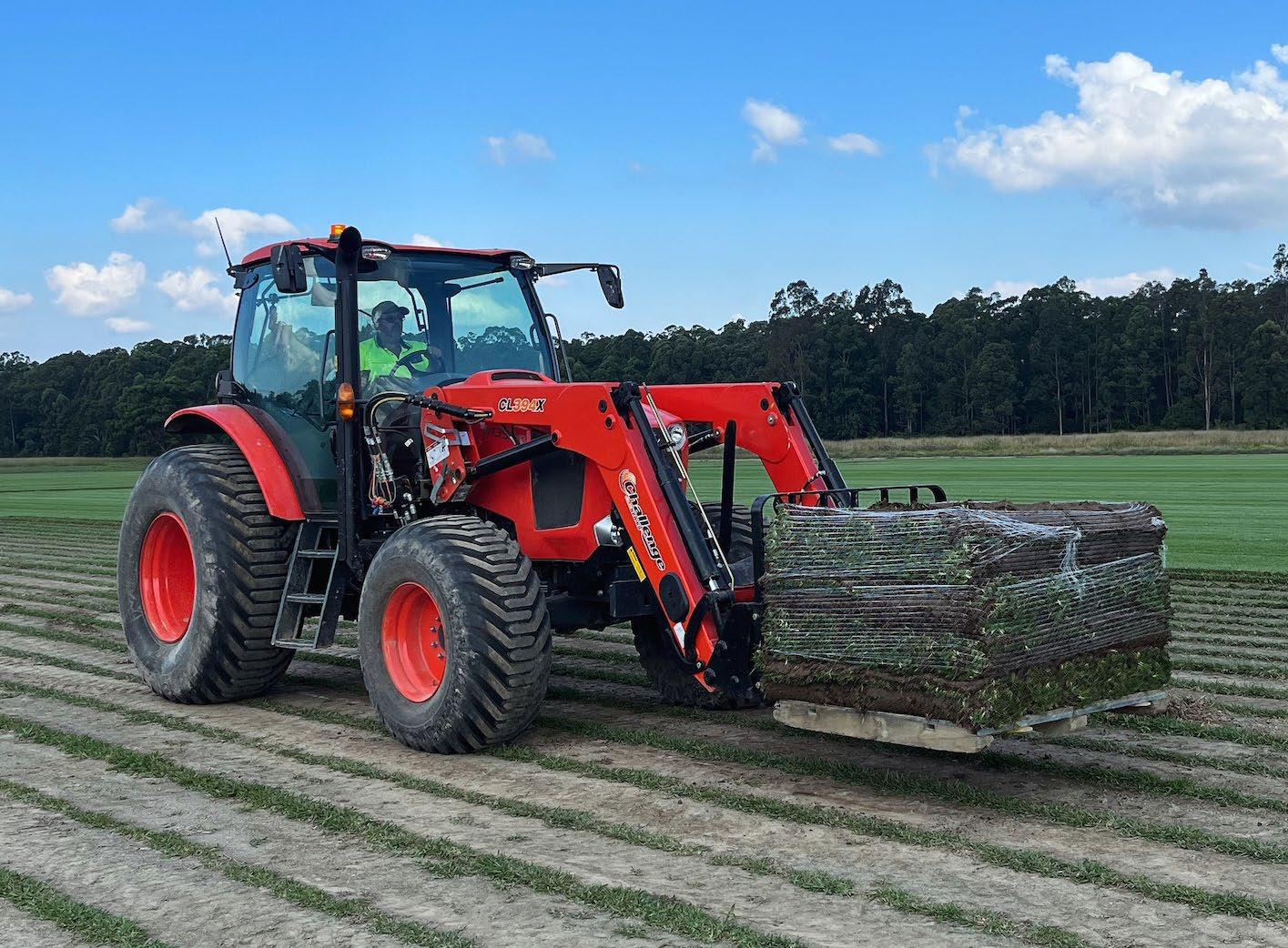
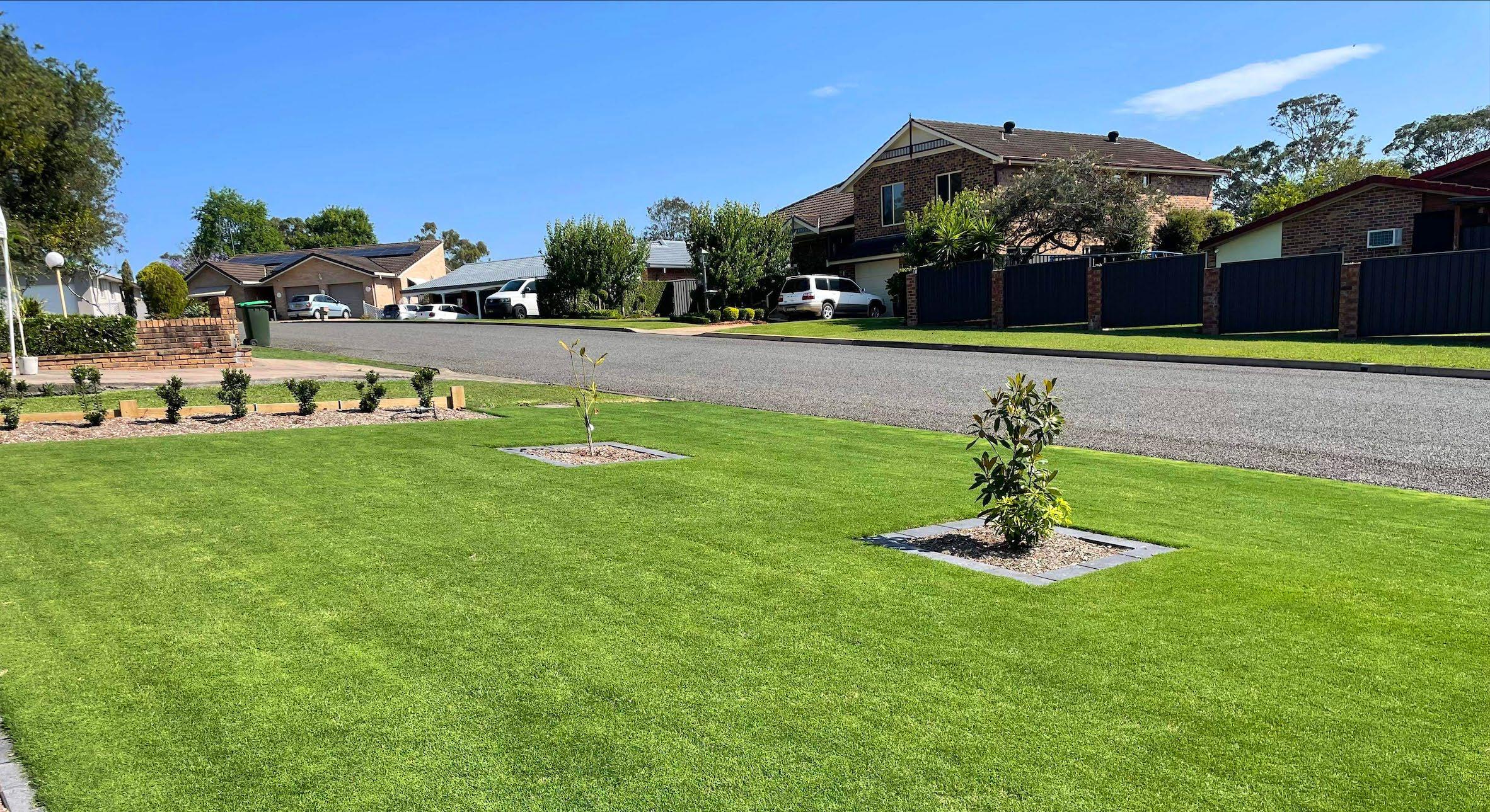
not to mention their premium varieties of turf. Agland Turf soon gained AusGAP accreditation after planting their first turf variety from Lawn Solutions Australia, a paddock of TifTuf Hybrid Bermuda. In February 2023, they planted Sir Walter DNA Certified Buffalo followed by Zoysia Australis in April the same year.
Margaret and Wayne together have four boys with their eldest son Aaron starting work on the farm in 2015 after finishing school. He is now Agland Turf’s AUSGAP Certified Representative (ACR) and ensures all of the turf varieties adhere to a stringent
set of quality standards. In 2019, their third-born son Matthew began working for the business. He mainly works behind the scenes on the farm ensuring all turf varieties are to the highest quality before harvesting. Their 2 other children, Joshua and Kye, both occasionally work for the business however wish to pursue different career paths.
In 2018, Margaret and Wayne purchased another former dairy farm just up the road from their home, along the beautiful Wallamba River where they are now growing TifTuf Hybrid Bermuda, Sir Walter DNA Certified Buffalo and Zoysia Australis.
50 years on, Agland Turf now supply a range of premium quality LSA turf varieties and lawn care products to customers right along the Mid North Coast and down to the Hunter Region of New South Wales. Agland Turf pride themselves on growing and supplying exceptional quality turf to suit a variety of applications including sports fields, parks, golf courses and residential lawns, and are proud to remain a family owned and operated business, thankful for Bob’s wild decision to pursue his dreams all those 50 years ago.

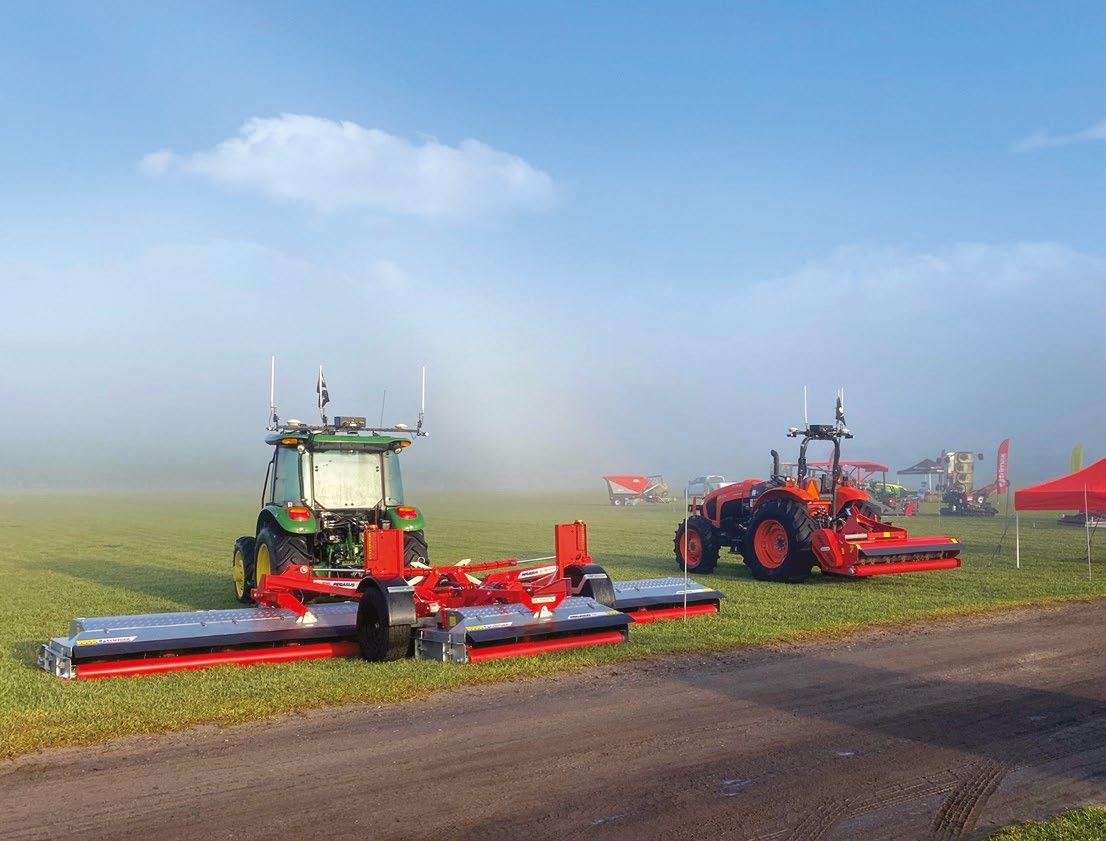
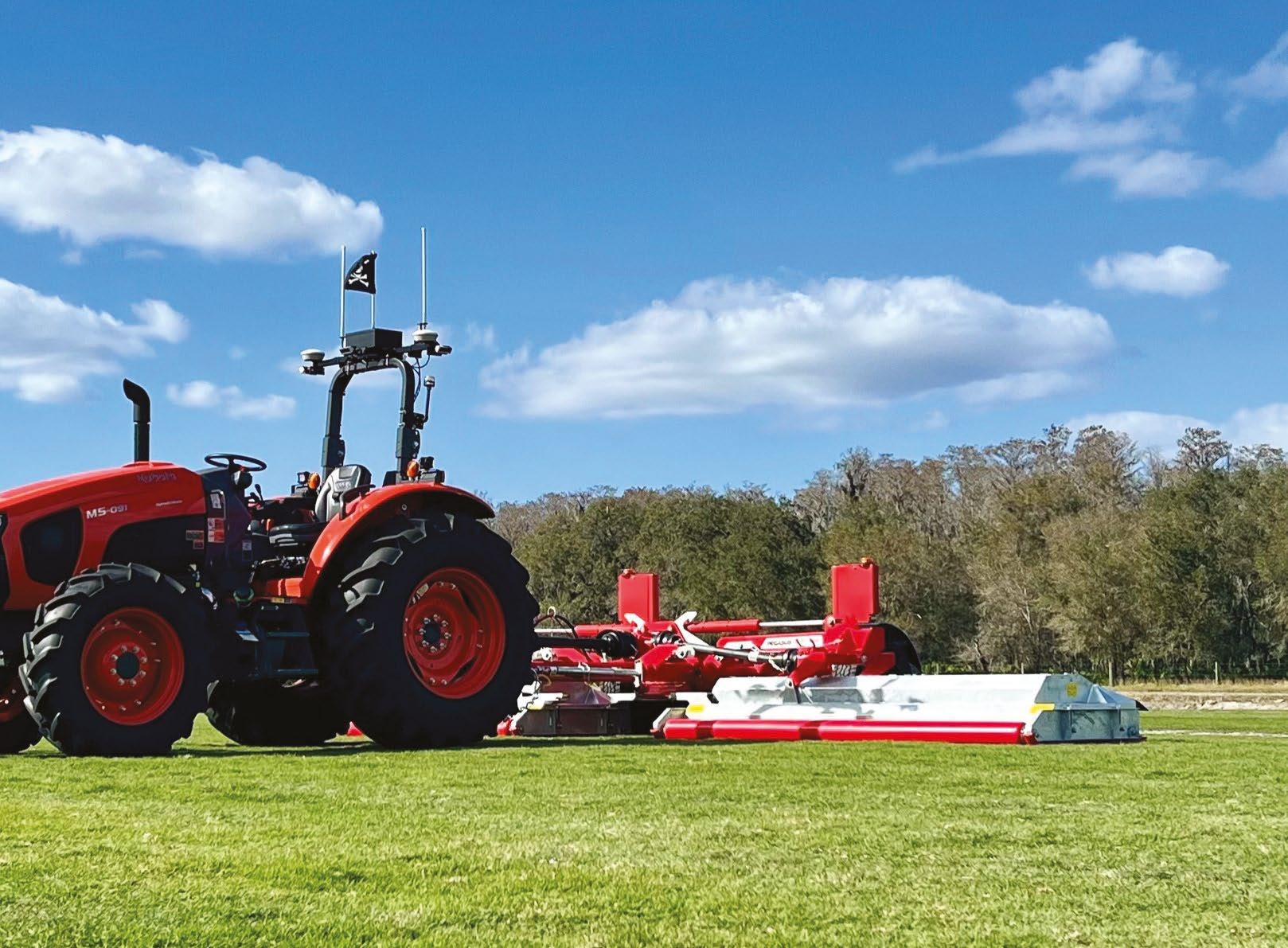
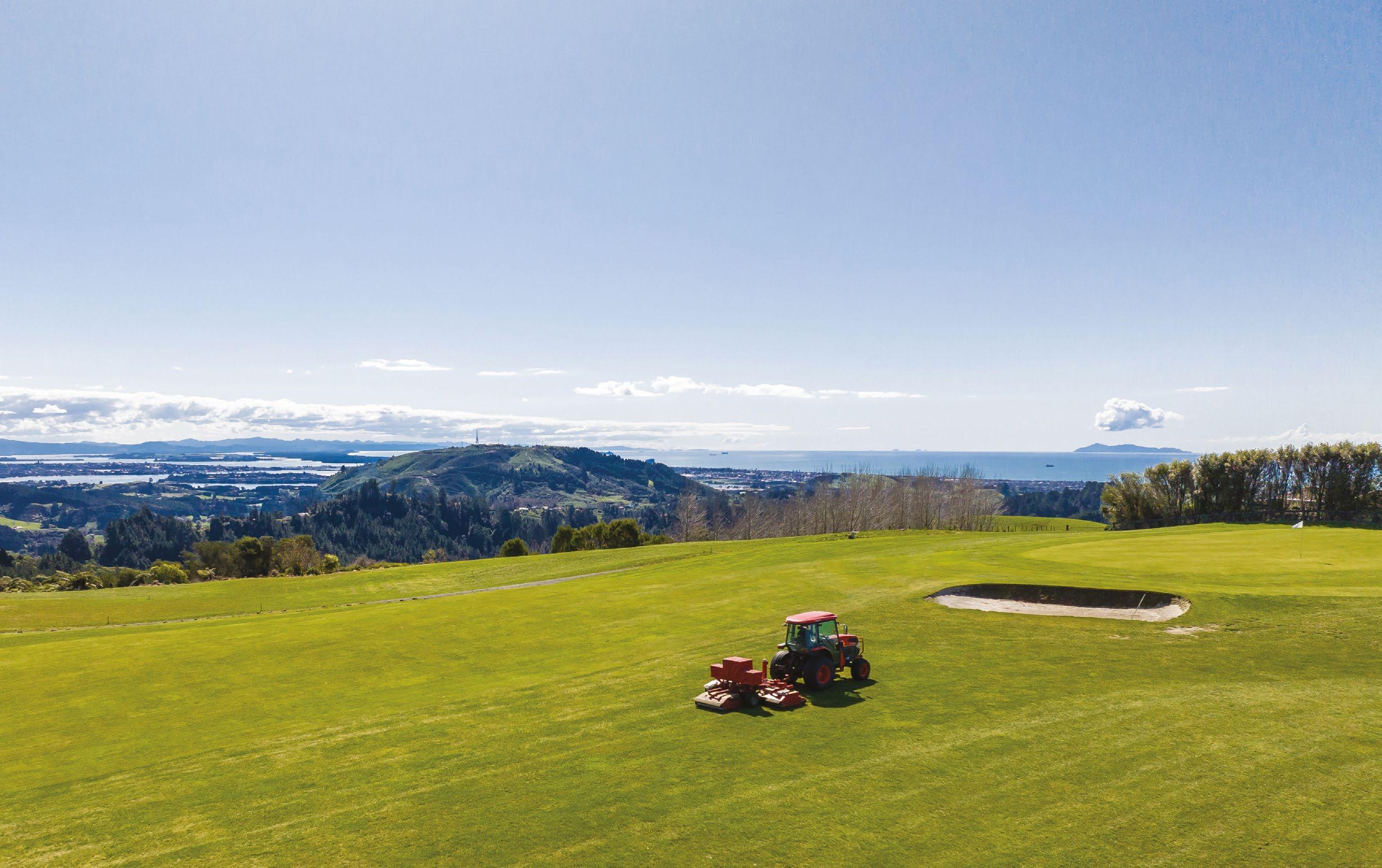
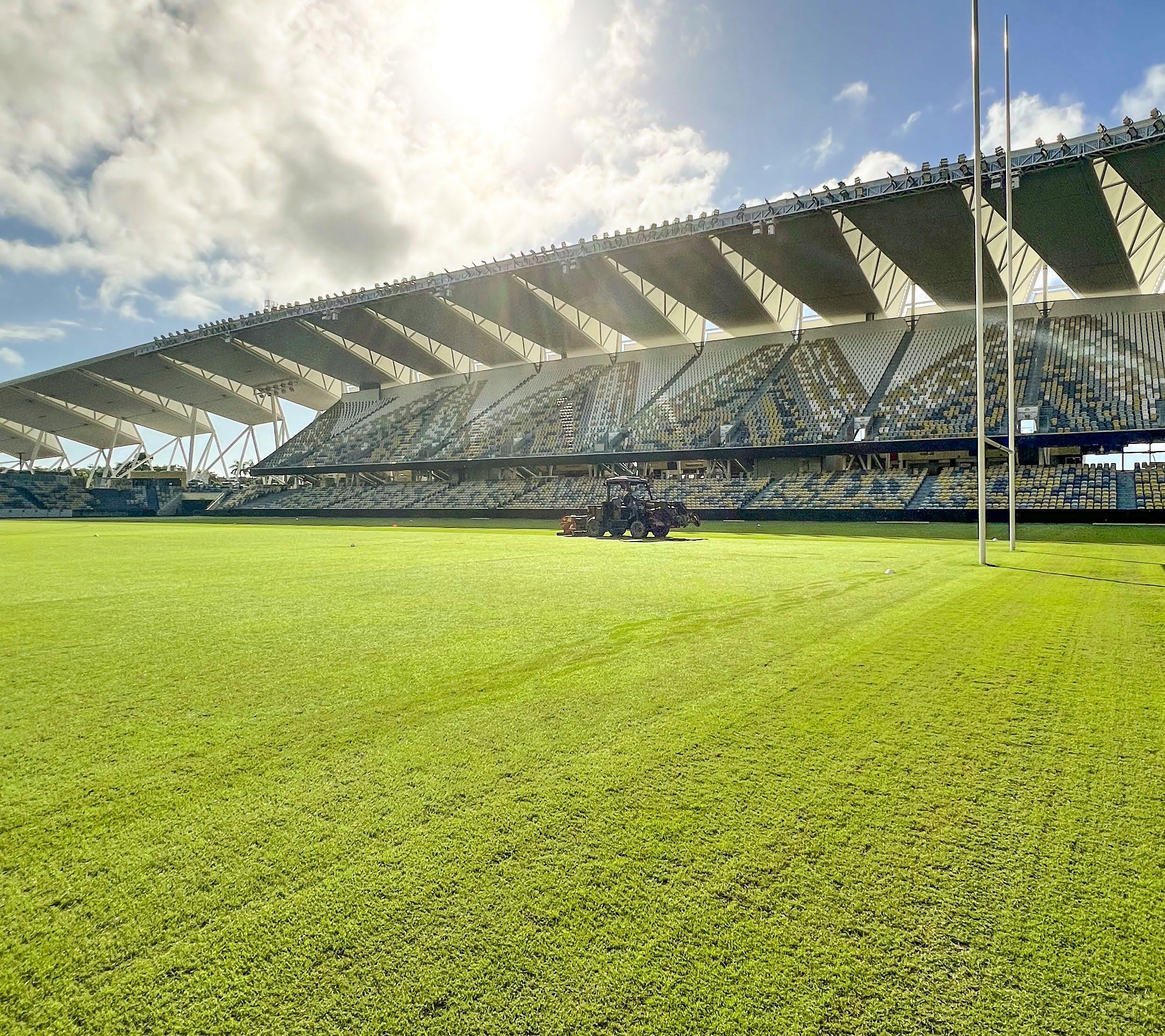
A top stadium groundsperson has successfully pivoted his career in the in-demand greenkeeping industry, after studying at TAFE NSW.
The greenkeeping industry is set to grow by 1,400 jobs by 2026, and TAFE NSW is delivering a pipeline of workers to the sector through its sports turf management courses.
Adam McNeill grew up on the NSW south coast and studied horticulture at TAFE NSW about 20 years ago. As an apprentice, he worked at the Sydney Cricket Ground and Sydney Football Stadium, before returning to the south coast to work for local councils.
“I then followed my mentor Bruce Fouracre up to Townsville to work at the city’s old 1300SMILES Stadium, before transitioning to the new Queensland Country Bank Stadium and have had amazing experiences preparing the venue for everything from Cowboys matches and the State of Origin game in 2021, to Pink’s concerts this year,” Mr McNeill said.
To ensure longevity in the industry, in recent years Mr McNeill looked to grow his skills.
“The further into my career I travelled, I recognised I needed a Diploma in Sports Turf Management qualification to transition
to managerial roles and grow my career as I get older,” Mr McNeill said.
“I returned to study, originally in Victoria; but due to complications during the COVID-19 pandemic, I returned to TAFE NSW and completed my studies.
“I now have the practical and theoretical skills needed to pivot my career in this industry as a Senior Groundsperson at Queensland Country Bank Stadium.”
Mr McNeill said the diploma has helped boost his contribution to the success of the world-class stadium.

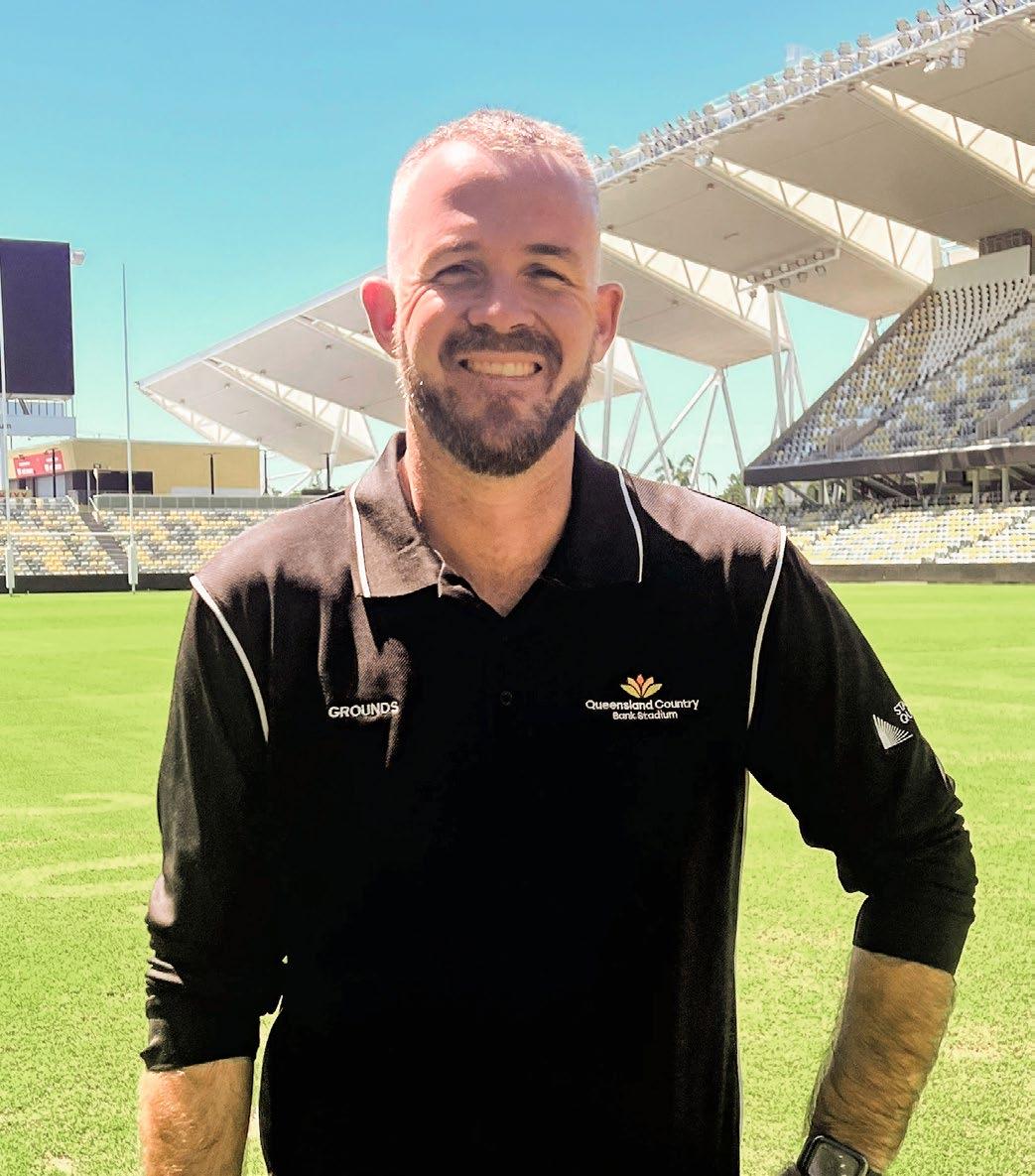
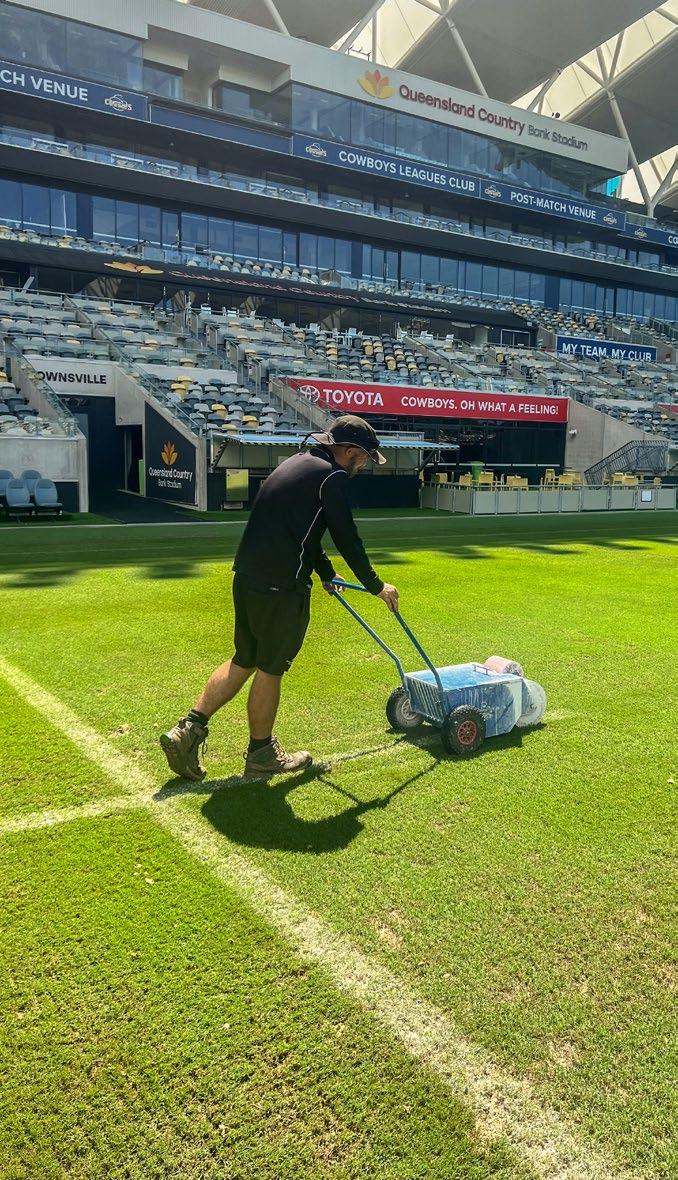
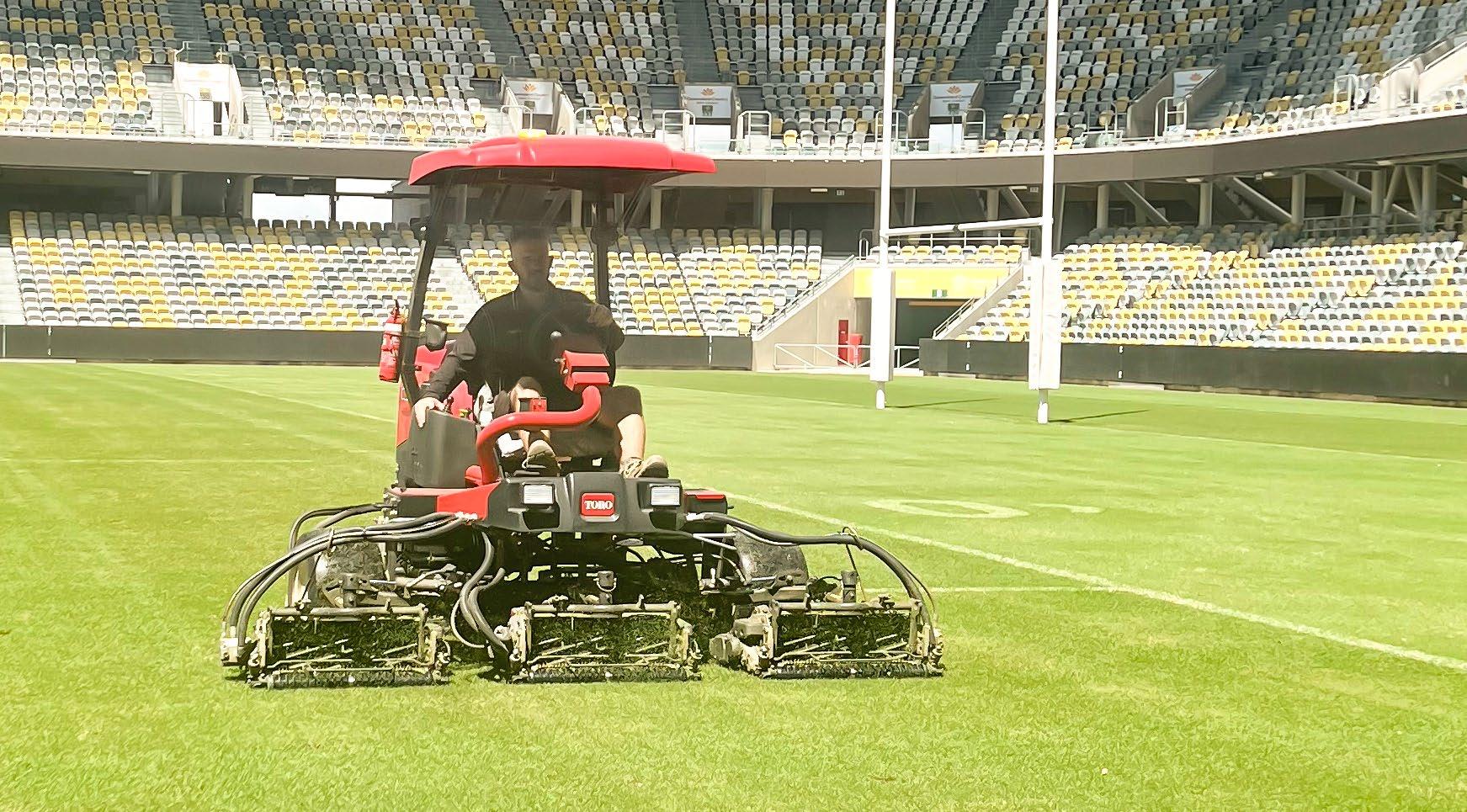
“I’m now taking on more responsibility, I’ve enhanced my time management skills, and now have deeper insights into the managerial duties that are required to effectively coordinate the care of the arena surface at a major stadium,” he said.
Head Teacher of Sports Turf Management at TAFE NSW, Ian Clarke, said the organisation is delivering skilled groundspeople to the industry.
“Through the Diploma of Sports Turf Management program, we ensure our students are equipped with the practical skills and theoretical knowledge they need to get the
job they want - whether that be at a local golf course, or at top-level venues like Queensland Country Bank Stadium,” Mr Clarke said.
“It’s pleasing to see Adam continue to succeed in the industry, having returned to TAFE NSW to diversify his skills and pivot his career direction in sports turf management.”
Mr McNeill is an advocate for more people studying sports turf management to meet the industry’s demand for workers.
“It is a fascinating career and I find it rewarding and satisfying,” he said.
“Turf is a living organism, and we keep asking so much of it; but when you can walk away and look at the product we’ve produced for an event, whether that be an NRL game or a concert, that’s when you get that sense of achievement.
“I feel incredibly fortunate to work in a new, major stadium. There are only a handful of venues of this calibre in Australia, so I take very seriously the responsibility of creating a product that’ll be viewed by thousands of people.”
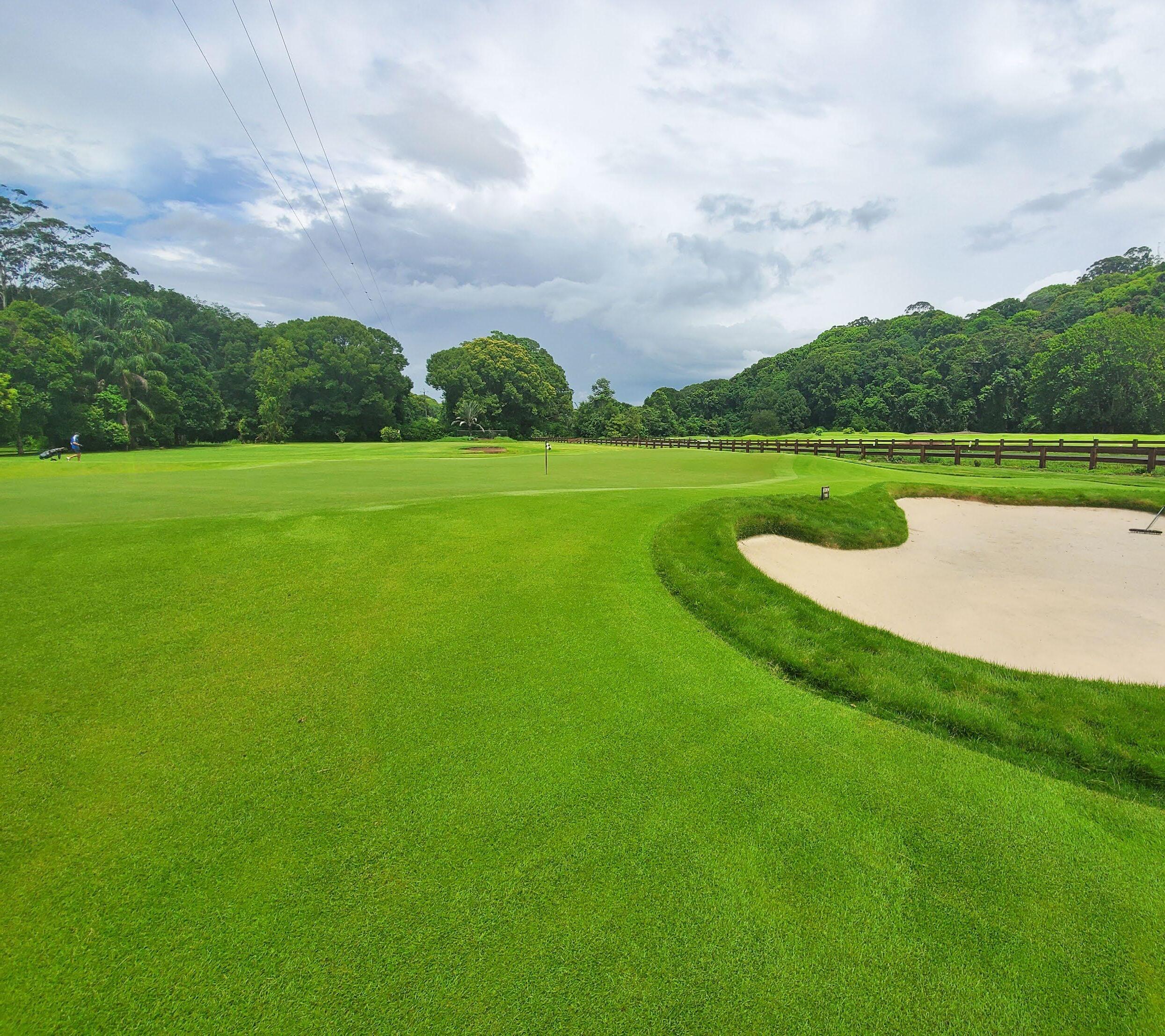
UNPARALLELED TURF QUALITY WITH AUSGAP
The choice of turfgrass can significantly impact the success of a project especially in commercial landscaping. AusGAP certification is a mark of quality and consistency in turfgrass production, promoting the highest industry standards. When planning a commercial landscape value for money as well as being fit for purpose are usually at the forefront of decision making.
The upfront investment for AusGAP certified turf pays dividends in the long run. You avoid the possibility of turf substitution
which unfortunately still happens within the industry. AusGAP certified turf varieties have been developed and researched for decades to be lower input, more environmentally adaptable and to perform better in high stress situations. Unlike lowerquality turfgrass varieties that may require more watering, fertilisation, and pest control treatments, AusGAP certified turf is proven to be more robust than other common turfgrass varieties, reducing the need for ongoing interventions and expenditures. By requiring less water, fertilisers, and pesticides, AusGAP certified turf not only saves businesses money on input costs
but also minimises the environmental impact associated with excessive chemical usage. Additionally, the low maintenance requirements of AusGAP certified turf can translate into significant time savings for property owners and maintenance teams, allowing them to focus resources on other critical aspects of property management.
Enhanced aesthetic appeal and property values
High-quality turf enhances the visual impact of a landscape and can add significant value to real estate. Due to the better performance of new and improved turf than older turfgrass

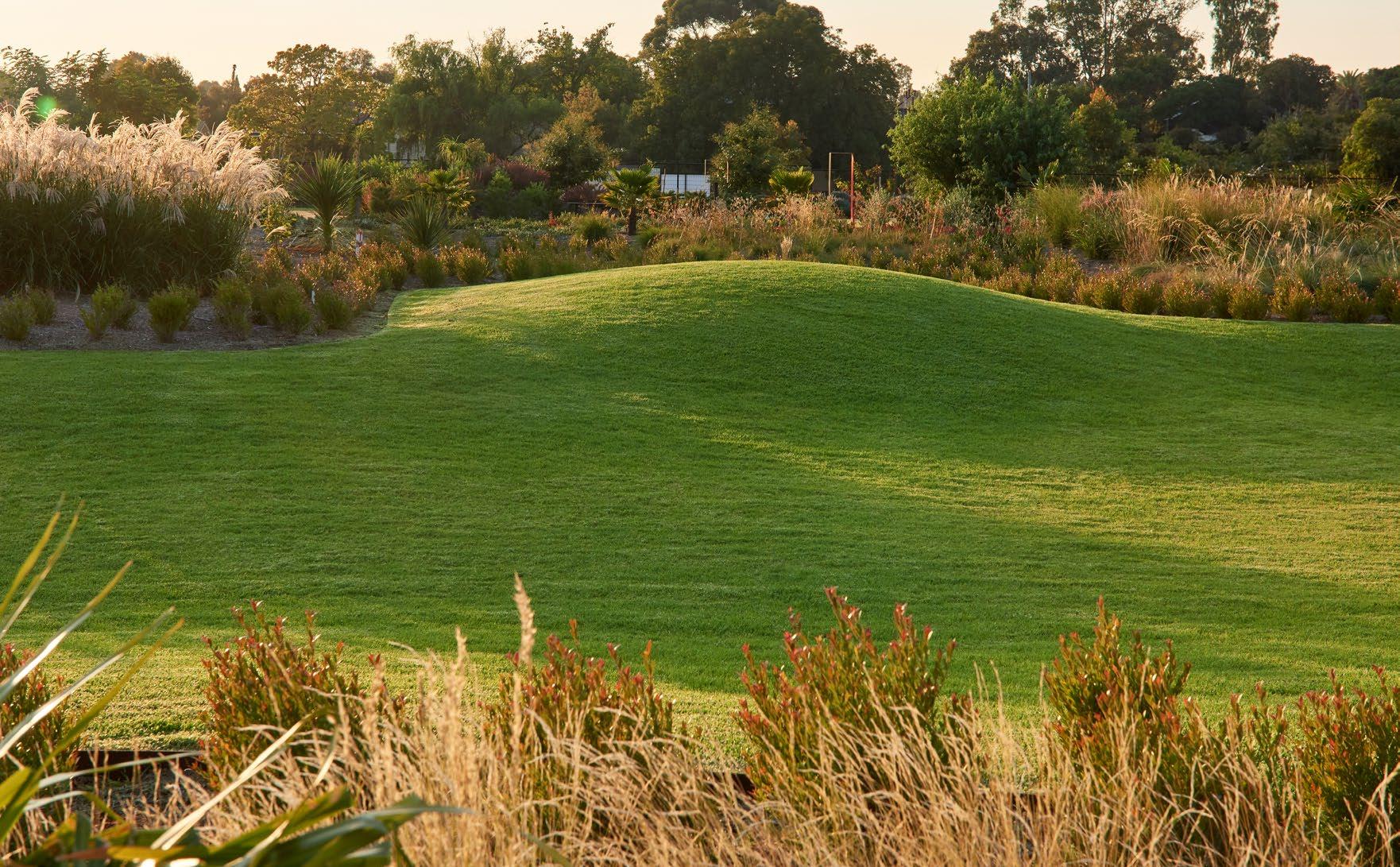
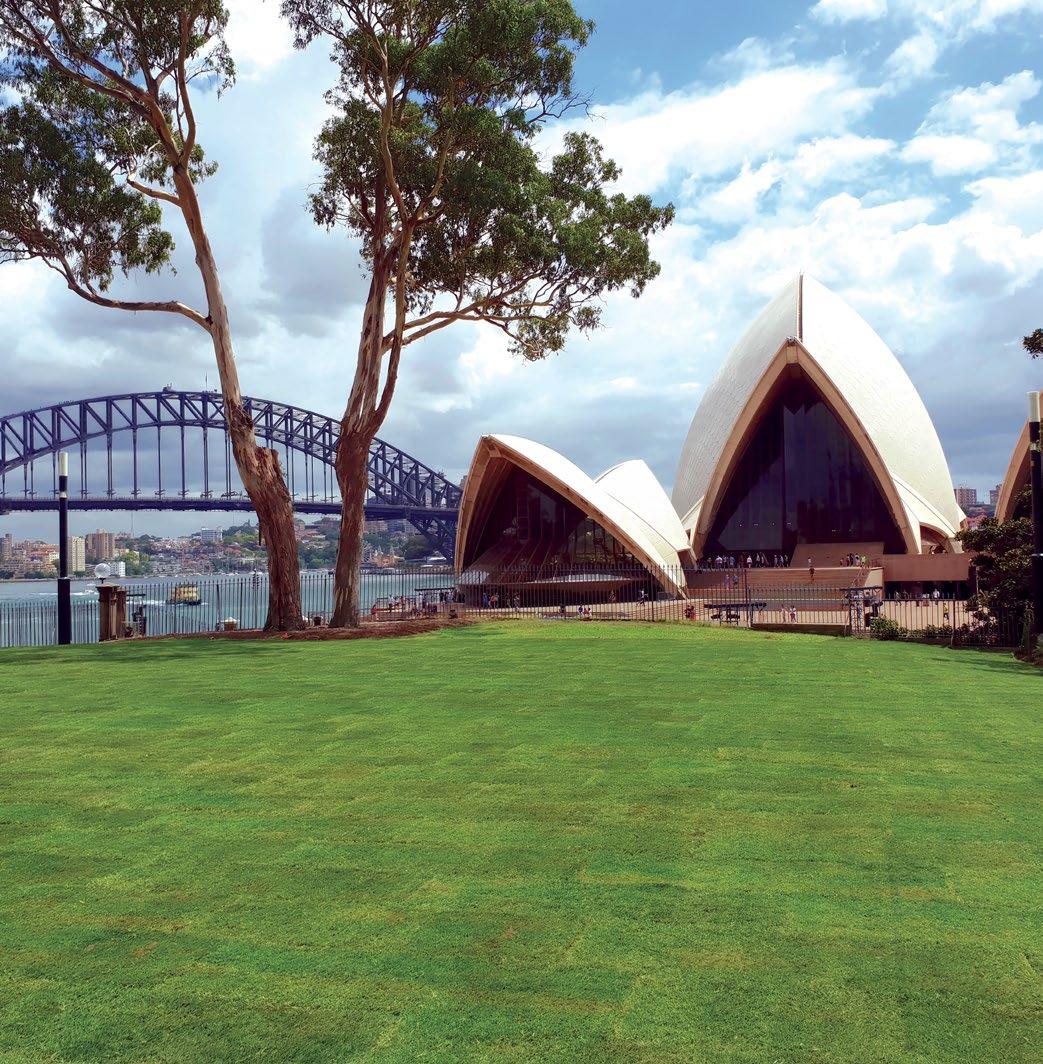
varieties, this also ensures turfgrass looks better for longer in high wear situations and is typically able to recover where other varieties are unable to. This has been found with TifTuf Hybrid Bermuda in sports grounds and goal mouths and even beach front community spaces where other turfgrass varieties has failed. Even in a domestic setting, high quality turf has been estimated to increase the value of a property by 20%.
AusGAP certification represents the best quality turf the industry has to offer in turfgrass production. Turf projects opting
for AusGAP certified turf can rest assured that they are investing in a product of exceptional quality and reliability. From genetic purity to turf delivered free from weeds, pests, and disease, AusGAP certified turf undergoes rigorous testing and inspection processes to meet the stringent criteria set by the certification program. This assurance of quality translates into long term cost savings for turf projects as the need for replacement or remedial actions due to turfgrass quality issues is greatly minimised. AusGAP can also upon request depending on scale of the turf project provide specialised reports about the turf you will
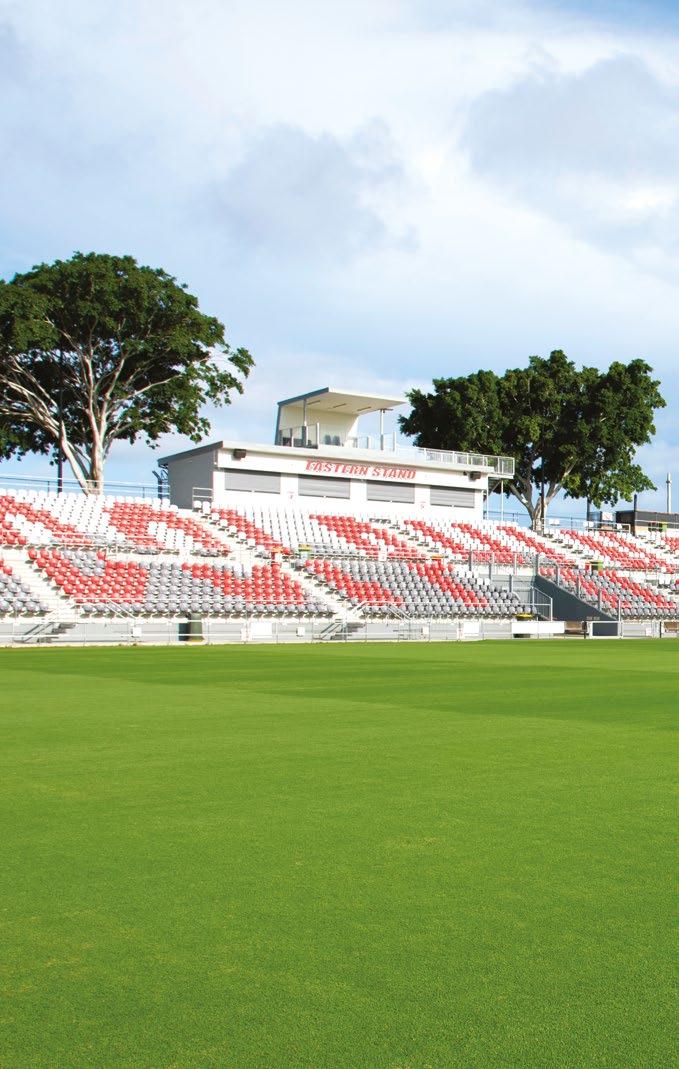
be receiving, ensuring that once the project is ready to commence, the turf is ready for harvest and up to standards.
From quality assurance and aesthetic appeal to long term cost efficiency, AusGAP certified turf offers value and benefits to all turf projects. By investing in high-quality AusGAP certified turf you are investing in the overall success and economic value of the project. As businesses continue to recognise the value of investing in high-quality landscaping solutions, the demand for AusGAP certified turf grows, driving innovation and excellence in the turfgrass industry.

In the heart of the American South, the Woerner family has cultivated a remarkable legacy spanning over a century, rooted in the fertile soil of enterprise and family values. From humble beginnings to becoming a leading name in turf/sod farming and landscape supply, the Woerner family story is one of faith, perseverance, innovation, and a commitment to quality that has passed seamlessly from one generation to the next.
The Woerner family traces its history back to Fred George Woerner who was born in
Carlstadt, New Jersey on May 26, 1885, to immigrant German parents. At the age of seventeen, Fred resettled in New York City. While in NYC (New York City), Fred saw an advertisement showing land for sale in southern Alabama, and put a down payment of $200 on 80 acres in Baldwin County, Alabama and, in 1906, moved to Elberta, AL.
Over time, the Woerner family transitioned from dairy farming to cultivating crops, focusing on turfgrass—laying the foundation for what would become Woerner. The family’s keen business acumen and dedication to providing superior products soon garnered them a reputation as pioneers in the industry.
The evolution of the Woerner family business has been marked by strategic diversification. Today, Woerner operates multiple divisions, including sod farms and landscape supply stores across the Southeastern United States and Colorado.
At the heart of the Woerner family’s success lies their commitment to excellence in sod farming. With several sod farms strategically located across Florida, Alabama, Colorado, and Hawaii, they produce premium turfgrass varieties

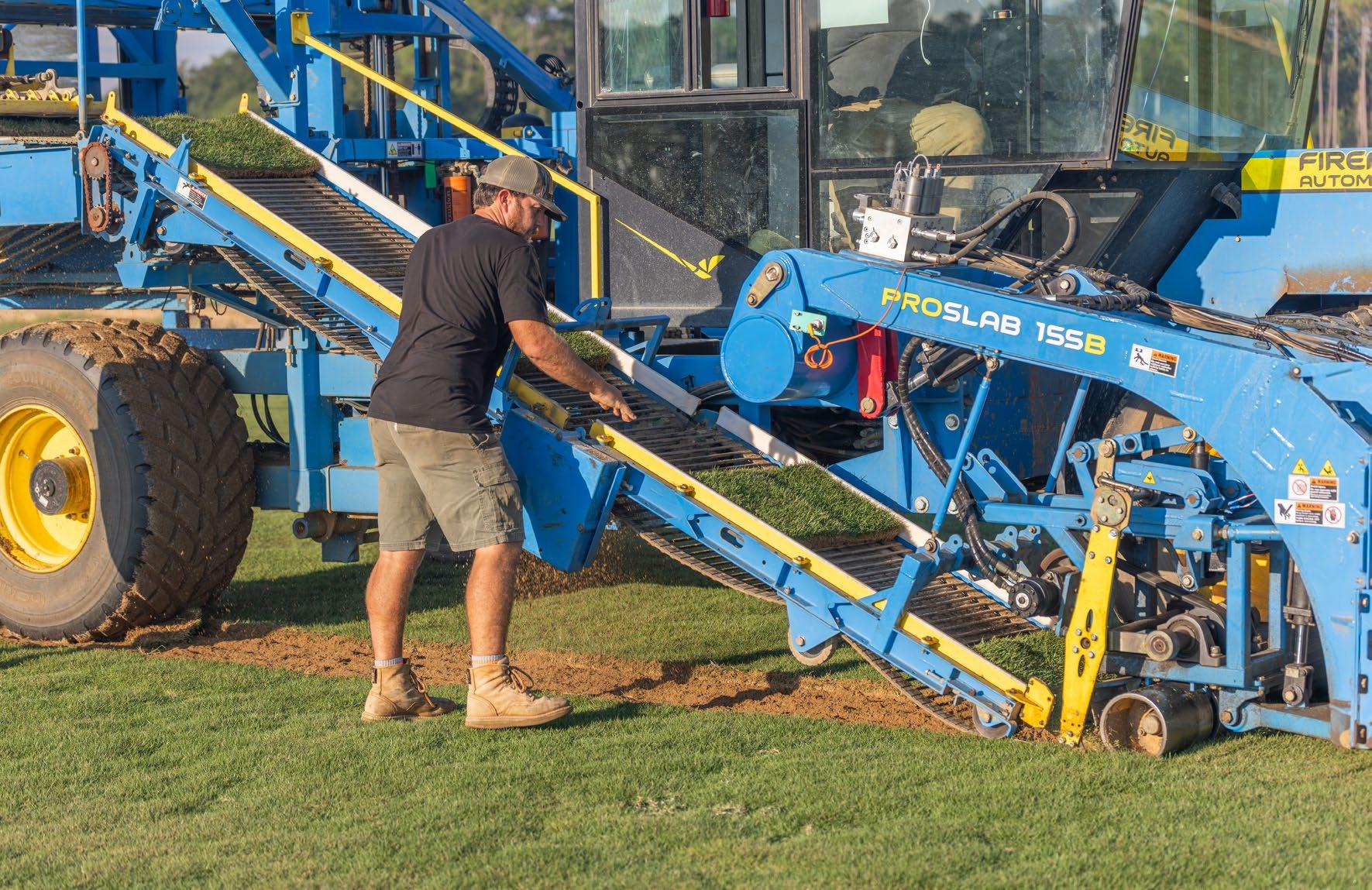
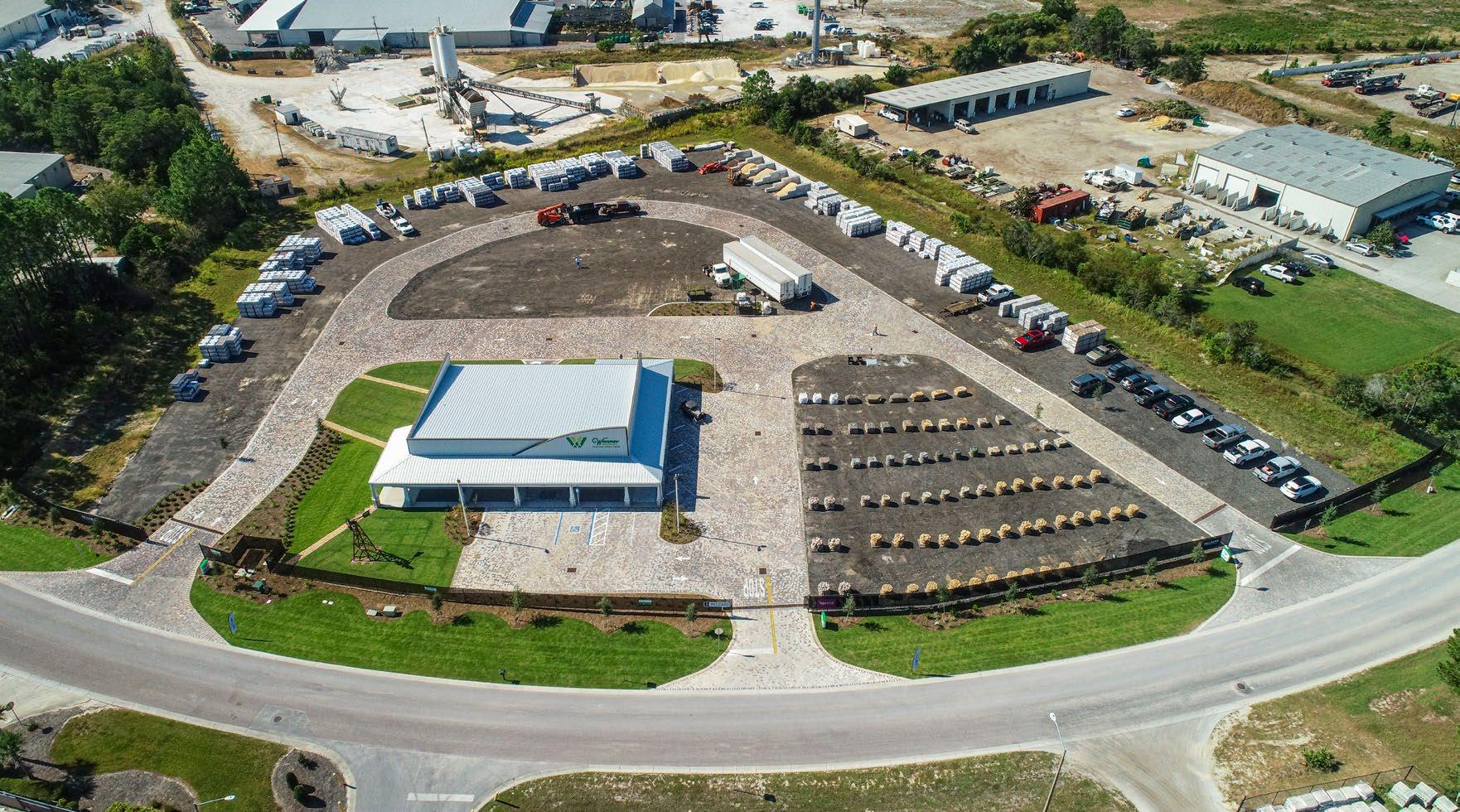
tailored to the region’s unique climate and soil conditions.
TifTuf Bermuda is chosen by many sports fields, golf courses, and subdivisions for its drought and cold tolerance, along with its recuperative and regenerative abilities.
Palisades Zoysia is a medium to coarse textured zoysia that is popular in their warm season regions for its salinity tolerance along the beach towns of the Gulf of Mexico. It’s known as a “friendly” grass due to its impressive establishment and rapid re-growth rate. Its winter hardiness gives it a shorter dormancy span that is ideal for our Southern US locations.
Emerald Zoysia is an ideal choice for those wanting a finer blade with a darker green color. It is a dense turf that can stand up well to foot traffic and requires less mowing due to its low growth habit.
What sets Woerner apart is its comprehensive approach to landscaping. Beyond supplying top-quality sod, the family business offers a comprehensive range of landscaping materials, as well as everything needed for the home garden. Their retail centres are inspiration for both DIY (do it yourself) enthusiasts and
commercial professionals (PRO’s), stocked with everything from mulch, natural stone, pavers and plants to bulk materials and outdoor decor. With the addition of their online store that launched in 2023, customers can place orders from the comfort of their home and schedule orders of sod for pick-up and delivery.
As the business flourishes, the Woerner family tradition continues to thrive under the stewardship of the next generation. Today, George Woerner, along with children Angela, Christina, Kimberly and Allen,
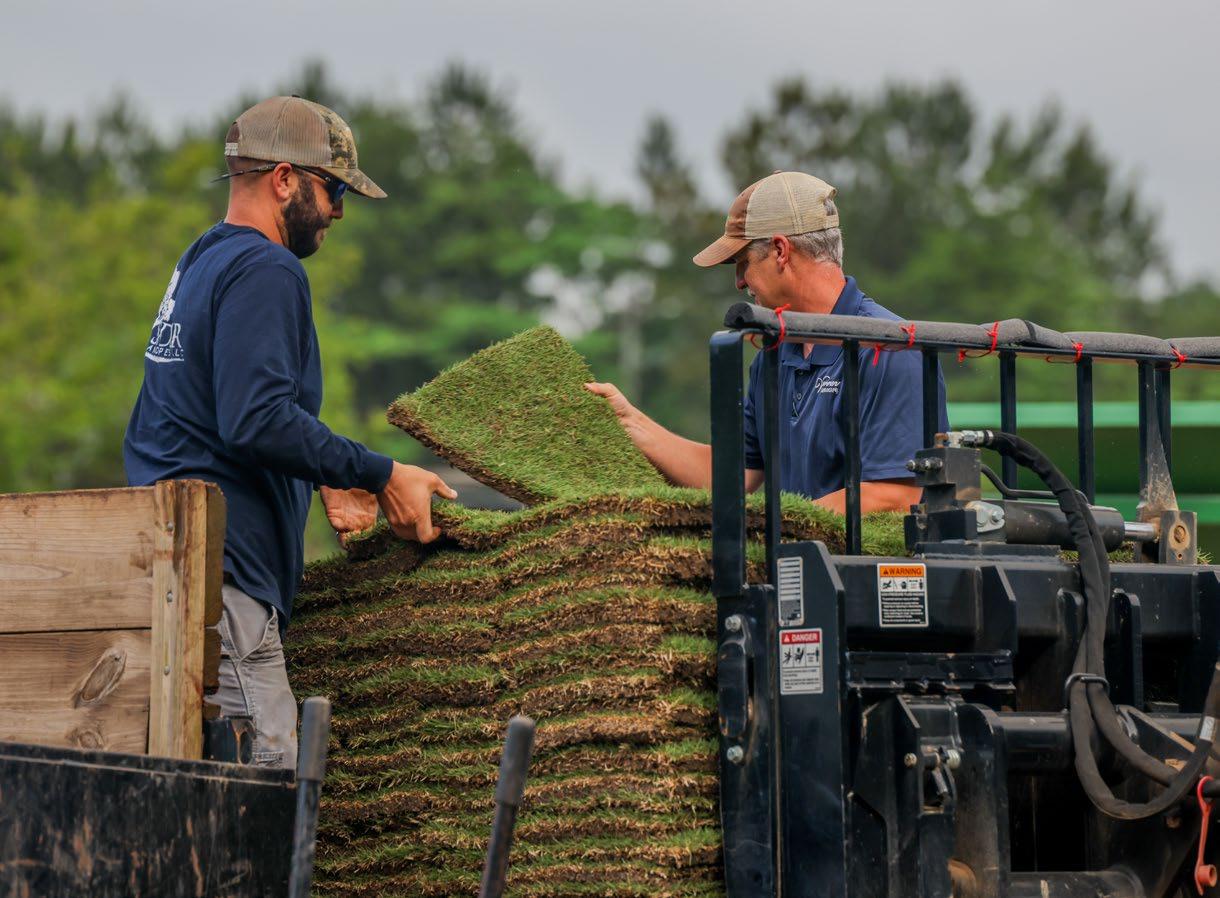
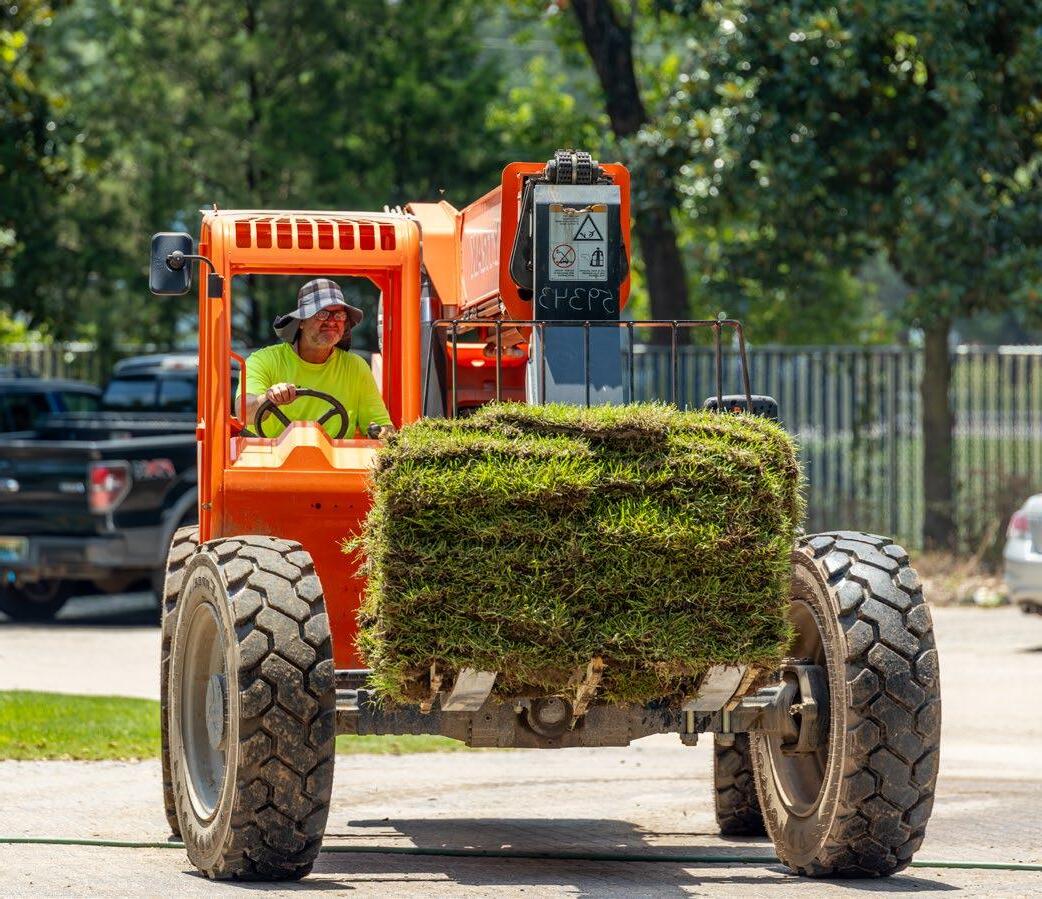
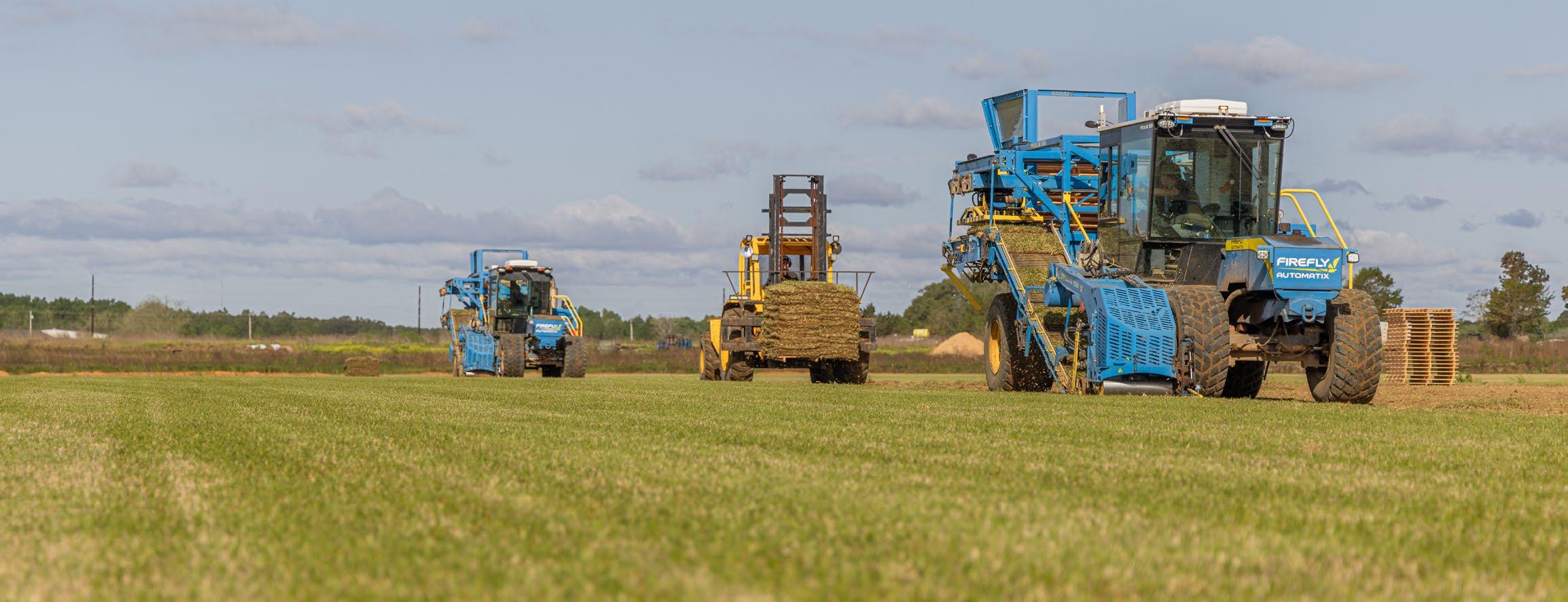
prove the family’s enduring commitment to agriculture, sustainability and customer satisfaction. Embracing modern technologies while staying true to timehonored values, they are poised to steer the family enterprise into the future.
The Woerner family understands the importance of responsible stewardship of the land. Their sod farms utilise innovative practices to conserve water, minimise chemical inputs, and promote biodiversity. Both the Clarksville and Bronson, Florida farms have both been recognised by Florida Farm Bureau’s Cares program for demonstrating exemplary efforts to protect Florida’s natural resources by implementing Best Management Practices. By prioritising sustainability, they ensure that future generations will inherit landscapes that are not just beautiful but environmentally sound.
Beyond business success, the Woerner family remains deeply rooted in their local communities. They actively support initiatives promoting farming, healthy soil, green spaces, and education in agriculture and supporting youth initiatives. Their involvement underscores their belief that a thriving community is built on strong relationships and shared values.
With a robust foundation and a forwardthinking approach, Woerner is poised for continued growth and expansion. The family’s vision includes further geographic diversification, leveraging e-commerce to reach new markets, and expanding their product offerings to meet evolving customer needs.
The Woerner family’s journey from a dairy farm to a renowned name in landscaping embodies the American spirit of entrepreneurship and resilience. Through dedication, hard work, and a steadfast commitment to quality, they have cultivated not just lawns but a lasting legacy—one that continues to thrive with each generation. As the Woerner family embraces the future, they remain true to their roots, ensuring that their story will continue to inspire and flourish for years to come.
As they pave the way for the next generation, the Woerner family’s legacy stands as a shining example of what can be achieved through faith, hard work, integrity, and a deep respect for the land.

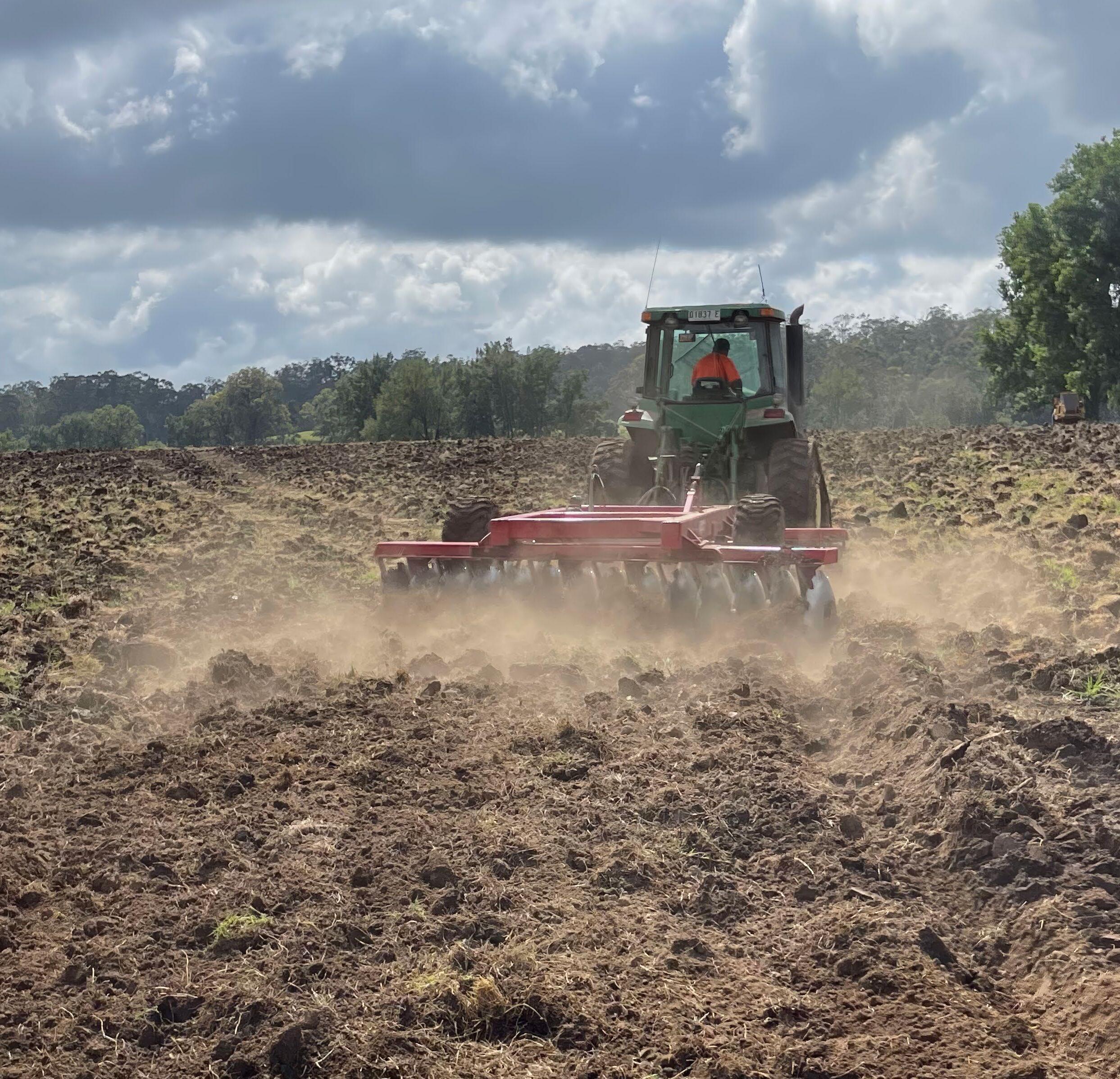
In the Hawkesbury region of NSW, two major challenges for turf farming include locating flood-free land with sufficient water supply and cultivating turf within Development Approval criteria. In this area, one cannot simply purchase any parcel of land and convert it into a turf farm due to soil type restrictions or lack of access to ample water resources.
When Direct Turf was seeking turf production land, considerable research and
investigation were involved in determining which conditions would meet their criteria. The land they found where they currently reside, has been used for intensive agriculture since 1965, and the property has access to permitted water from the Hawkesbury River.
Clearing and preparing the site for acquisition was relatively straightforward as the land was already 90% cleared due to previous farming activities. However,
the higher parts of the farm presented challenges with rocky terrain and drainage issues. Direct Turf dedicated three months to excavation, rock breaking, and the removal of floating rocks. Additionally, they installed four kilometres of agricultural drainage lines, which were then covered with aggregate.
The next stage of the project involved irrigation planning and pumping. To address the undulating nature of the paddocks and prevent erosion and runoff,

Direct Turf installed a fully automated irrigation system designed to micro-irrigate the soil profile and turfgrass efficiently. The system comprises 22 stations, each approximately 220 metres long and spaced 18 metres apart. Powered by a submersible pump with a capacity of 30kva, it delivers 26 litres per second, allowing for the operation of 24-26 Rainbird pop-up sprinklers, each delivering 1 litre per second. Additionally, the pump features an automated self-cleaning system on the foot valve to remove debris and sand.
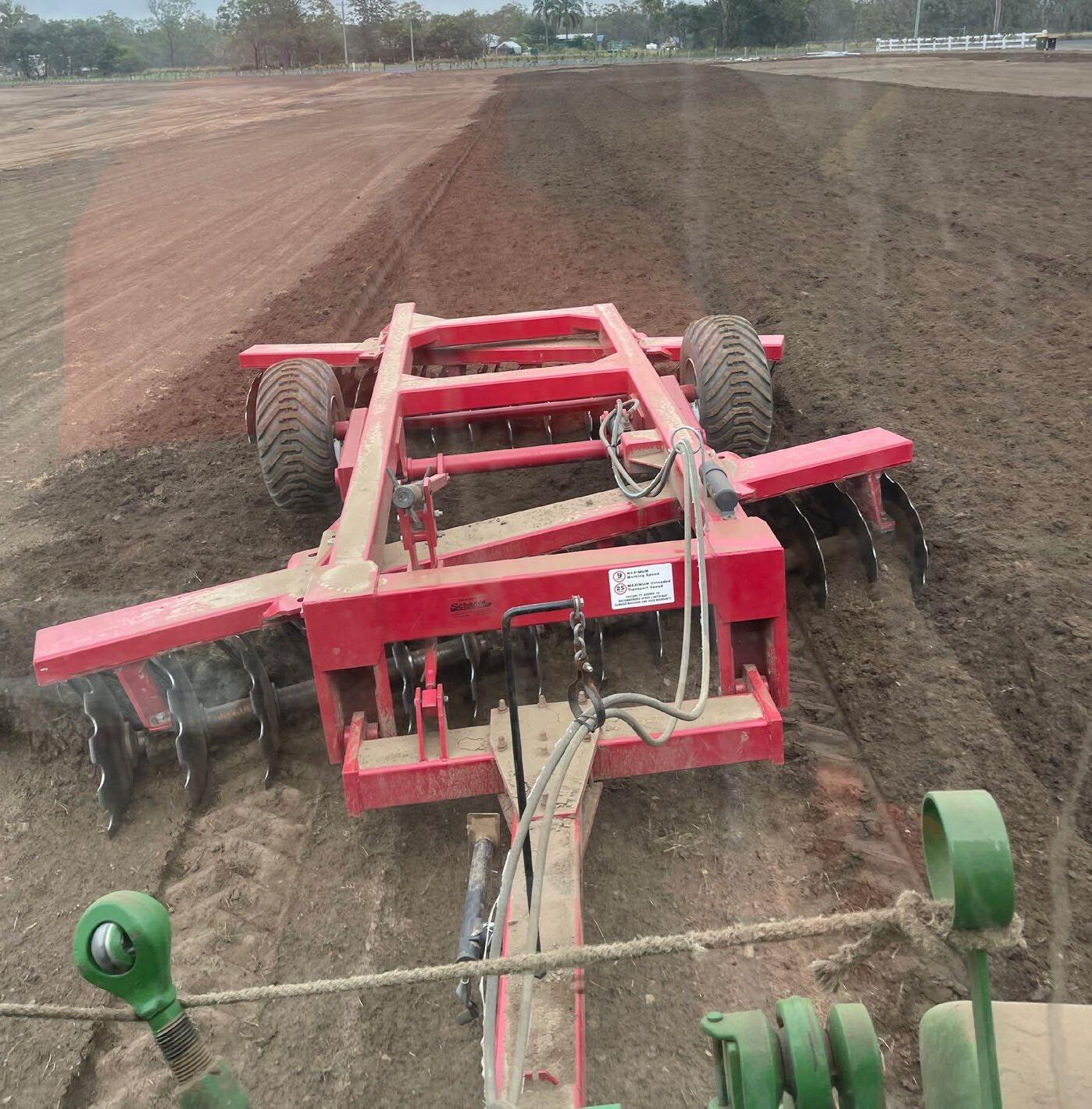
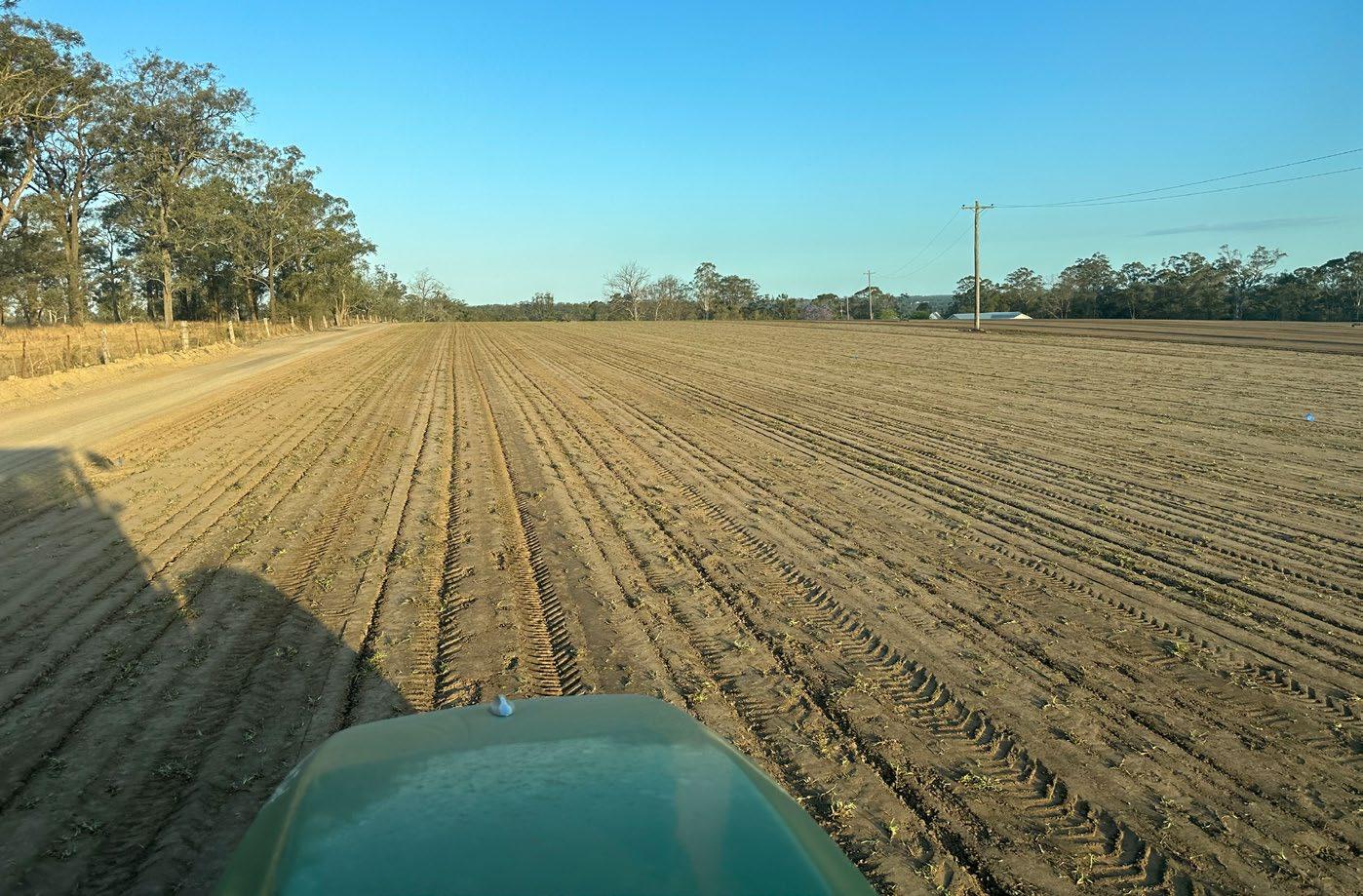
1.2 kilometres of mainline were installed, 10 kilometres of poly pipe of pop-ups and 1.2 kilometres of electric cable to control solenoids for water flow coupled to a rainbird controller link by WIFI to your mobile phone. Having this system allows the farm to be completely watered within 5 hours.
When planning the varieties of turf to plant, Direct Turf faced a challenging decision. They worked diligently with Lawn Solutions Australia to gain a comprehensive
understanding of the 20-year plan and the ongoing research and development aimed at introducing new turfgrasses to the market.
Drawing from their previous sales history, Direct Turf was able to estimate the appropriate quantities of each variety to plant. Direct Turf eagerly anticipates future innovation in turf, especially with a new buffalo variety currently undergoing trials by Lawn Solutions Australia and other members of the industry.


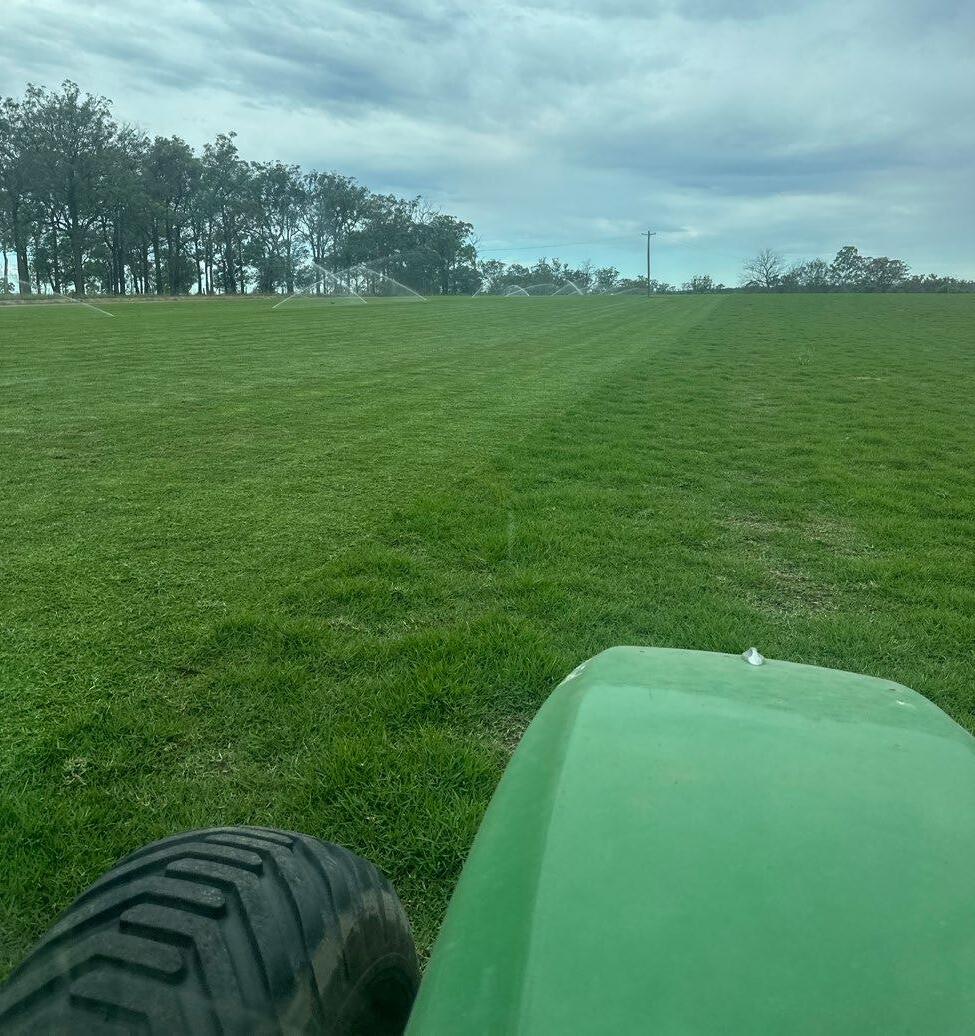
In the planting and infrastructure phase, Direct Turf embarked on a rigorous process. They sprayed and worked the soil for 12 months, ensuring optimal conditions. Once satisfied with the outcome, all areas underwent fumigation to prevent further germination of weed and grass seeds. At this stage, AusGAP, an organisation ensuring quality standards in turfgrass production, conducted on-site inspections
and issued a certificate, enabling Direct Turf to proceed with planting.
Direct Turf utilised a Sammut multi-row planter for the planting process, initially focusing on one variety. They planted 400m2 of each variety per hectare. During planting, three individuals operated the row planter, while another person managed the roller and sprayed pre-emergent herbicide. Following planting, Direct Turf monitored moisture
levels closely through their irrigation system to ensure optimal turfgrass establishment.
During the growing phase of the turf, Direct Turf diligently monitors the nutrient content in the soil and supplements as needed to promote robust root development and lush leaf growth. This period can often be quite stressful, as various factors such as heat, humidity, sunlight, and rainfall need to align perfectly.

In the case of the Zoysia Australis and Sir Walter DNA Certified Buffalo varieties, both were harvested approximately five months after planting. They were planted on the 10th of November 2023, and the first 100 rolls were harvested on the 31st of March 2024.
Throughout the process, Direct Turf encountered several challenges. Heavy rain led to significant erosion, while the unexpected volume of rocks
required extensive rock-breaking efforts. Establishing roadways to navigate between the top and bottom paddocks and maintaining effective communication with all relevant parties were paramount.
Of the total land area, 22 hectares were earmarked for the project, with 17 hectares designated for turf production. Implementing flood-proofing measures was crucial for business continuity. While
this property is 70% flood-free, it represents a substantial but necessary investment to safeguard against potential devastation caused by floodwaters. This contrasts with Direct Turf’s other farm in Windsor, situated in a floodplain, which has endured three floods in as many years, resulting in significant damage and disruption to operations.
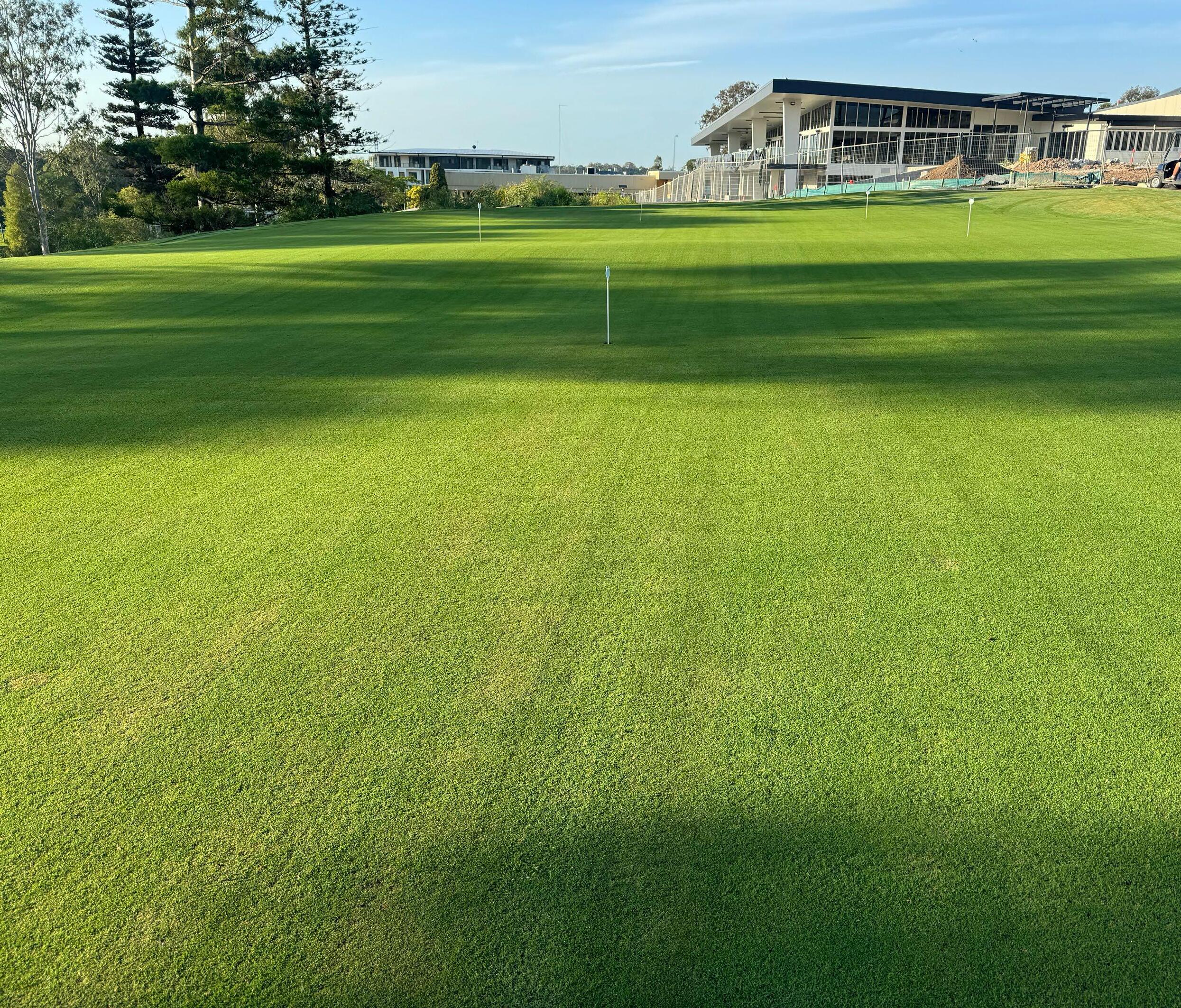
Nestled in the picturesque surroundings of Brisbane, the Pacific Golf Club is undergoing an exciting transformation. At the forefront of this redevelopment is Charlie Giffard, the course superintendent, whose extensive experience and innovative vision are pivotal to this project. We sat down with Charlie to discuss his journey in the world of golf, the current state of Pacific Golf Club, and the ambitious plans for its future.
Charlie Giffard’s career in golf began in 1979 on a modest nine-hole course. Over the decades, his path took him through various locations across New South Wales
and Queensland, working with a variety of cool and warm-season grasses. His extensive tenure at Indooroopilly Golf Club in Brisbane from 2004 to 2018 gave him deep insights into managing diverse green environments. “I’ve always been a student of looking at different grasses and seeing how we can do things better,” Charlie reflects.
Charlie joined Pacific Golf Club at a pivotal moment. The club, located in a somewhat overlooked area of Brisbane, is in the midst of a significant redevelopment. This includes a partnership with Reside, a retirement company, leading to the modernisation
of the club’s facilities. A new clubhouse, state-of-the-art practice facilities, and the latest technology such as Top Tracer and Trackman in the simulators are just a few highlights of the ongoing transformation.
“We have four simulators now, with a fifth one planned for the driving range. It’s an exciting place to be with all the new technology,” Charlie adds.
“Pacific Golf Club is situated in a fantastic part of Brisbane. It’s in a bit of a forgotten area in golf,” Charlie notes. “One of my intentions is to try and bring the profile up of the club. The redevelopment with Reside has enabled the club to modernise.”
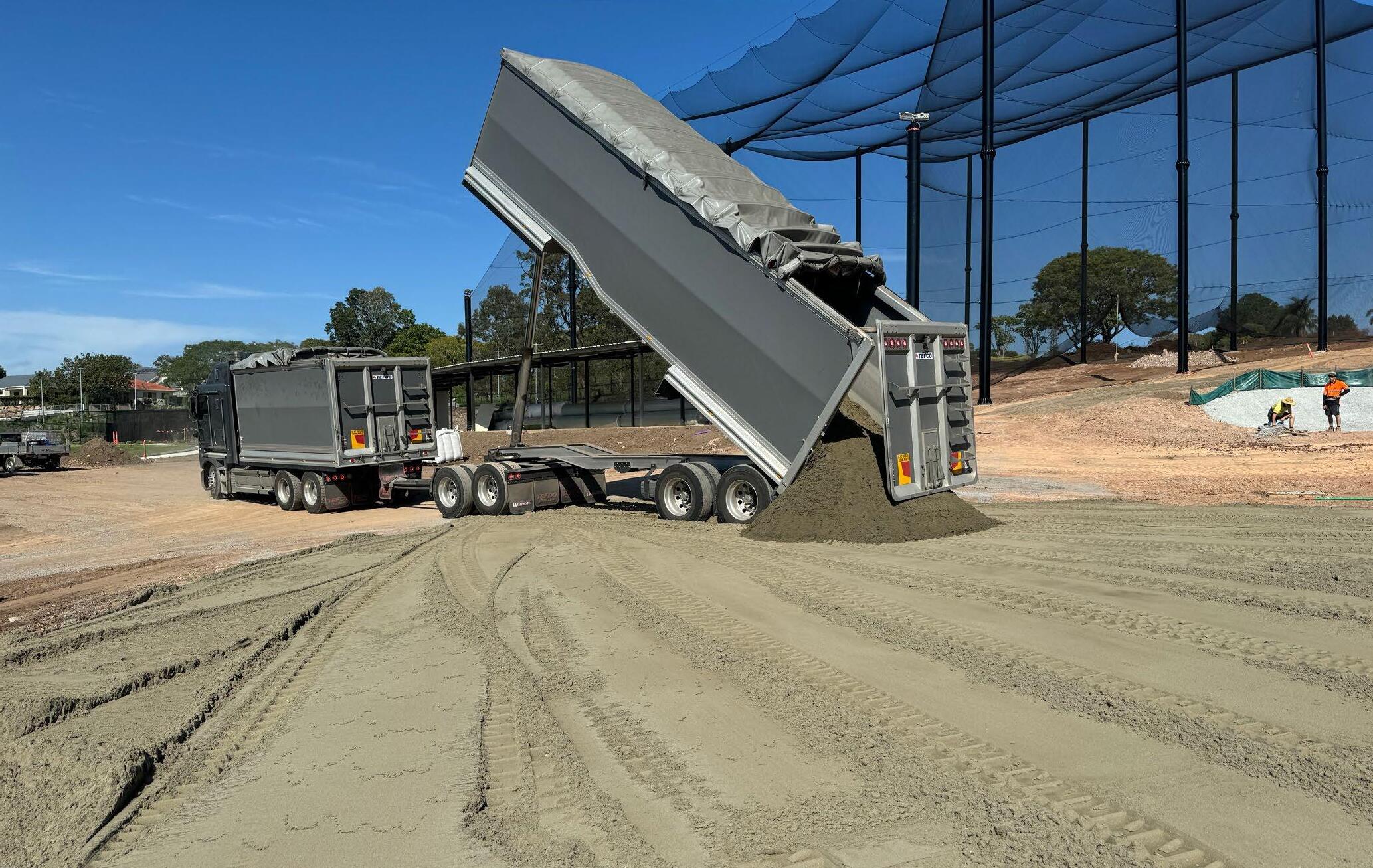
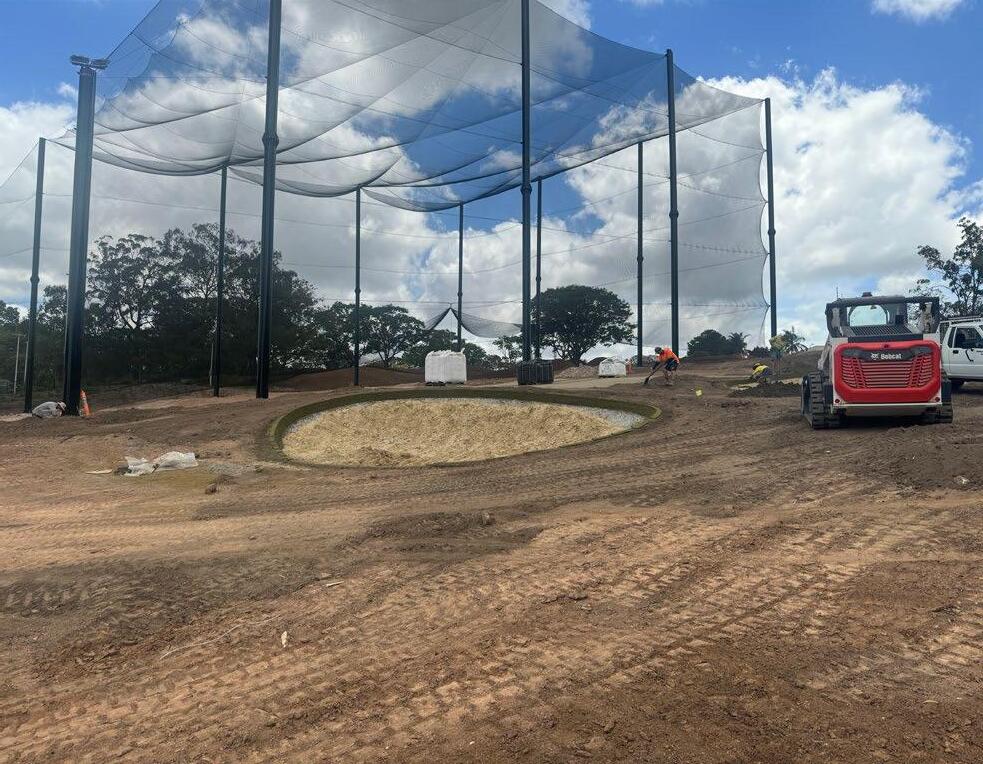
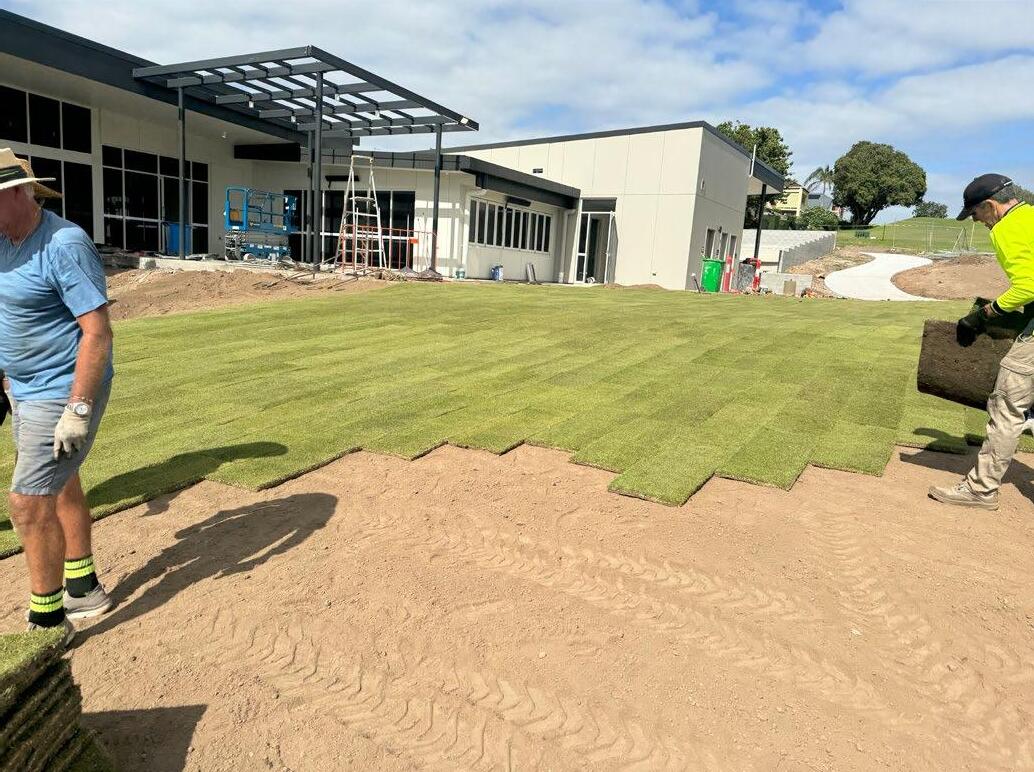
The redevelopment aims to elevate Pacific Golf Club not just as a golfing destination but as a community hub. “There’s an opening up of the club and the facilities rather than just for golfers and members to the community at large,” Charlie explains. The plans include an amenity lawn, mini golf, advanced practice areas, and possibly even a swimming pool, gym, and cinema. This holistic approach positions the club as a lifestyle venue, catering to a broader audience.
One of the significant upgrades under Charlie’s supervision is the installation of
a new irrigation system. The old system, comprised of hydraulic systems with a mix of asbestos cement, PVC, and steel pipes, was outdated and inefficient. The new system, a Toro Lynx system with Infinity head sprinklers, promises better water distribution and turf quality, essential for maintaining high standards across the course. “It took a little over a year to install twin row irrigation, starting in mid-2022 and finishing in June 2023,” Charlie explains. “The new system gives us much more coverage and manageability.”
As an early adopter of Zoysia, Charlie Giffard immediately recognised its potential for golf course use, particularly for its sustainability
and maintenance advantages. “Zoysia has many good qualities that make it an excellent fit for golf. With sustainability being a key focus, it minimises inputs compared to what we were working with before, like 328 and other Bermudas or couches,” Charlie explains. The successful implementation of Zoysia at previous courses had proven its value, and Charlie was eager to leverage this experience at Pacific Golf Club.
“When we were looking at the amenity lawns around the clubhouse, it was a nobrainer for me to choose Zoysia,” Charlie states. “Its aesthetic appeal and low maintenance requirements made it ideal for the club’s plans.” The new lawns, planted
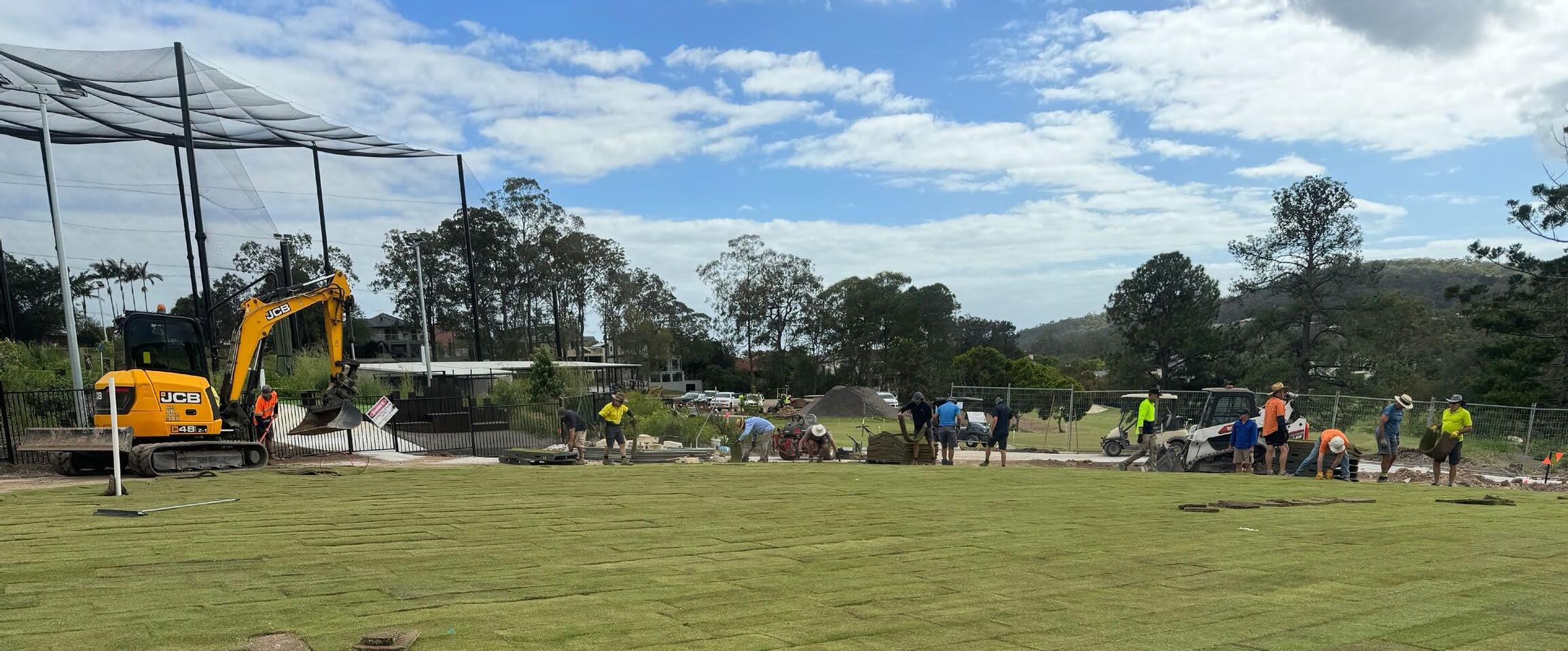
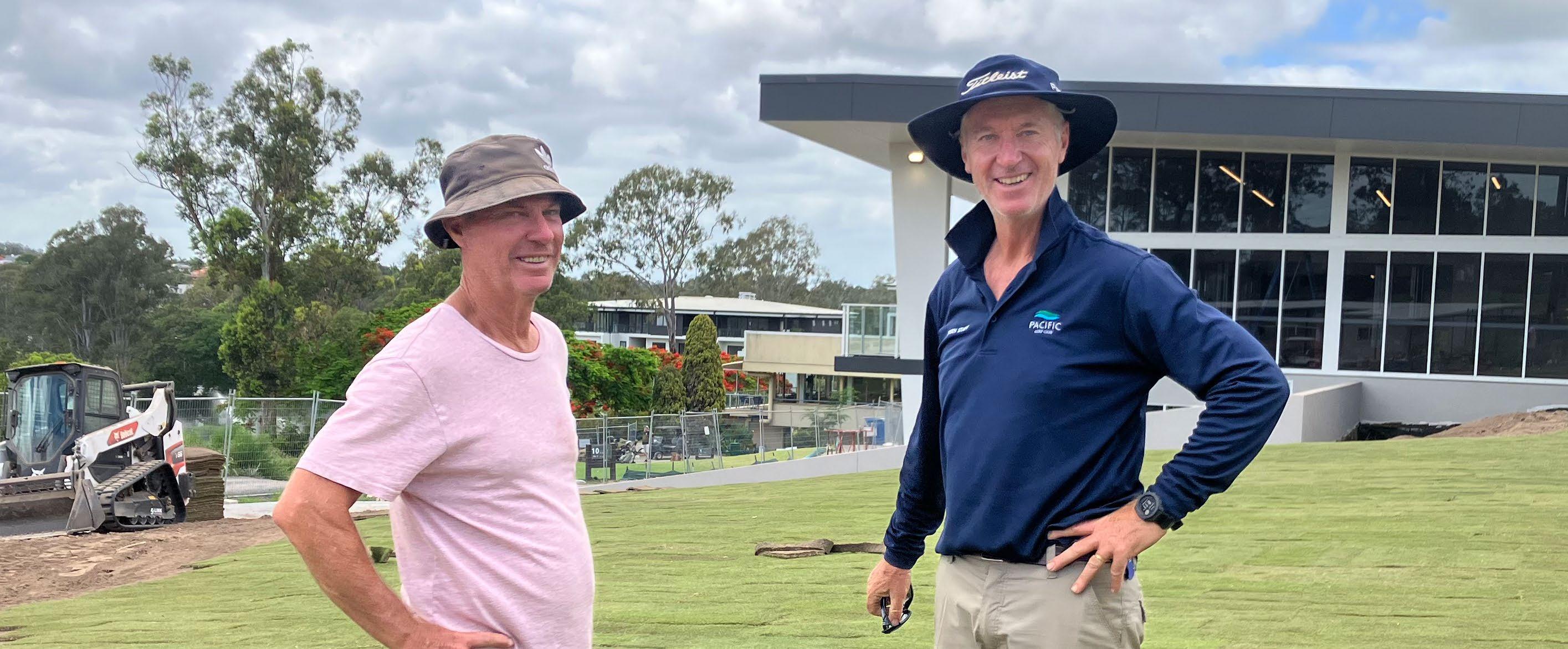
with Sir Grange Zoysia, are not just for show. “We’ve got tables and chairs out on it, and it handles a lot of weekend wear and tear, including kids playing and jumping castles. It’s cut at 50mm, making it durable and perfect for heavy use.”
Looking ahead, Charlie also envisions using Zoysia for the redevelopment of the ninehole course, highlighting its resilience and suitability for diverse golfing conditions. “The Primo Zoysia we’ve installed on greens at other courses has proven to be an excellent surface, and I have high hopes for its future applications across this course also.”
As redevelopment progresses, Charlie’s focus is on refining the course’s playing surfaces and upgrading the greens. Plans
include transitioning from the traditional 328 grass to TifEagle, known for its superior quality. A master plan is in development to potentially revamp the course layout, enhancing the overall golfing experience.
“At the moment, I’m looking at trying to clean up a lot of the playing surfaces. We’ve achieved a lot in the last 12 months in getting old grass weeds out and are about 80% Greenlees Park or hybrid green couch,” Charlie says. “We’re also planning to update our mowing lines and upgrade the greens to TifEagle.”
Since the redevelopment began, the members of Pacific Golf Club have shown tremendous support, with a full membership and a waiting list of eager applicants. Initially sceptical, many members are now seeing the
impressive results and are enthusiastic about the club’s future, confident in the positive direction of the ongoing improvements.
Charlie Giffard’s tenure at Pacific Golf Club is marked by innovation and a commitment to excellence. His extensive experience and forward-thinking approach are driving the club’s transformation, making it an exciting place for both golf enthusiasts and the broader community. As Charlie aptly puts it, “It’s not just a golf course; it’s a lifestyle.” With such a dynamic vision, Pacific Golf Club is set to become a premier destination in Brisbane’s golfing landscape.
We thank Charlie Giffard for his time and insights. Stay tuned as we continue to follow the exciting developments at Pacific Golf Club.
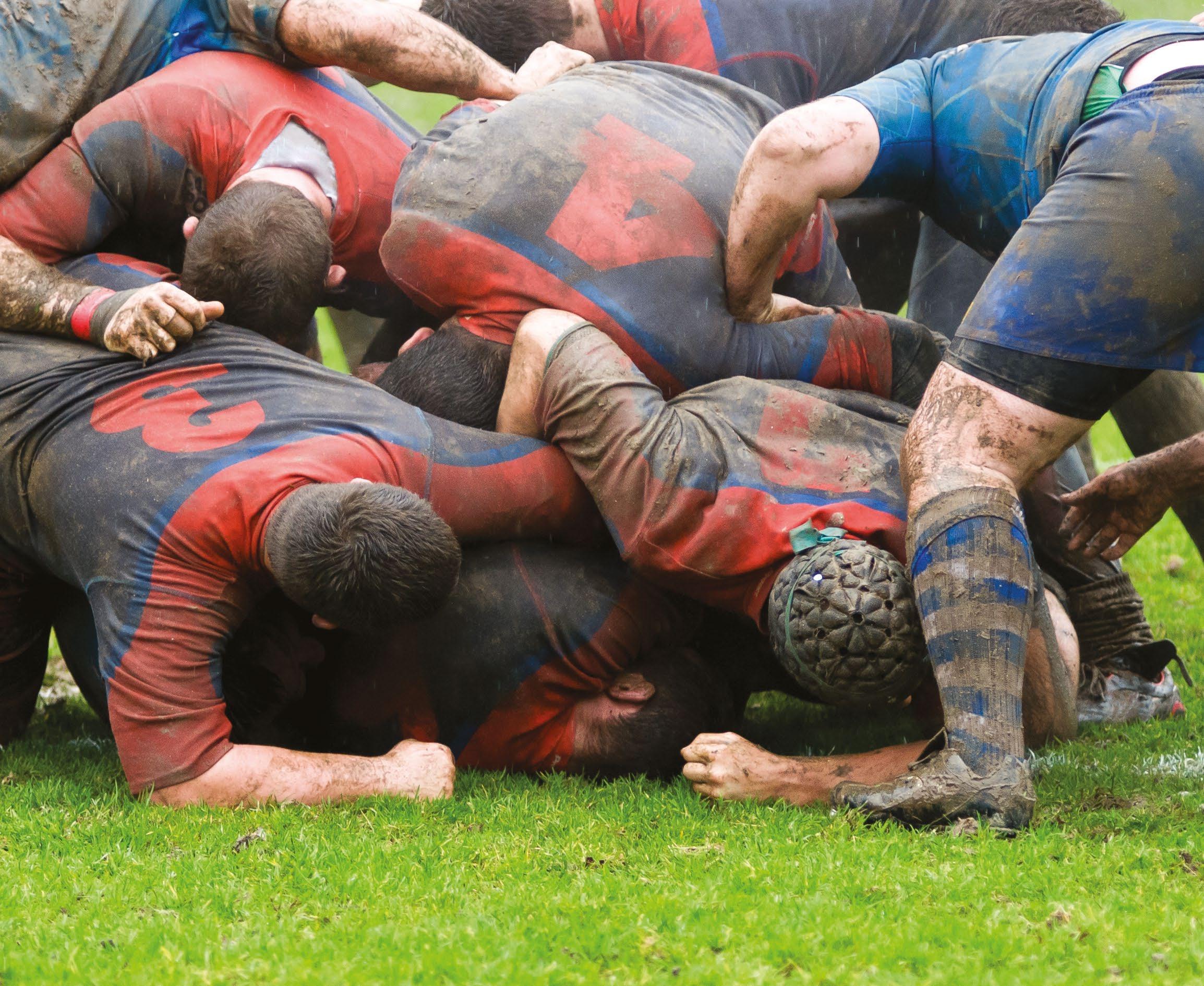


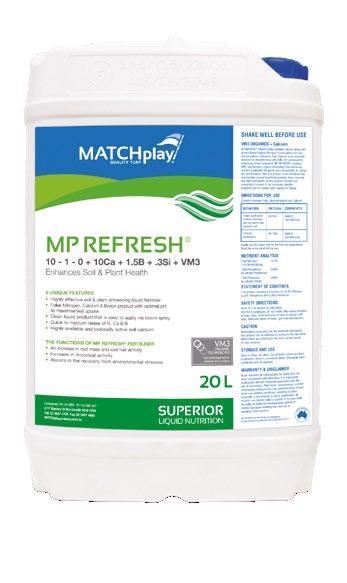

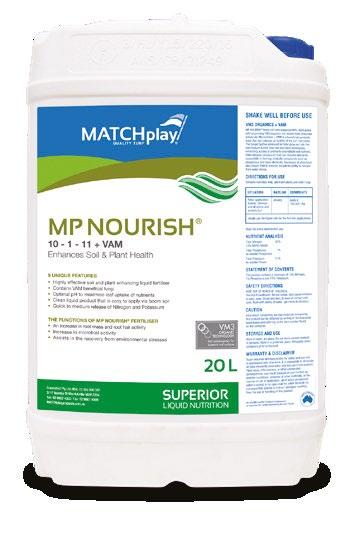
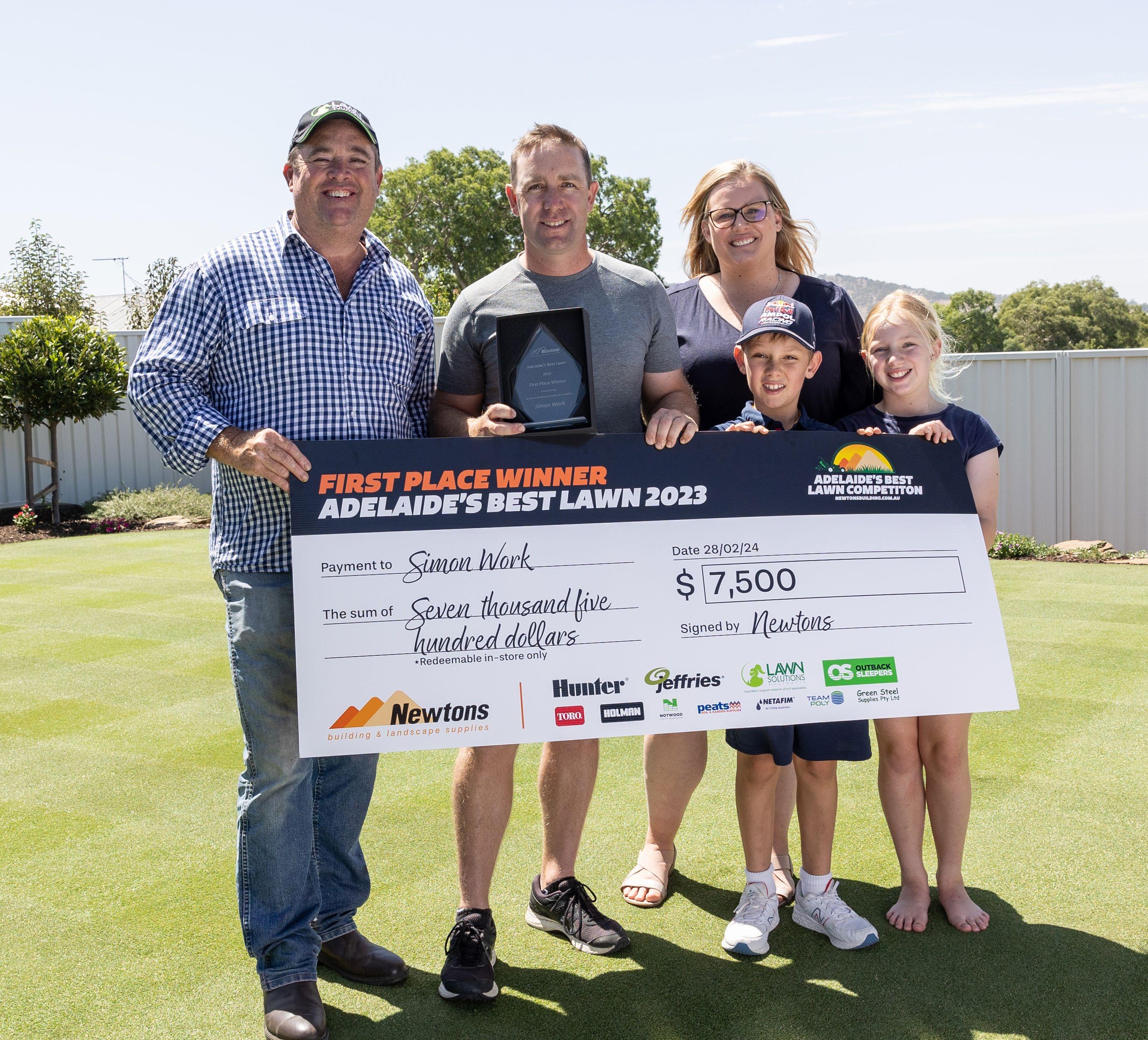
Amidst the tranquil embrace of a wellmanicured garden, Adelaide’s Best Lawn Competition presented by Newtons Building and Landscape Supplies has well and truly emerged. Now in its second year, this event brings together passionate gardeners and lawn enthusiasts to showcase their meticulously tended lawns, vying for the coveted title of having the most pristine and picturesque greenery in the city.
The aim of the competition is to ensure lawn devotees, gain the recognition they deserve for their passion and dedication. While builders often receive accolades for
their architectural feats, the significance of well-maintained lawns in shaping the first impression of a property often goes unnoticed. Newtons Adelaide’s Best Lawn Competition has sought to rectify this and inspire keen gardeners and lawn lovers to elevate their craft.
Graced by esteemed experts including Jason Hodges and Simon Adermann from Lawn Solutions Australia, the competition this year not only celebrated the remarkable achievements of lawn enthusiasts but also fostered a sense of community and camaraderie among lawn lovers.
The judging panel included Hodges and Adermann, but also Theo Kyriazis, Frank Ferella, and Will Richey from Newtons Building and Landscape Supplies, as well as Andrew Rowett from Sunnyside Instant Lawn.
This years’ competition garnered widespread participation, spanning the North, South, East and Western suburbs, as well as the Adelaide Hills region - showcasing the city’s rich tapestry of greenery and horticultural prowess. Powered through digital marketingwhere participants uploaded photos of their lawns - it was a simple competition

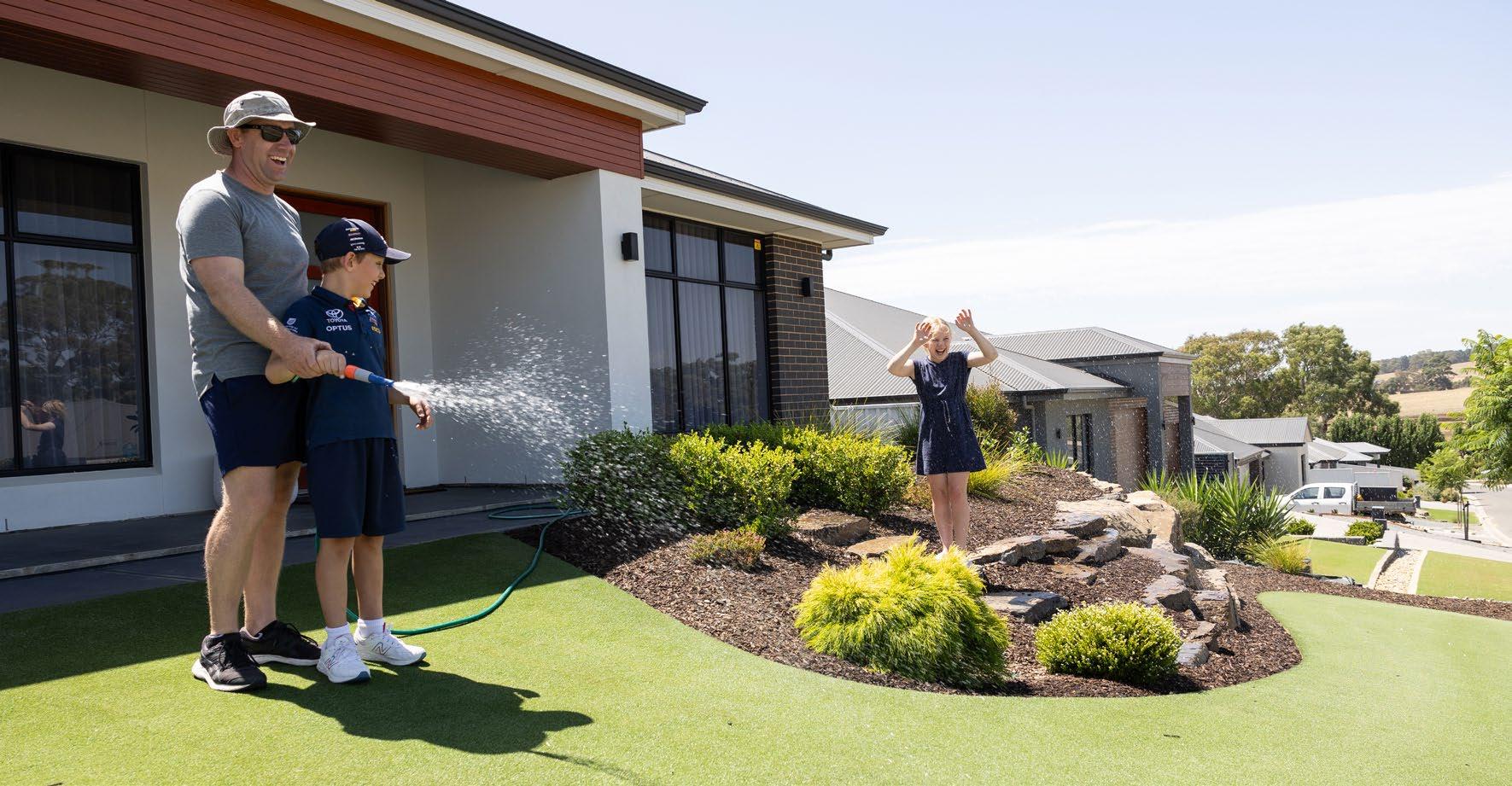
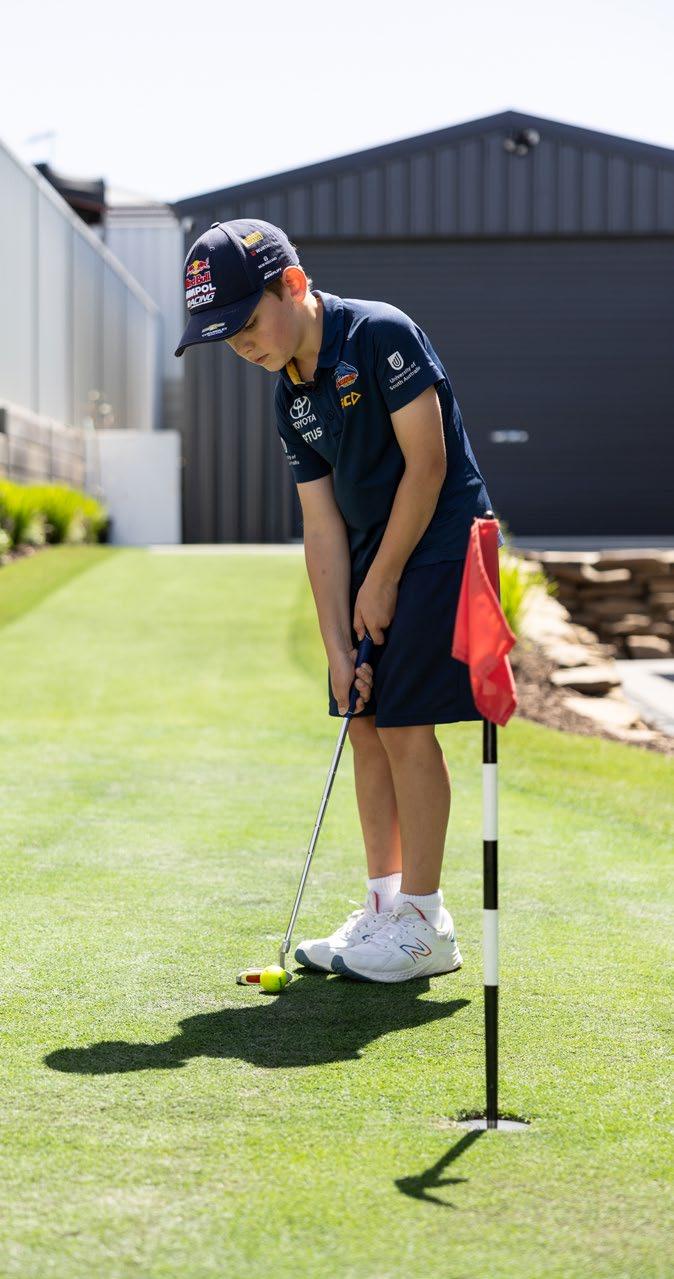
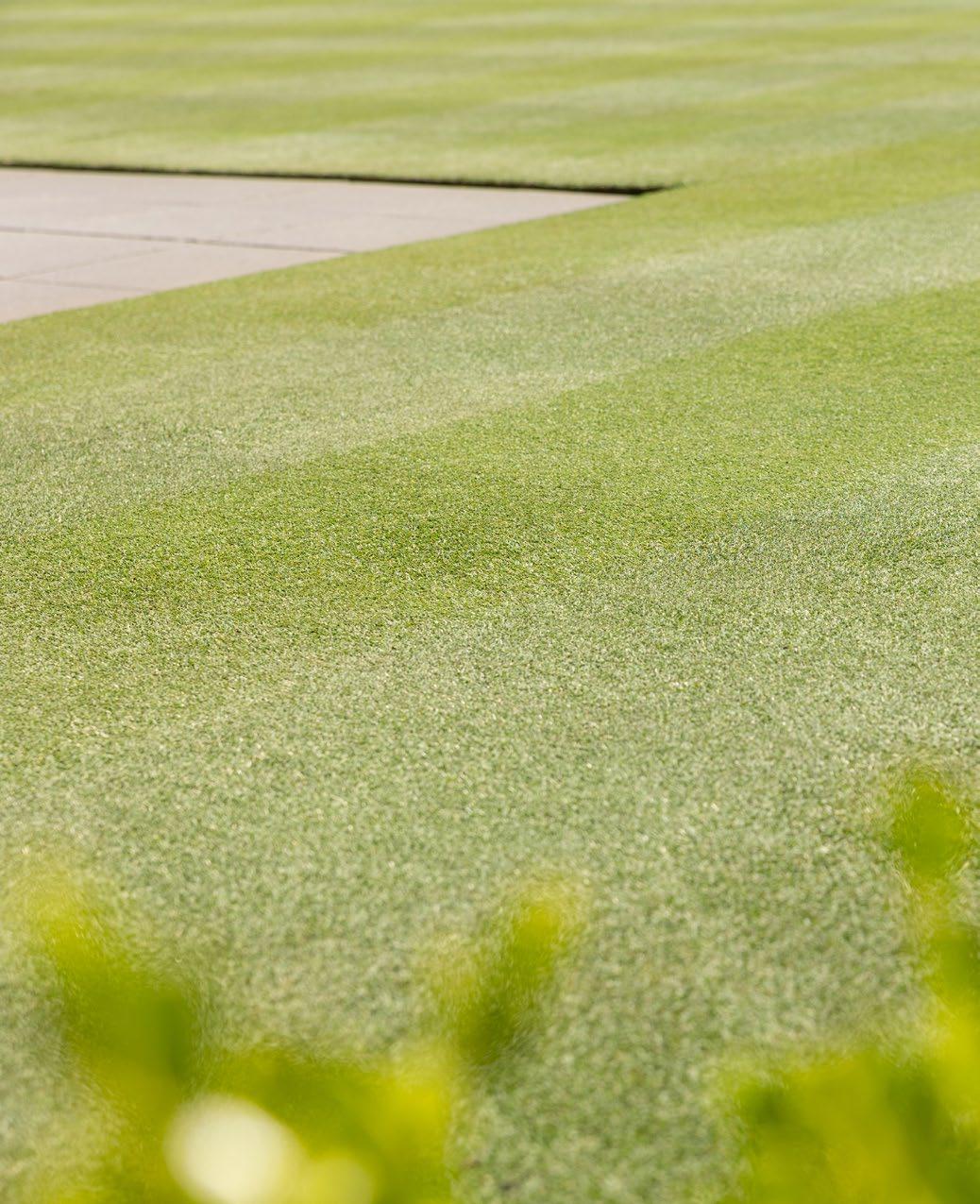
entry mechanism, making it easy for all to be involved. Entrants spared no effort in presenting their meticulously groomed lawns, leaving the judges with the arduous task of selecting the most deserving winners.
However, it was clear - the winner of the coveted Newtons Adelaide’s Best Lawn Competition had to be Simon Work from Mt Barker, who put in a huge amount of time and effort to maintain his beautiful lawn. Pristine from front lawn to back, complete with a putting green - he even inspired the whole family to get involved in his lawn endeavours! His kids were just as excited and
passionate to be a part of the competition as Simon was. The team were astounded by the effort involved in a lawn such as his.
Second place went to Eli Hall from Christies Beach for his perfectly manicured TifTuf front lawn. His commitment to creating and maintaining top-shelf lawns was clear to see. The team enjoyed hearing that even the most expert lawn lover is always learning and responding to their environment. The elements, the shade, light, type of lawn and most importantly lawn maintenance regime are all part of the multitude of considerations that come with having a great lawn.
During the Competition Winners’ Ceremony
- Jason Hodges unveiled some key takeaways of ultimate lawn management, emphasising the importance of adapting to one’s garden environment. Achieving the pinnacle of lawn care demands a disciplined routine, constant attention and proactive upkeep. Mowing transforms into a seamless task when approached with the right frequency and mindset.
Lawn management is rooted in a meticulously planned process tailored to environmental factors and seasonal adaptation. From aeration to fertilisation, every step follows
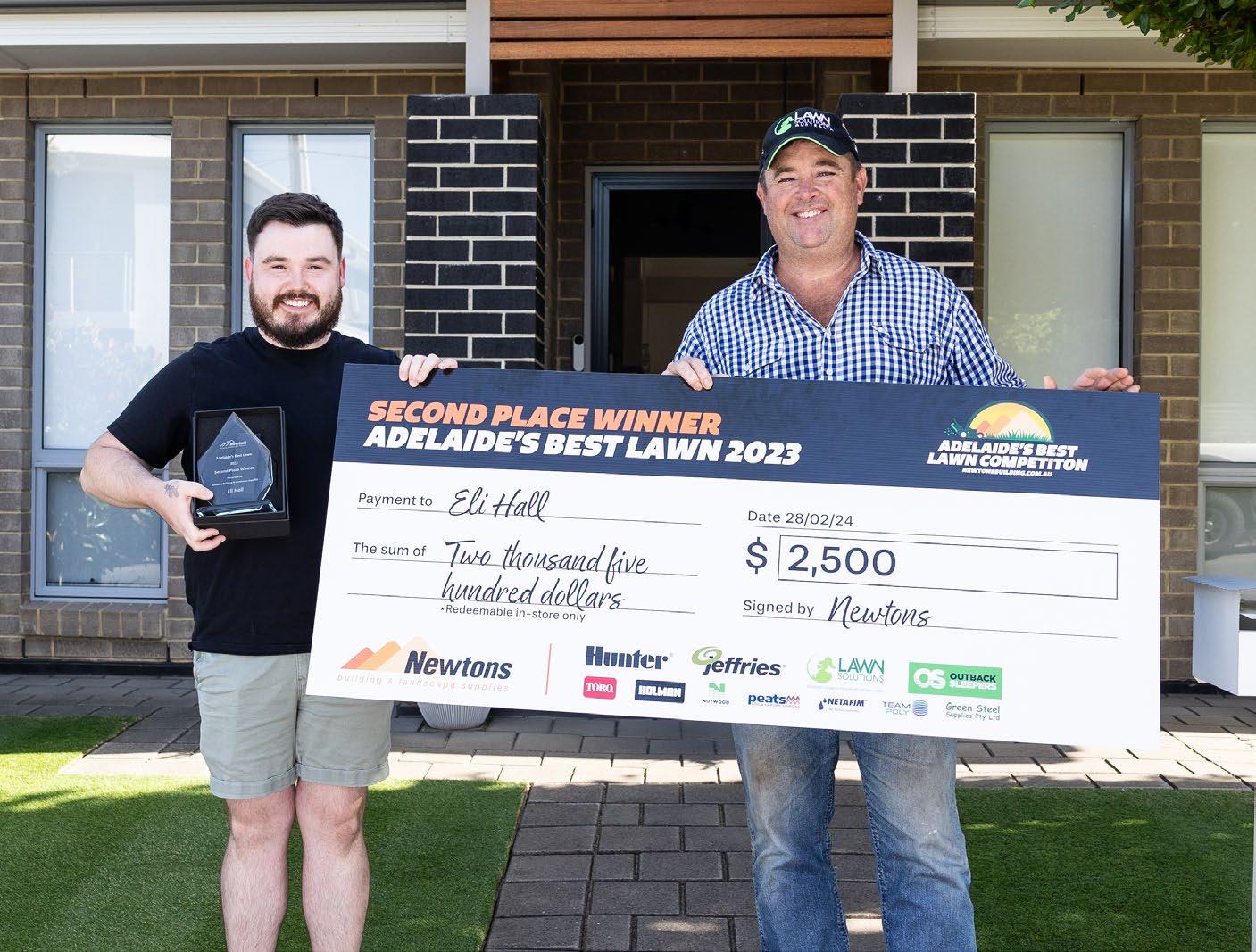
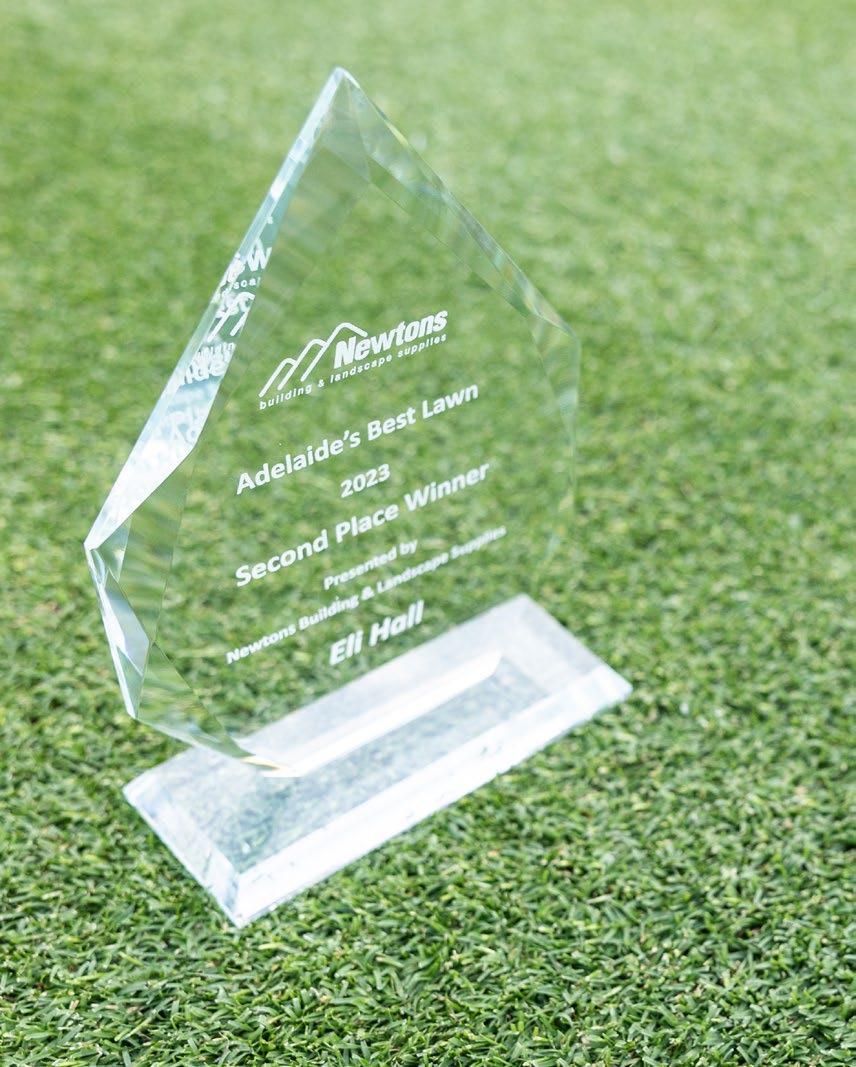

a calculated method, reflecting a deep understanding of the symbiotic relationship between man and nature.
Reflecting on the insights gleaned from a day with Lawn Solutions Australia and the vibrant gardens showcased at Newtons Adelaide’s Best Lawn Competition, we are reminded of the profound impact of gardening on our communities and the environment. Each meticulously crafted
lawn symbolises not just green excellence but also a shared commitment to street pride, sustainability, and community.
The competition served as a platform for industry leaders such as Hunter Industries, Jeffries & Outback Sleepers as well as TORO, Team Poly, Netafim, Notwood, Green Steel Supplies, Holman Industries and Peats Soil & Garden Supplies to unite in their shared reverence for the beauty and allure of immaculate lawns.
If you’re interested in entering, keep an eye out on the Newtons Building and Landscape Supplies social media pages and website towards the end of 2024 for more information. We are excited to see what next year’s Newtons Adelaide’s Best Lawn Competition brings!


Western Australia has approximately 490 public schools throughout the Perth metro area. Each school has a grounds person to look after each site, many only on a parttime basis of 1-2 days per week, unless it is a large school requiring further full-time equivalent (FTE). Irrigation on all sites is automatic and water is supplied via bores. The maintenance of the turf areas is currently carried out by two contractors. Lawn Doctor is the largest service provider with 270 school sites, including the mowing, fertilising, weed spraying, renovation, and construction of all turf areas. Lawn Doctor has been contracting to the Department of Education in WA for 32 years.
The climate in WA is hot and dry in the warm months with an average rainfall of around 600mm per year with most falling
during the winter months as summer rain in the Southwest corner of the continent is uncommon. Perth metro area is 99% sand with little to no water or nutrient holding capacity, making growing good quality turf difficult.
The current maintenance contract limits school sites to just one fertiliser application and two wetting agent applications per year unless they choose to allocate additional funds themselves. This restriction poses a challenge in maintaining a durable surface that can withstand the harsh climate, constant water restrictions, and the sandy soil composition. Moreover, the constant heavy usage of the turf areas by students exacerbates the difficulty of keeping the turf surface in optimal condition. Adding to these challenges, the
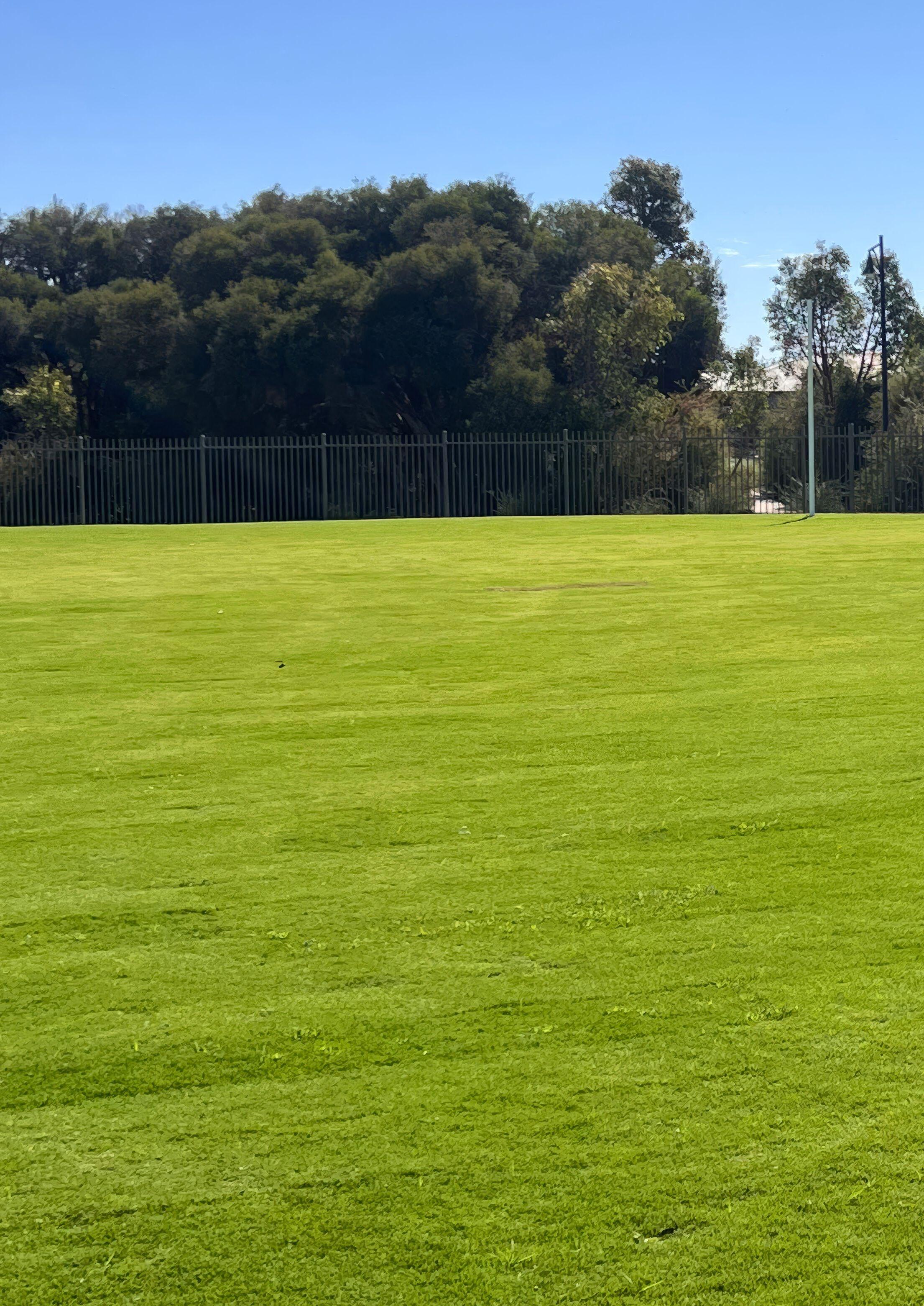
invasion of Southern Sting Nematodes has further intensified the struggles faced by many turf areas.
Southern Sting Nematode
Southern Sting Nematode (Ibipora lolii) is the most damaging nematode pest of turfgrass in Australia. It was first reported in the Newcastle area of New South Wales in 1979 and is now causing severe damage to sports grounds in Perth.
For years, the Department of Education specified the use of Kikuyu on school grounds, believing it to be the best variety available to cope with the challenging conditions. Unfortunately, the damage caused by the Southern Sting Nematodes to the root system is particularly severe in schools where Kikuyu grass is predominant.
The impact of these nematodes is especially pronounced in sites with larger school populations, rendering the ovals completely unusable. One site was Aveley North Primary School, a reasonably sized primary school located in Perth’s Northeast, where the nematode infestation resulted in their oval being unfit for purpose.
The school has approximately 900 students and is 6 years old. The oval was laid with instant Kikuyu that arrived with a significant Sting Nematode population and the oval has struggled to be a viable playing surface. The Department of Education approached Lawn Doctor for options on how to improve the turf surface, including renovations, pesticide applications, and additional nutritional inputs.
Lawn Doctor was concerned the additional funding spent would not provide the required results and this would negatively impact all stakeholders, including the students, the Department of Education, and Lawn Doctor. Lawn Doctor decided that the best recommendation was a complete reconstruction of the oval using TifTuf Hybrid Couch. A proposal was written and submitted, outlining the benefits, including the active root system, the need for minimal fertiliser inputs, reduced water usage, and its active winter growth. After several meetings and a full risk assessment, a commitment was made by the Department of Education to variate from the specified Kikuyu and go with this hybrid couch
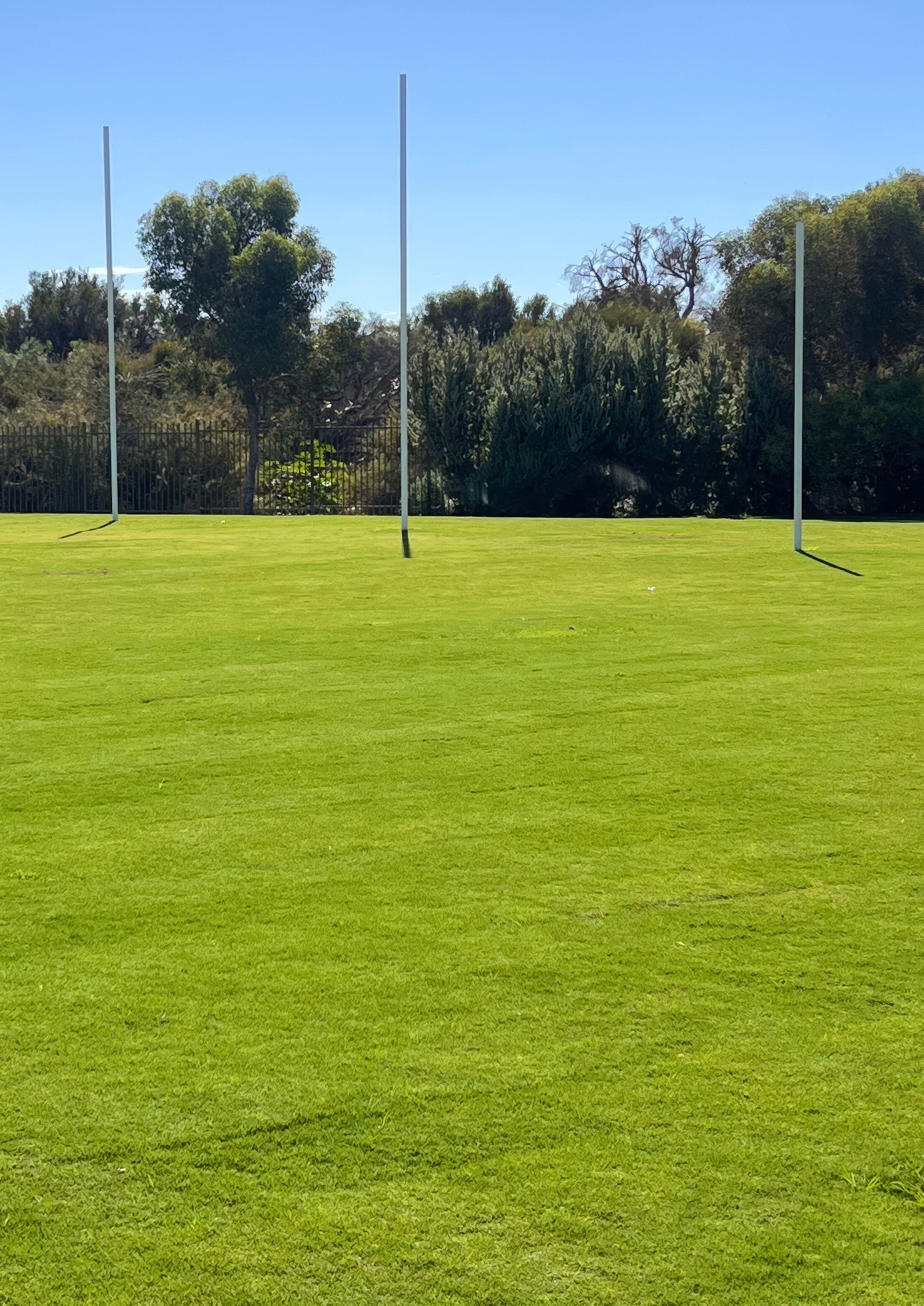
variety. An independent consultancy firm, Sports Turf Technology (STT), was bought in to work with Lawn Doctor on the process for installation and to report on what worked and what didn’t to build a basis for any possible future works using TifTuf.
One of the challenges was the watering of the new grass without impacting the water available to the rest of the school during establishment. The groundwater is plentiful, however the ground in this part of Perth is at the base of the Darling Range and is a heavy loam and clay soil. This makes the ground very tight and water extraction extremely slow. The system is comprised of a low-volume submersible within the bore which pumps into a tank of approximately 50,000 litres before a centrifugal pump delivers the water from

the tank. The challenge was to ensure the recharge of the tank was sufficient and to ensure water was available for the rest of the school grounds and garden areas. STT tested the flow rates and calculated water output and was confident the infrastructure was going to be sufficient.
Step 1. All sprinklers were lowered to 40mm below the surface utilising 300mm Articulated Risers on I25 Hunter sprinklers. Any other fittings and fixtures such as valve boxes and electrical pits were identified and marked out.
Step 2. The Field Top Maker (FTM) was bought in and set to 30mm, and the entire surface of sparse Kikuyu was removed, which took 2 days. There were challenges with the sand being loose as the two chaser trucks catching the trash material were constantly getting bogged. Areas that the FTM couldn’t reach were removed with an “Ings” pedestrian turf cutter, bobcat, or by hand. Once the surface was removed and waste stockpiled (we got around 300m3
waste) the waste was carted out by semitrailers to an approved waste facility.
Step 3. The surface was turned over with the use of a Blecovator to a depth of 220mm with sieves set at 15mm to bury any overburden or excess trash and leave a clean sand base to work with. There were three passes made in differing directions. This process revealed that stone and old asphalt rubble ranged from 5mm to 350mm below the surface in the top 220mm.
Step 4. Not being aware of the rubble previously, we needed to seek action for additional works and we subcontracted to another turf contractor to sieve the profile with a beach cleaner. This delayed the project by two days, however, the machine worked well, removing stones and debris from as small as 10mm to a depth of 300mm. In total, 45 tonnes of stone and asphalt were removed. The surface needed to remain dry for this part of the operation to allow the sand to fall through the sieves easily.
Step 5. All irrigation was tested, repairs made where required and we began the re-wetting process to get moisture down to 200mm.
Step 6. Part of the initial recommendations we made was to incorporate some organic material into the profile. This was to build organics and increase the cation exchange for nutrient holding because Sting Nematodes do not like compost. 150m3 was spread by a Marshall twin spinner evenly over the surface and was then incorporated into the top 50mm of the surface with the Blecovator.
Step 7. Levelling with a smudge board began and rolling to consolidate the surface to just leave a footprint in the soil. A Posi-track bobcat and some hard work finished off around the centre wicket, goal posts, and a few pits and valve boxes, and the ground was now ready for installation. This was completed on a Friday afternoon. Lawn Doctor set up an irrigation cycle to manage establishment watering of the freshly laid turf over the weekend to see if the equipment was up to the task. The system was set to run at 5 am, 10 am, and 3 pm to apply


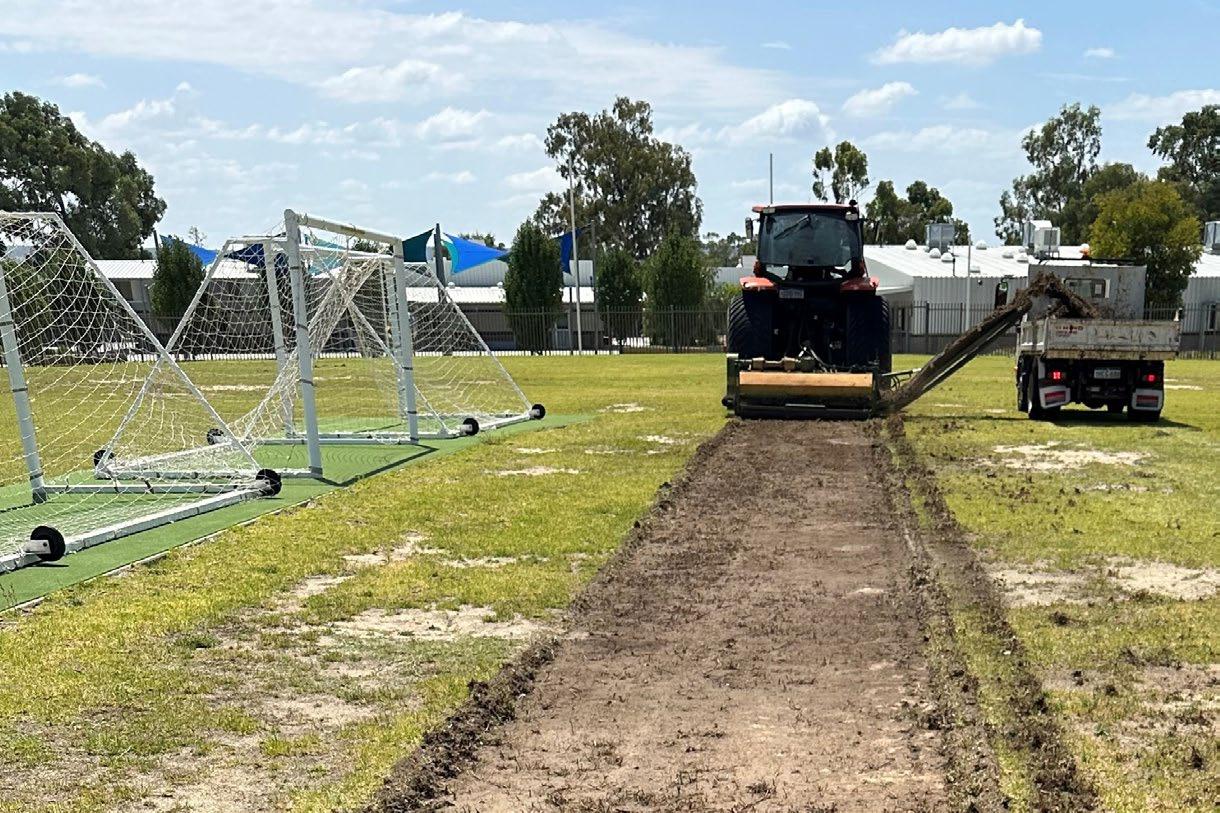
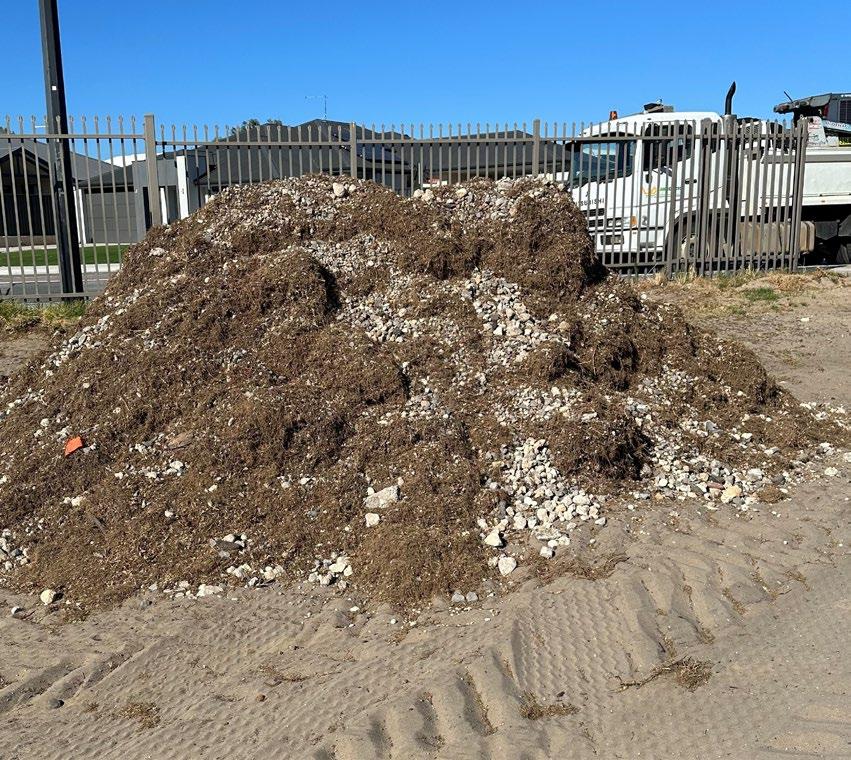
4mm at each cycle, bearing in mind it was 37- 44 degrees in February with strong hot easterly winds at the base of the escarpment where the school was situated. On Saturday morning, low-level shutoffs were found in the system and the tank was nearly dry as there was no recharge into the tank. We found a gate valve that was shut and opened it and heard water going into the tank but then realised this was scheme water, not from the bore. We had no access to the bore resets, so we let the scheme run. We shut the irrigation control system down until that evening and then set it to run again on Sunday. On Monday, we managed to get Western Irrigation in as they manage the irrigation for this site and the issue was an iron filter. Once this was rectified the bore kicked in and recharge began. We were set to start laying that week; however, Lawn Doctor did not make the final decision to install until we were convinced the water was available.
Step 8. Watering was reliable and we started bringing in the turf; we transported 3,000m2 in on the first day, 4,000m2 on day 2, and
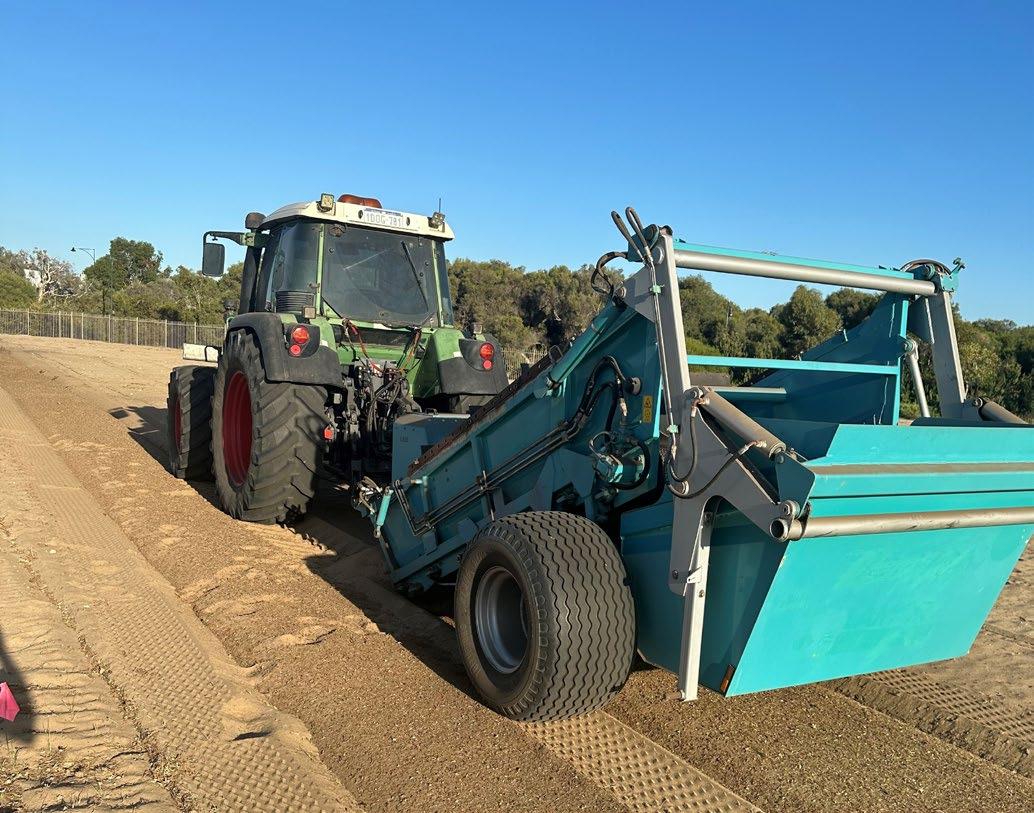

the balance of 2,700m2 on the last day. The installers from Allwest Turf had a job cancel so they had up to 15 guys laying the TifTuf in 42-degree heat directly onto the sand.
Step 9. Turf installs were completed and rolling with a twin drum roller removed any depressions. Water was set to run 3 times per day for two weeks at 30 mins per station (8 stations in total) then after 2 weeks the run times were reduced to 20mins 3 times per day. Mowing began at 20mm using a Toro fairway mower, this was completed twice per week on a Monday and Thursday. Week 5 water was reduced to twice a day for 15 minutes (still 35-degree days) and the TifTuf never looked as though it was stressed by lack of water. In week 6, we further reduced the water to 1 water per day, the grass kept growing, and mowing continued twice per week. At this point, we raised the height of the cut to 25mm which is the Department of Education’s specified height and continued mowing twice weekly.
Step 10. A fertiliser application of NPK plus Trace elements was applied at 200kg per hectare.
Water was reduced at this point to 3 times per week as per watering guidelines in WA.
After 4 weeks the oval was ready for the students and school community, however, the school Principal decided to keep it out of use until the beginning of the new term after the Easter break. The TifTuf oval is now in full use and going great, the school is very happy, and the kids are enjoying their new oval and sports activities.
Our goal is for TifTuf to be recognised as an excellent option for sports turf fields in Western Australia. We hope to use this opportunity to work with STT on building a strong case study showing how TifTuf turf can outcompete the damage caused by Sting Nematodes. This, along with its other benefits including reduced water usage and nutritional inputs, strong wear and tear, and fast establishment time, will help us to educate Local Governments and sporting facilities about the overall benefits and reliability of this grass variety, not only for the users but also for the environment.
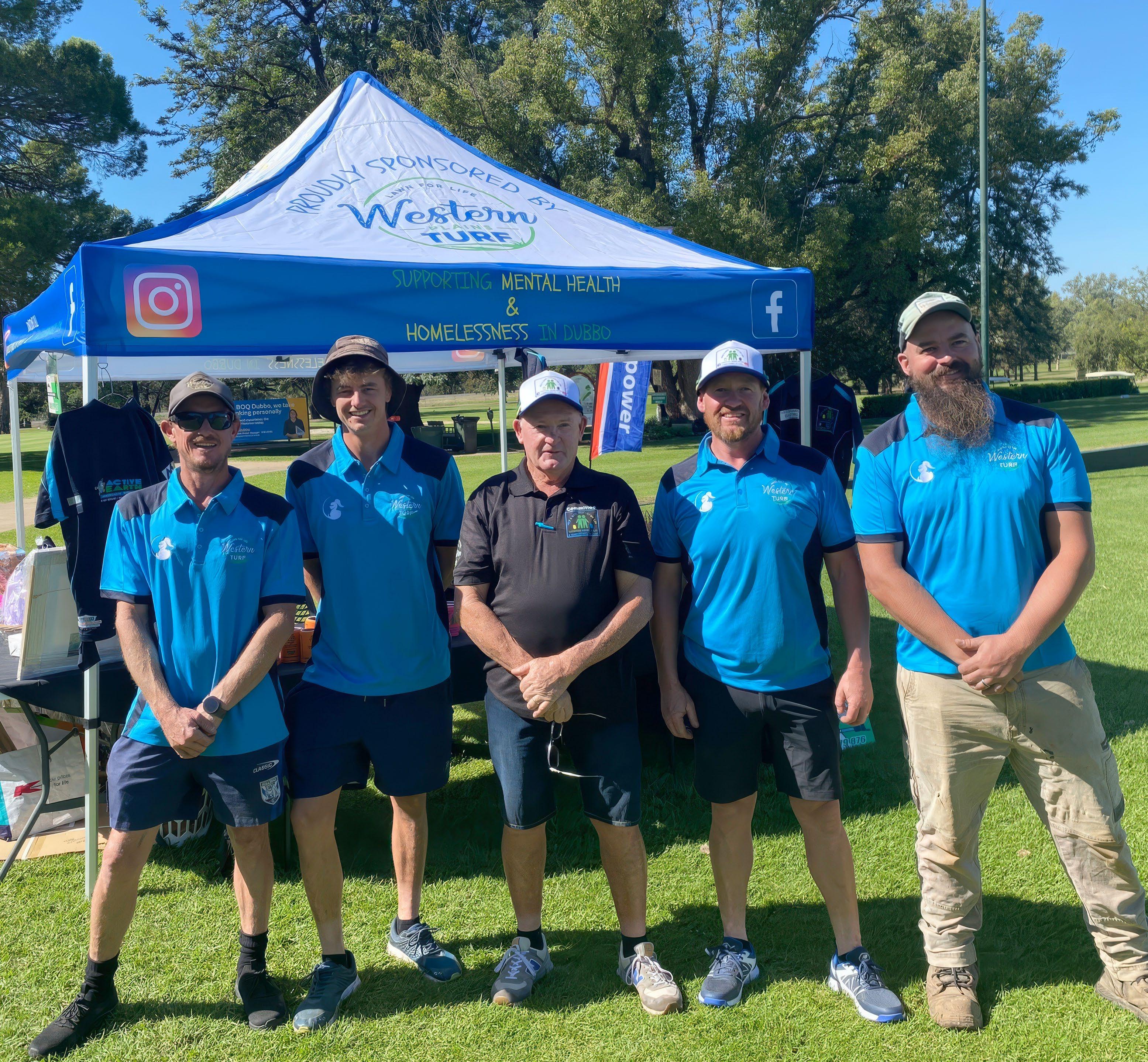
In the heart of Dubbo, Mick O’Neill, the founder of Help a Mate, orchestrated a remarkable charity golf day event to address two pressing issues: homelessness and mental health. With the generous support of Western Plains Turf, owned by Mick and his son Timmy O’Neill, the charity golf day became a beacon of hope, rallying the community for a noble cause.
One of the driving forces behind Mick’s philanthropic endeavours is his deeprooted belief in the power of community. He understands that real change begins at the
community level, where individuals come together to support one another. It’s this sense of unity that fuels Mick’s passion to make a difference.
On the day of the charity event, Help a Mate didn’t just raise funds; they ignited a conversation about mental health in the trade industry. A significant portion of the proceeds, amounting to $10,000, was donated to Tradies Insight, an organisation founded by Bruno and Jo Efoti. This contribution underscores Mick’s commitment
to supporting those in the trade and community facing mental health challenges.
It wasn’t just about a day of golf; it was about coming together as a community to support those in need. With Western Plains Turf’s support, Mick’s vision of creating a better future for everyone is becoming a reality.
The success of Mick’s charity golf day is a testament to the strength of community bonds and the collective desire to create a better tomorrow. With each swing of the club and every dollar raised, individuals

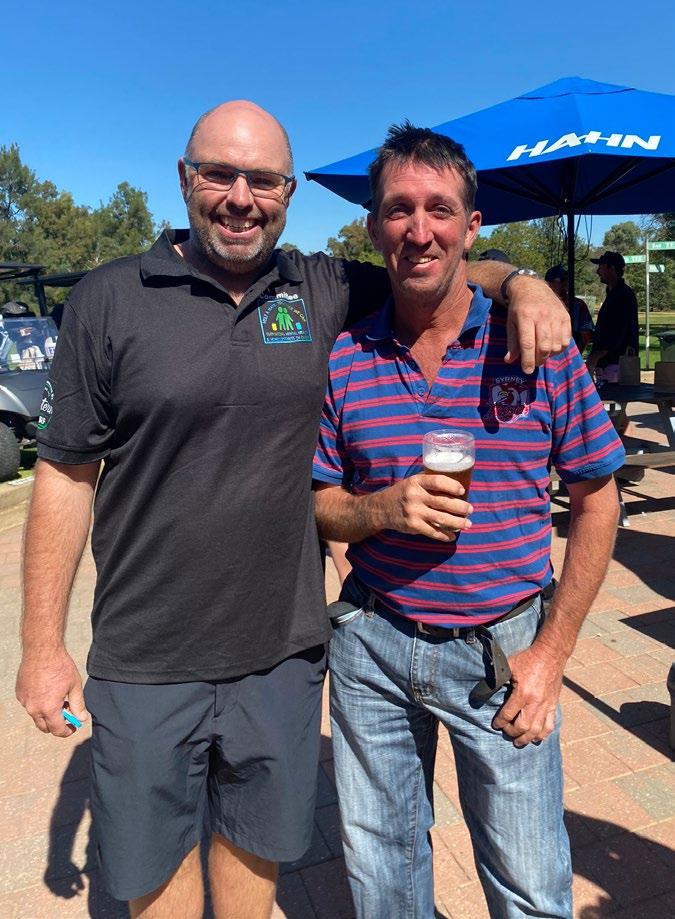

came together, united in their mission to make a positive impact.
Mick’s journey with mental health and awareness endeavours goes beyond the golf course. For the past two years, he has been on a mission, collecting cans and bottles, and transforming recyclables into funds exceeding $50,000. His dedication exemplifies the power of grassroots initiatives in driving meaningful change.
But Mick’s efforts extend far beyond raising funds; they represent a commitment
to looking after the community’s most vulnerable members. Homelessness and mental health are often overlooked issues, but Mick’s tireless advocacy sheds light on their importance. By addressing these issues head-on, Mick and Help a Mate are working to create a more inclusive and supportive community for all.
Mick’s journey didn’t start with a golf day; it began with a simple idea to help those less fortunate. In his tireless efforts to address homelessness and mental health issues, Mick’s compassion and dedication
have touched the lives of many. Whether it’s through collecting cans and bottles or organising charity events, Mick’s commitment to his community knows no bounds.
Western Plains Turf, as a major sponsor of Help a Mate, plays a crucial role in Mick’s mission. Their support not only provides financial assistance but also serves as a symbol of solidarity within the community. Together, Mick and Western Plains Turf are leading by example, showing the region what can be achieved when individuals and businesses work together for a common cause.

Clarence Valley Sports Fields Maintenance is a part of the Clarence Valley Turf Farm owned by Travis and Helen Stone, located in Seelands via Grafton NSW. The company was employed by the Richmond Valley Shire Council to refurbish parks and sports fields located in Casino and Woodburn, NSW. These areas were decimated by the floods in the Northern Rivers area in February and March 2022, having a severe effect on the sports fields in the area.
The flooding experienced in Woodburn was like nothing that had come before, it was much higher than a one-in-five hundredyear event. The residents quickly moved to higher ground, but the waters continued to rise. There were stories of some individuals having to shelter in the dark on the local bridge with the full force of flood waters surging around them, before the immense relief when a small group of boats found them and took them to safety. Woodburn
School provided shelter for hundreds of locals who waited many days for the water to recede and access roads to open again. The devastating effect of the flood was considerable, with 154 properties in Woodburn being damaged, along with community buildings, infrastructure, and local businesses pertinent to employment in the region. With damage to so many homes, Woodburn had a long journey of rebuilding in front of them. Once the


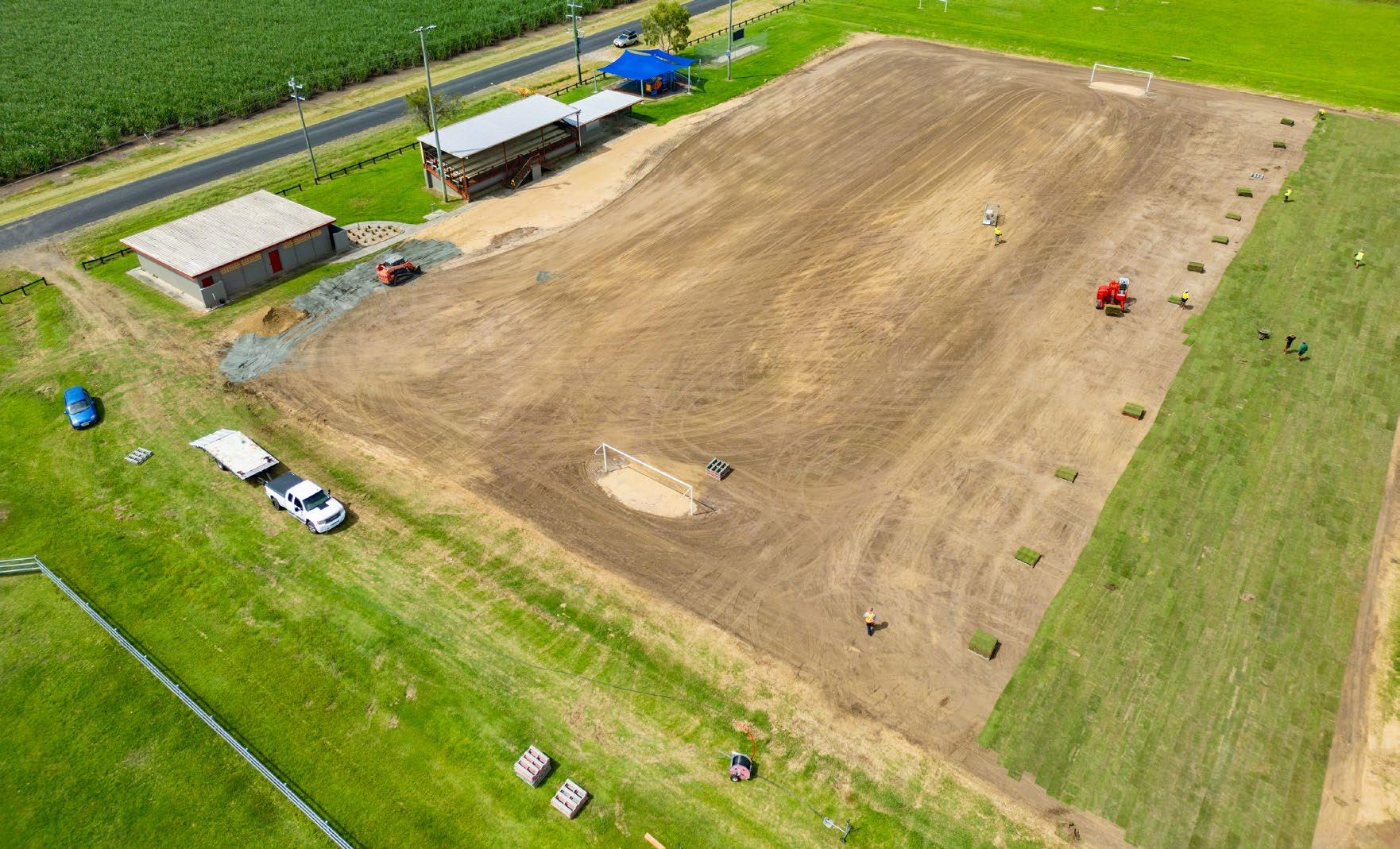
waters had receded, the council quickly established a Recovery Advisory Group to work with residents and support the recovery, along with the support of the Australian Defence Force personnel who came to help with the clean-up.
Such a large volume of water had a devastating effect on the region’s local sporting infrastructure. This inundation led to the deterioration of the playing surface at
Woodburn Oval, causing undulations, cracks and compaction issues that significantly compromised its usability. Consequently, there was a need for levelling to address these unsafe undulations and resurfacing to rectify surface imperfections, invasive weeds, and grasses to create a uniform surface. This restoration process involved the decompaction and working over of the soil profile, topdressing, slight levelling/shaping of the playing surface and laying new turf.
Woodburn flooding: Woodburn oval
Despite interruptions due to rain, the Clarence Valley Sports Field team were able to complete the preparation and repair of the soil over eight days ready for brand-new turf to be installed on the newly levelled surface. Over four days a team of turf layers installed 8,250m2 of TifTuf Hybrid Bermuda turf, bringing the field back to prime condition for residents and visitors. The


one-in-five hundred-year flood might have destroyed the sports field, but a team of qualified professionals from Clarence Valley Sports Fields Maintenance were able to bring it back to life within a matter of days.
Floodwaters also inundated the main street of Casino at Queen Elizabeth Park on Monday, February 28th, following days of incessant rainfall. Evacuations were initiated in low-lying areas as flash floods persisted, prompting the river to breach its banks. An emergency shelter was set up at Casino High School, with volunteers offering aid such as meals, warm clothing, and blankets to evacuees. As water
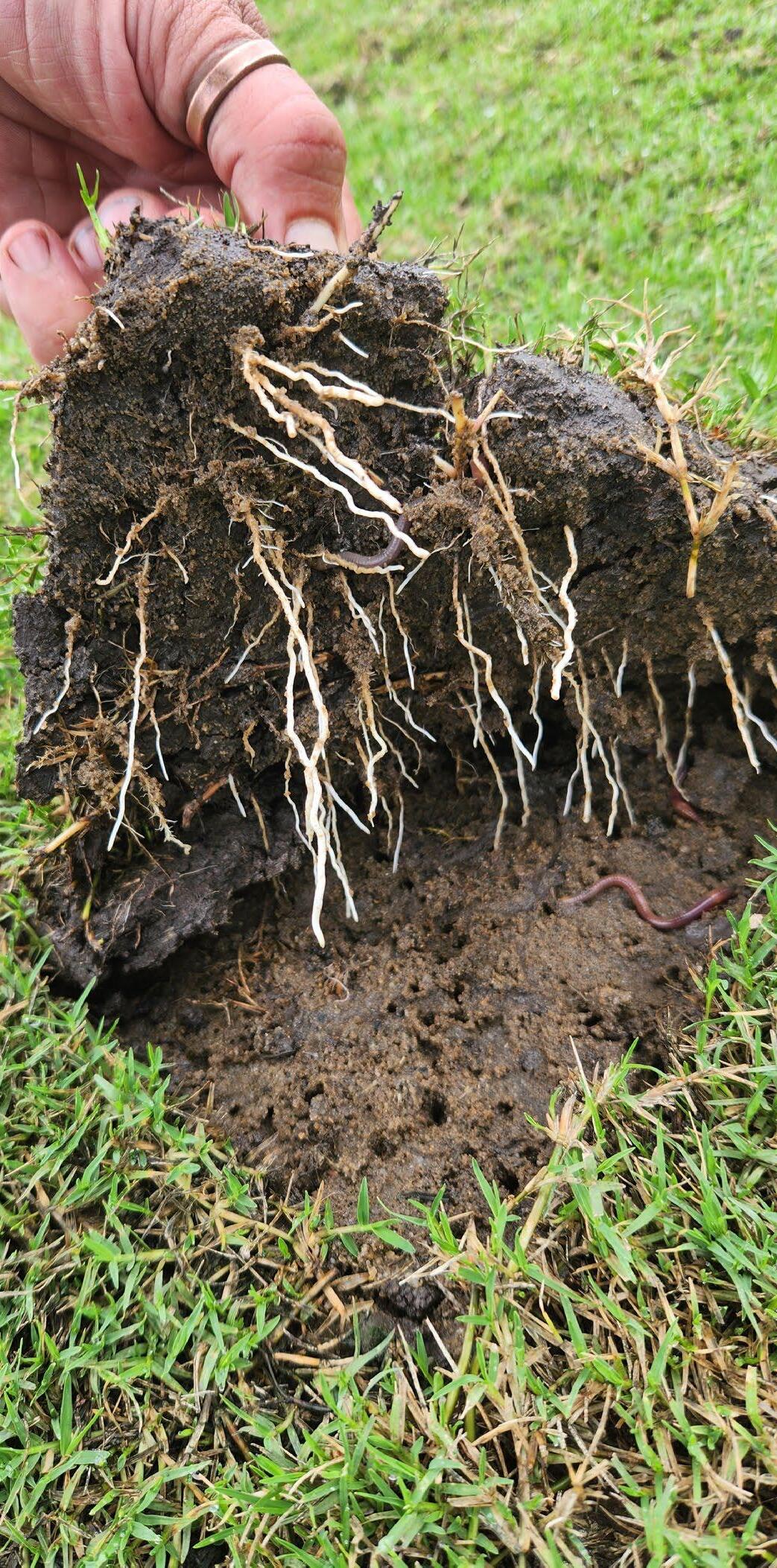
encroached upon shops along Walker Street, volunteers assisted in fortifying entrances with sandbags and relocating stock and equipment to higher ground. By Tuesday morning, water levels began to recede, revealing wandering cattle in the town, which were promptly gathered by council rangers. The subsequent cleanup commenced, with many shops reopening by Wednesday and cleanup crews removing debris from local residences. Approximately 270 properties incurred damage, along with local sports facilities, roads, and infrastructure. The force of the floodwaters resulted in severe erosion of the riverbank, uprooting trees and destroying years of habitat restoration efforts.
The remediation of Queen Elizabeth Park commenced with a request from the council for the flood-affected grass areas to be also repaired through the installation of TifTuf. Clarence Valley staff administered pre-emergent herbicides and controlledrelease fertilisers before sprigging TifTuf across an 8,500m2 area, followed by rolling and watering the park upon completion of the project.
Despite the challenges posed by the flooding across the region, the restoration efforts stand as a testament to the resilience and determination of the community, recognising the importance of rebuilding and revitalising recreational space for the community.
